Tanzania 2016 October
Photo Safari
Trip Report
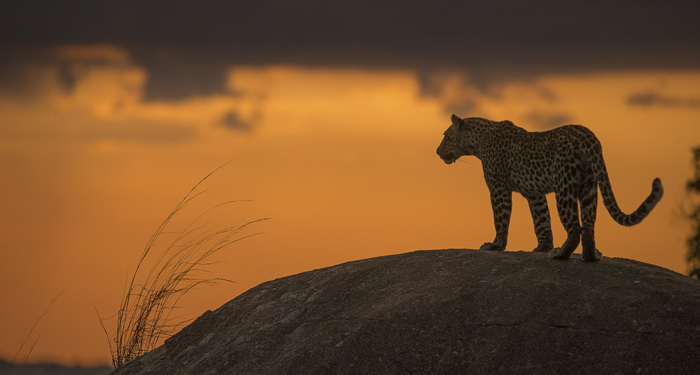
Read our Complete Trip Journals,
of our Tanzania Trips
Read our Brochure for 2018
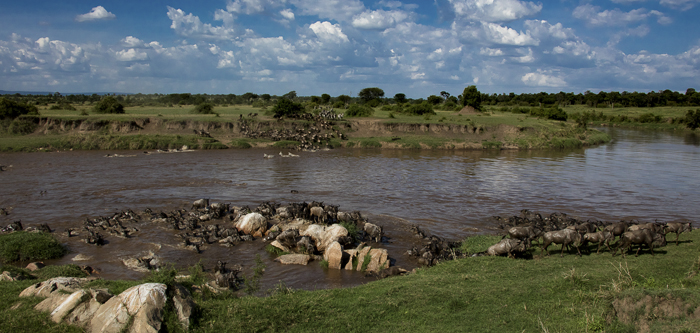 Gnu crossing the Mara River
Gnu crossing the Mara River
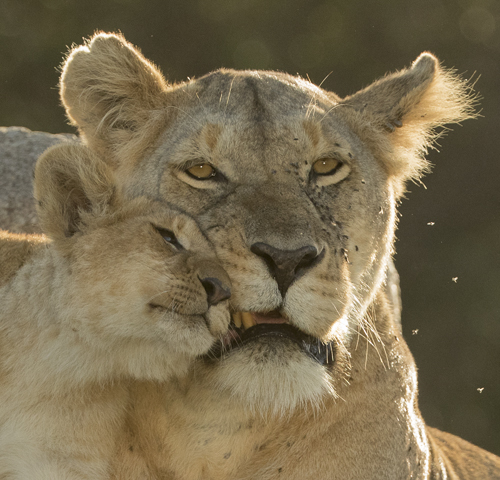
Lioness and cub, with the highlight in the eye from the
reflection of our vehicle's windows in the early morning light.
This was our third visit to Tanzania in October and once again, the Serengeti, Ngorongoro, and Tarangire National Parks did not disappoint us. I'm always amazed that just within sight of the Masai Mara border the landscape changes so dramatically, with some of the most picturesque kopjes only a short drive away. We were hoping to catch the tail-end of the Gnu migration, and indeed we did with a great river crossing on our first day, and that evening we also had an absolute first -- a pair of Leopards on a kopje at sunset, silhouetted against the orange sky of the setting sun. That day was the start of a wonderful 12 days of field work, culminating with an exciting bat shoot on our last day. The entire report follows!
Day 1 – Arusha to northern Serengeti
Everyone arrived with all their luggage over the last three days and this morning we left our hotel for an hour long flight to the upper Serengeti, where our camp is located a short distance from the Mara River. Our flight took us over Ol’ Donyo Lengai, Tanzania’s active volcano which is, at present, dormant. Although a few tufts of clouds covered the peak as we approached those dissipated as we neared, treating us to a spectacular view of this perfect cone-shaped volcano. Slabs of rock, presumably former lava sheets, and broken talus encircled the summit, where, to one side, a surprisingly small crater would lead into the bowels of the earth. To our right, Lake Natron stretched out immensely to the horizon, home to East Africa’s largest nesting colony of flamingos and now threatened by mining, which may ruin the hydrology and the birds’ necessary isolation in what is sometimes considered one of the most inhospitable landscapes on earth.
We continued to the northwest, flying over Ngorongoro Conservation Area lands, shared by Maasai herdsmen. Some of the small kraal villages, bomas that encircled several huts, were quite isolated, but almost all of these had at least one tin roof structure, rather than the traditional thatch. I was also surprised to see farm fields around some of these small villages – of wheat or corn I suspect, with dirt tracks for the trucks that would take the crops away.
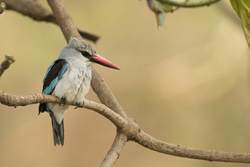 The landscape just northwest of Lengai was surprisingly mountainous and rugged, with steep, rocky canyons that I didn’t expect to see. I could imagine a nomadic lion traveling through these areas as it sought a pride territory of its own, and how foreign that landscape could be for a lion raised on the plains of the Serengeti. The mountains extended northward towards Kenya, and quite far off our pilot pointed out Kline’s camp’s ridge, giving some scale to the immense distances involved.We continued northwest, entering the grasslands where, in patches, the land below us was surprisingly green. August had been a very dry month, but September was wet, and it showed, and as we neared our landing strip the grasslands were green. After we landed, met our drivers – who had driven out the day before with most of our luggage, and squared away our camera gear, we started what we planned on being a short game drive back to camp. With short, bright green
The landscape just northwest of Lengai was surprisingly mountainous and rugged, with steep, rocky canyons that I didn’t expect to see. I could imagine a nomadic lion traveling through these areas as it sought a pride territory of its own, and how foreign that landscape could be for a lion raised on the plains of the Serengeti. The mountains extended northward towards Kenya, and quite far off our pilot pointed out Kline’s camp’s ridge, giving some scale to the immense distances involved.We continued northwest, entering the grasslands where, in patches, the land below us was surprisingly green. August had been a very dry month, but September was wet, and it showed, and as we neared our landing strip the grasslands were green. After we landed, met our drivers – who had driven out the day before with most of our luggage, and squared away our camera gear, we started what we planned on being a short game drive back to camp. With short, bright green 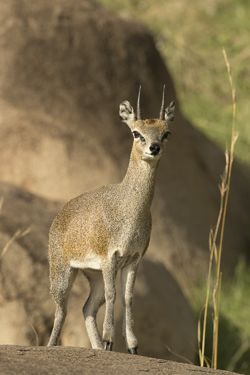 grasses now carpeting the land, the area seemed almost too park-like, too much like a zoo. On the positive side, if we happen to have a cheetah hunt here, we will see everything.Although we planned on getting to camp early to unpack and organize, Gnus had gathered at the Mara River as if to cross. We stationed ourselves a few hundred yards from the river, the procedure now used so as to not interfere with a crossing. Once a crossing begins, the vehicles move in, and usually the Gnus at that point are oblivious to vehicles – they just want to cross. I explained the dynamics of the Gnu migration to Ken and Mary (not MY Mary) who were in my vehicle, and how the herds move in a clockwise direction from the Mara, SE to the lower Serengeti, and N by NW back up again. People think the migration requires a river crossing, but it does not, if the herds travel east of the Mara River or Grumeti. The Gnu migration is not like a bird migration with a definite starting point and ending point, as Gnu herds may cross and recross a river several times. We’ve seen herds cross the Mara River, then turn around and go back the way they came. We’ve seen one herd crossing one way, and nearly colliding with another herd going in the opposite direction. There seems to be no logic involved.
grasses now carpeting the land, the area seemed almost too park-like, too much like a zoo. On the positive side, if we happen to have a cheetah hunt here, we will see everything.Although we planned on getting to camp early to unpack and organize, Gnus had gathered at the Mara River as if to cross. We stationed ourselves a few hundred yards from the river, the procedure now used so as to not interfere with a crossing. Once a crossing begins, the vehicles move in, and usually the Gnus at that point are oblivious to vehicles – they just want to cross. I explained the dynamics of the Gnu migration to Ken and Mary (not MY Mary) who were in my vehicle, and how the herds move in a clockwise direction from the Mara, SE to the lower Serengeti, and N by NW back up again. People think the migration requires a river crossing, but it does not, if the herds travel east of the Mara River or Grumeti. The Gnu migration is not like a bird migration with a definite starting point and ending point, as Gnu herds may cross and recross a river several times. We’ve seen herds cross the Mara River, then turn around and go back the way they came. We’ve seen one herd crossing one way, and nearly colliding with another herd going in the opposite direction. There seems to be no logic involved.
At any rate, the herd teased us several times, coming down to the river or running along, further to the west, requiring us to do a long round-about to follow, then turning, and running eastward, and another chase. By 1PM, however, the herds had turned inland, and a crossing seemed unlikely. We headed to camp for lunch, and to unpack and get settled before the afternoon game drive.
PM. It was hot and sultry through the afternoon, remaining so as we started the game drive at 3:30PM. By 4:30 the heat had broken and the drive was pleasant, as we fruitlessly followed gnus along the Mara River, herds that refused to cross and that would eventually wander back into higher country. We photographed a Marshal Eagle immature feeding upon a Thompson’s Gazelle while sitting in what looked like an old secretary bird nest – I didn’t think an eagle would choose a nest that low, but sec birds would use one just like this. We continued on, to Kogatende Kopjes where we photographed a few Klipspringers perched on boulders and Rock Hyrax hopping about. Another driver told our guides that Cheetahs were nearby, and we headed there, to find two males lounging a short distance off the track. They were doing nothing except an occasional roll, so it was an easy call to leave when we heard that two Leopards had been spotted.
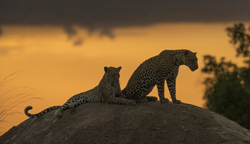 We raced to the kopjes to find one Leopard lying in a Sphinx position atop a boulder, while its sibling stood on another rock on the opposite side of the track. Over the next hour we stayed with the Leopards, shooting them at eye-level as a cat sat facing us, or when the two met atop the highest boulder. One replaced the other there, where it remained as the sun set behind it, giving us incredible silhouettes of the cats against the orange sky.
We raced to the kopjes to find one Leopard lying in a Sphinx position atop a boulder, while its sibling stood on another rock on the opposite side of the track. Over the next hour we stayed with the Leopards, shooting them at eye-level as a cat sat facing us, or when the two met atop the highest boulder. One replaced the other there, where it remained as the sun set behind it, giving us incredible silhouettes of the cats against the orange sky.
We left just as the sun disappeared, and drove fast to reach camp, around 7:15, in the dark. Bill’s vehicle had 15 lions as well, for a three cat afternoon.
Day 2. Northern Serengeti.
We had a 5:30am cooked breakfast and loaded in the dark for our 6AM game drive. Two of our vehicles followed the river route for a short time, looking for lions, while my vehicle and Bill’s headed directly to the kopjes. We arrived at the kopjes just after sunrise, and circled about the nearest outcrops looking for lions. Finding none, we continued to the area we had seen the leopards yesterday.
 I found a Spotted Eagle Owl perched on a rock fairly close to the road, providing clear views although the bird never fully opened its eyes. Bill’s vehicle found the lions, as many as ten, mostly cubs, scattered on the rocks and in the grasses below the kopjes, and although the older cubs were playing they soon moved back to the rocks. We continued, finding the male Leopard, which provided only a few brief shots before climbing a rock and disappearing into the brush on top.
I found a Spotted Eagle Owl perched on a rock fairly close to the road, providing clear views although the bird never fully opened its eyes. Bill’s vehicle found the lions, as many as ten, mostly cubs, scattered on the rocks and in the grasses below the kopjes, and although the older cubs were playing they soon moved back to the rocks. We continued, finding the male Leopard, which provided only a few brief shots before climbing a rock and disappearing into the brush on top.
My vehicle continued on, heading towards the Cheetah area, but we were called back as the youngest cubs and Lioness were now drinking. We arrived back in record time, and stayed with the family as they traveled around a half mile, through rocks, crossing a lugga, passing through more rocks, before finally settling in the shade of a fig tree on top of another kopje. I was surprised to find the Lioness leaving the security and company of the rest of the pride to travel as far as she did.
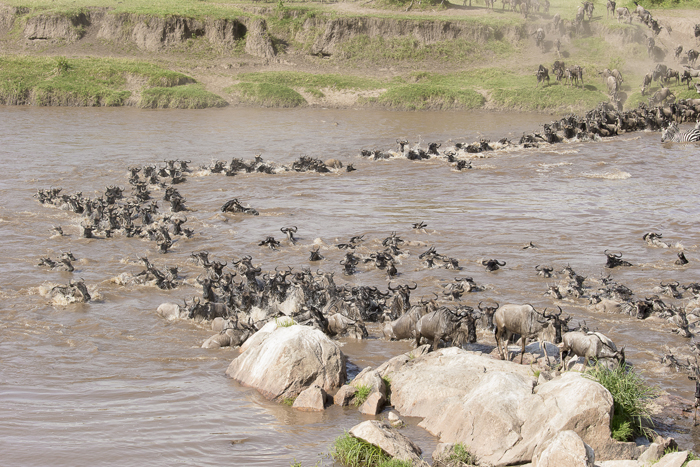
We headed towards the Mara River, hoping for a river crossing. While we had a ‘coffee break’ under a tree Gnus gathered, and began to cross. We left our set-up table, coffee, eggs, and bananas on the table as we raced to the 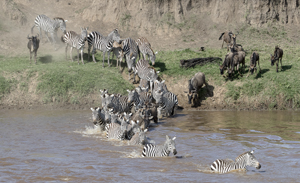 river, arriving in time to catch most of the crossing. Although Gnus had started the crossing, Zebras finished it, and when they stopped, the two dozen remaining Zebras moved up stream, and they, too, crossed. We were right at that crossing, and had Zebras racing up the river bank right in front of us.
river, arriving in time to catch most of the crossing. Although Gnus had started the crossing, Zebras finished it, and when they stopped, the two dozen remaining Zebras moved up stream, and they, too, crossed. We were right at that crossing, and had Zebras racing up the river bank right in front of us.
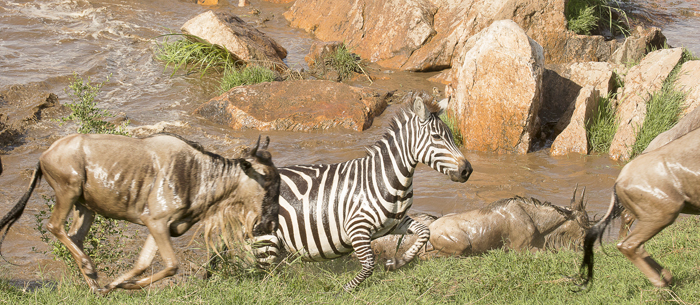
We continued on, seeing another Gnu crossing far upstream, and then headed back towards camp, arriving around noon. Along the way back some of our vehicles photographed more birds and hippos, for a very complete day.
PM. We left at 3:30, and just leaving camp we saw a large concentration of Gnus downriver from us. The herds were, as usual, racing back and forth, but seemed concentrated downriver and we headed that way, skirting a large lugga to do so. En route, Mary’s vehicle was charged by a Buffao, which they easily eluded, and the same Buffalo charged another vehicle a few minutes later.
Meanwhile, we had just rounded the lugga when the herd exploded into the water, and we arrived while the first animals were just beginning to swim across. A few hundred Gnus crossed, forming a U shape as they were pushed downstream and then arched back up, and about a dozen died in the attempt. The crossing stopped, but a few minutes later the Zebras renewed it, and we had a second chance at more shots – with our vehicles right at the exit points as Gnus and Zebras rushed up the bank and galloped by.
We continued upriver, looking for more crossings, then headed inland where several Elephants mud-bathed near to the road, but wandered off as we 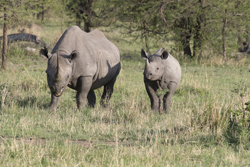 neared. Englebert said the Black Rhinos had been seen and we headed in that direction, discovering their difficult-to-see shapes in the croton bushes. After some futile attempts to see them, I suggested we just back off and wait, and let them come out and come to us. Following our lead, the other safari vehicles did likewise, and a short time later the Rhinos emerge, a mother with a long, sharp horn, and a baby half her size with the beginning of a horn.
neared. Englebert said the Black Rhinos had been seen and we headed in that direction, discovering their difficult-to-see shapes in the croton bushes. After some futile attempts to see them, I suggested we just back off and wait, and let them come out and come to us. Following our lead, the other safari vehicles did likewise, and a short time later the Rhinos emerge, a mother with a long, sharp horn, and a baby half her size with the beginning of a horn.
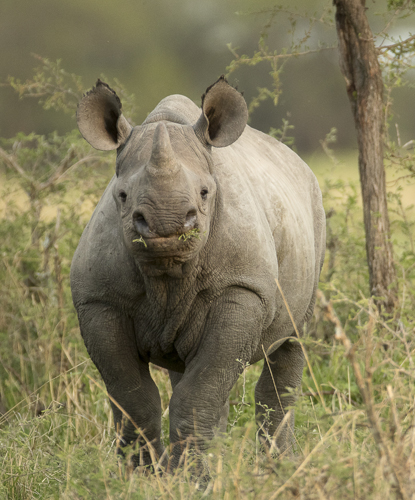 We followed them as they moved across the grasslands, keeping our distance and keeping the Rhinos relaxed. Eventually they came to an open field to browse where NOMAD Safari vehicles, filled with Chinese tourists with cell phones or pads, crowded in close, actually cutting off the view of our four vehicles. Fortunately, as the Rhinos circled around them they stayed put, and we were finally able to shoot, but we were very annoyed at the obnoxious behavior.
We followed them as they moved across the grasslands, keeping our distance and keeping the Rhinos relaxed. Eventually they came to an open field to browse where NOMAD Safari vehicles, filled with Chinese tourists with cell phones or pads, crowded in close, actually cutting off the view of our four vehicles. Fortunately, as the Rhinos circled around them they stayed put, and we were finally able to shoot, but we were very annoyed at the obnoxious behavior.
When the Rhinos wandered away from us we departed as well, but found little and so, on our return to camp, we spent the last light of the day with the Rhino pair again, where both mother and calf now grazed, undisturbed (the vehicles were a respectful distance) and in good view. We arrived in camp at dusk, after sunset but still with enough light to unpack and walk back to our tents in the light.
Day 3. Northern Serengeti.
We packed the vehicles before breakfast, allowing us to leave promptly on time at 6AM. As we drove east the eastern sky was a deep pink and various trees silhouetted nicely, but without enough of a sense of locale to justify a stop. I was hoping for elephants or giraffes, but the color dissipated without a subject for a shot.
Two Topi mothers with young calves ran across the horizon, the calves pronking, reminding me of a hobby horse or a pogo-stick, while the adults just kept stride in a normal gait. Although silhouetted against the horizon their direction was too erratic, and the duration too brief, to try catching that.
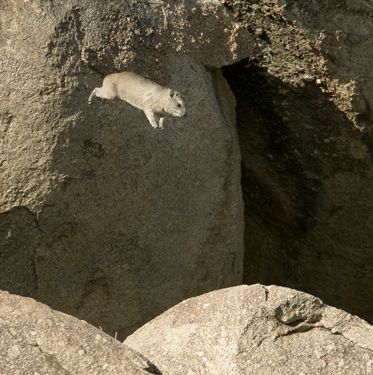 We traveled through the kopje area early, where some of the vehicles had Klipspringers and Hyrax. I was on a lower route and had a Tawny Eagle that we suspected was hunting tree agamas, as the bird craned its neck and flew around the tree, finally landing close to us before a final flight to a branch, which we caught, and then off, lizard-less
We traveled through the kopje area early, where some of the vehicles had Klipspringers and Hyrax. I was on a lower route and had a Tawny Eagle that we suspected was hunting tree agamas, as the bird craned its neck and flew around the tree, finally landing close to us before a final flight to a branch, which we caught, and then off, lizard-less
We spotted a distant vehicle parked in a swampy area, and upon investigating found a young Leopard, the newest cub of the mother of the two Leopards we had two days ago. This young Leopard was shy, and ran off quickly. Unfortunately, Chinese tourists using NOMAD safaris didn’t care, and repeatedly went after the Leopard. At one point the cat ran across a broad open area, where it’d have been easily seen, and probably chased and killed, by lions, but luckily it made it to some brush. The NOMAD safari driver responsible for flushing the cat still followed, but either the cat stayed hidden, or they had enough of a view, that they finally departed. I wanted my driver to approach their vehicle – I was prepared to give the tourists a lecture, informing them of the danger to the cat (they probably didn’t have a clue) and to lecture the driver, but my driver/guide suddenly went deaf and didn’t budge. Empathizing with his predicament – not angering fellow drivers – I didn’t press it, but I was disappointed with him.

At lunch, with one of our other drivers present, I explained how ‘not getting involved,’ and not standing up for what was the correct thing to do can be so hurtful to the tourist industry. Had that leopard been killed by a lion, there’s no doubt that that news would be all over the internet, and the Serengeti officials would know, and that there would probably be increased patrolling, and less freedom of movement, as a result. Whether the speech made any difference …. To Mary’s credit, when other NOMAD drivers went by, she did chew them out about the actions of their colleague, and told them they should have radioed him, and stopped him from harassing the leopard.
We continued east, and at one point we were approximately 15 miles from our camp here, and 14 miles from Keekorok Lodge and Mara Serena Lodge in Kenya. We found a pride which I suspect was newly taken over, with three males – one full blond, another dark maned with a less impressive mane, and another fully maned, dark coated, and four Lionesses, with one subadult Lioness. No subadult males, and about a half mile away we found another Lioness, with new born cubs under two weeks old – probably the trio’s first litter. The cubs were vocal, sounding often like chirring birds, at other times yelping, as they scrambled over the mostly hidden lioness.
At 11:30 we headed for home, and the trip, only 15 miles straight, still required an hour’s drive.
PM. After leaving camp we turned and headed upriver, and within minutes had an Elephant in the river, crossing to join the herd on the opposite side. We arrived too late for mid-river shots, but Sherry and Tom had the scene as the afternoon highlight, as the Elephant scrambled up the bank, bending its forelegs to lower itself enough that its knees could gain ground, and by kneeling, crawl up the bank.
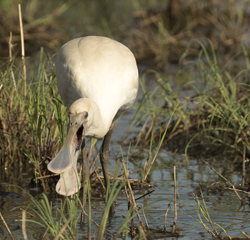 We drove slowly, stopping for a front-view of a large Leopard Tortoise, and later, for two African Spoonbills and a small flock of Sacred Ibis – the latter being at the same pond for the last several days. We found the mother Black Rhino and baby again, but they were poorly backlighted and somewhat distant, but the first Tom had seen so the stop was worthwhile. We continued on to a reported Gnu river crossing, but the animals turned from the river and we headed back to the Rhinos, hoping that they had come closer to one of the roads.
We drove slowly, stopping for a front-view of a large Leopard Tortoise, and later, for two African Spoonbills and a small flock of Sacred Ibis – the latter being at the same pond for the last several days. We found the mother Black Rhino and baby again, but they were poorly backlighted and somewhat distant, but the first Tom had seen so the stop was worthwhile. We continued on to a reported Gnu river crossing, but the animals turned from the river and we headed back to the Rhinos, hoping that they had come closer to one of the roads.
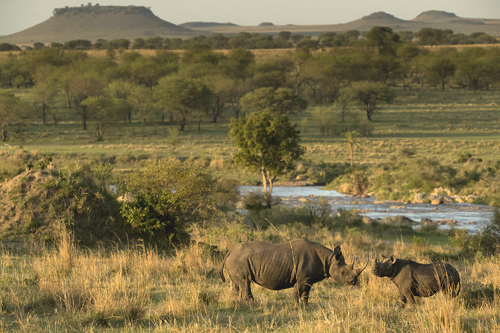
They had, and we had a wonderful session where the Rhinos were framed against the Mara River and the distant, plateau-like buttes of the lower Masai Mara. The light was soft but direct, and the scene looked like a painting, again, one of the photo highlights for the trip.
As we headed back to camp several of us stopped at some trees for a sunset, before continuing and arriving at camp at 7PM.
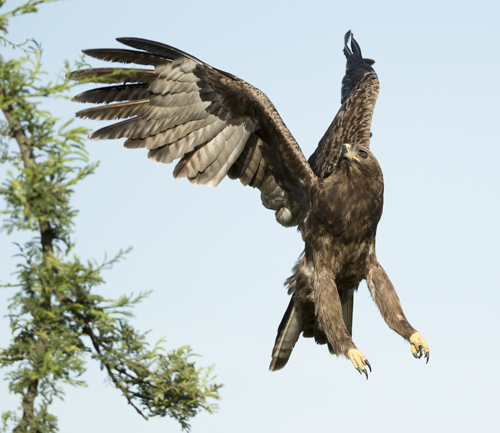 Day 4. Northern Serengeti
Day 4. Northern Serengeti
We followed the same schedule, leaving at 6AM and heading towards the kopjes. We hadn’t traveled too far from camp when we found two four year old males, nomads—I suspect, lying in Sphinx-poses beside the road. One was a blond mane without a trace of dark hair, while the other was surprisingly dark, although both sported the size mane typical of that age.
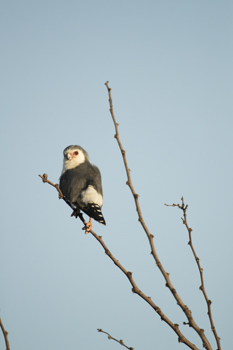 The sunrise was eye-achingly brilliant, without humidity, but we found some trees to silhouette as the sun climbed over one of the hills. Continuing on, my vehicle had a nice Topi overlooking the rock-strewn kopje fields, and a Pigmy Falcon perched close to the road. We headed towards where, in the past, we had an Elephant Shrew. It wasn’t there, but Mary’s vehicle spotted one. While we were looking, Tom’s vehicle found one of the two Leopard cubs. The cat crossed in front of them, and then went into a kopje where my vehicle encountered it, climbing down from a rock and resting in a crevice where it gnawed at portions of a Gnu.
The sunrise was eye-achingly brilliant, without humidity, but we found some trees to silhouette as the sun climbed over one of the hills. Continuing on, my vehicle had a nice Topi overlooking the rock-strewn kopje fields, and a Pigmy Falcon perched close to the road. We headed towards where, in the past, we had an Elephant Shrew. It wasn’t there, but Mary’s vehicle spotted one. While we were looking, Tom’s vehicle found one of the two Leopard cubs. The cat crossed in front of them, and then went into a kopje where my vehicle encountered it, climbing down from a rock and resting in a crevice where it gnawed at portions of a Gnu.
We heard a Baboon was approaching, and the Baboon suddenly appeared, causing the Leopard to race across the rocks, with the male Baboon bounding in pursuit, sometimes being within 15 feet of the fleeing Leopard. The Leopard ran for at least 100 yards before the cat ducked into vegetation and safety.
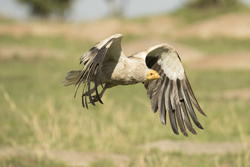 We continued on to where the kopje Lion pride had a Gnu kill. Lions were scattered around on the rocks, and we circled around, looking for shots. Vultures gathered at one of the kills – apparently there were two, and one was an Egyptian Vulture, a very rare species here in the Serengeti. This species is known for cracking Ostrich eggs by smashing the eggs with a stone it tosses with its beak, one of the very first birds to be known to use tools.
We continued on to where the kopje Lion pride had a Gnu kill. Lions were scattered around on the rocks, and we circled around, looking for shots. Vultures gathered at one of the kills – apparently there were two, and one was an Egyptian Vulture, a very rare species here in the Serengeti. This species is known for cracking Ostrich eggs by smashing the eggs with a stone it tosses with its beak, one of the very first birds to be known to use tools.
We drove to the plains where we had the Lions yesterday. Along the way, I thought I saw a movement, like a tail flashing above the grasses. I kept watching and through the intervening trees I saw another flash. I had my driver back up, and a minute or so later the back of a cat appeared. Leopard or Lion? Watching longer, I saw that it was a Lioness, and she had her head 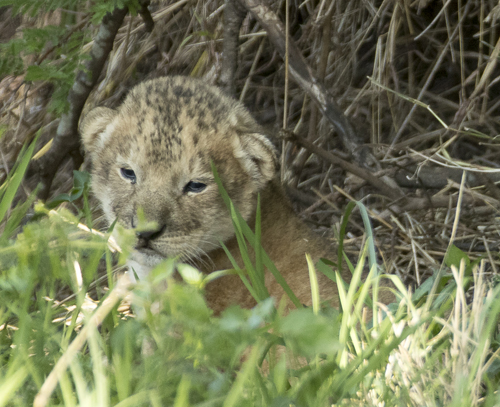 down, as if nuzzling or smelling. I suspected she had cubs, and when Mary arrived, she confirmed my view – the Lioness was nursing. We continued watching, trying to make sense of this, when she disappeared. My vehicle drove over, and I spotted two tiny cubs, probably under 2 weeks old and with their eyes barely open, and unfocused. We got some shots, as did all of our other folks, all streaming in from the radio call.
down, as if nuzzling or smelling. I suspected she had cubs, and when Mary arrived, she confirmed my view – the Lioness was nursing. We continued watching, trying to make sense of this, when she disappeared. My vehicle drove over, and I spotted two tiny cubs, probably under 2 weeks old and with their eyes barely open, and unfocused. We got some shots, as did all of our other folks, all streaming in from the radio call.
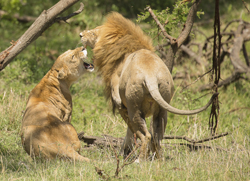 We continued on for a coffee break, then headed back, where we had another encounter with yesterday’s Lion pride, and had two matings in 20 minutes. Yesterday, a lion pair mated once, and I suspect that the pair had just begun. Today, I suspect, the heat was intensifying. Mating couples often separate themselves from the pride, or perhaps simply stay put, mating, while the pride moves on, and during the five days or so of the honeymoon the pair rarely eat. These two were full, and I suspect the kill from yesterday was their last for the next few days.
We continued on for a coffee break, then headed back, where we had another encounter with yesterday’s Lion pride, and had two matings in 20 minutes. Yesterday, a lion pair mated once, and I suspect that the pair had just begun. Today, I suspect, the heat was intensifying. Mating couples often separate themselves from the pride, or perhaps simply stay put, mating, while the pride moves on, and during the five days or so of the honeymoon the pair rarely eat. These two were full, and I suspect the kill from yesterday was their last for the next few days.
As we headed towards home, I spotted a Wattled Plover nesting right beside the game track. Close enough for frame-filling shots. The drive back took an hour, with one stop when some shot a crèche of baby Giraffes, all lying on the ground, resting.
PM. We left at 3:30PM, driving directly to the kopje area where we expected most of the activity. Mary’s vehicle went to the Kuria Kopjes, exploring, and ended up the only vehicle in that area. They had great luck, with a Martial Eagle close up with a Rock Hyrax kill, a very good Elephant Shrew, and some Klipspringers. My vehicle worked the normal kopje area, 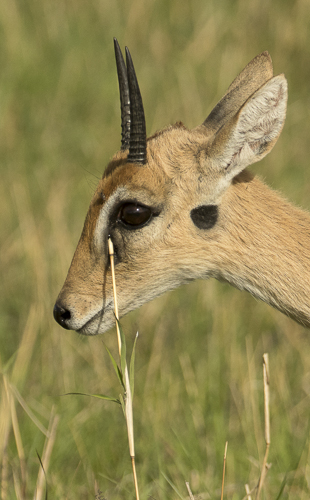 where we spent time with a family of Klipspringers and three Oribi antelope, with the ram scent marking via his preorbital gland. The ram would bite off a stem, eating the top, and leaving a thicker stem that he would insert into the gland. Thompson’s Gazelles just find a likely stem and poke their gland – the Oribi fashioned theirs.
where we spent time with a family of Klipspringers and three Oribi antelope, with the ram scent marking via his preorbital gland. The ram would bite off a stem, eating the top, and leaving a thicker stem that he would insert into the gland. Thompson’s Gazelles just find a likely stem and poke their gland – the Oribi fashioned theirs.
At the same swampy lugga where we had the shy young Leopard two mornings ago we heard Vervet Monkeys giving a variety of alarm barks. Some of the calls were the usual ‘chak-chak-chak’ bark, but there was higher pitched, nearly chirping calls too, and I couldn’t be sure if that was just the alarm notes of immature monkeys, or a different warning. I suspected python, but regardless of our search, we found neither leopard or python.
We continued to the kopjes where we had the young Leopard this morning, and found him resting on some boulders beneath a bush, the possible location where he hid from the Baboons. He groomed and eventually rose, walking between vehicles before coming to rest on another boulder. We waited, expecting him to rise, when we received a call that Lion cubs were about.
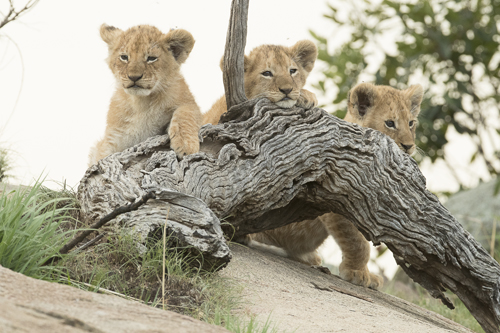
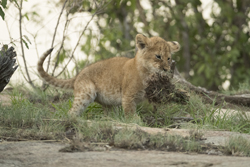 From our vantage I could see the cubs and they were the three young ones from yesterday morning. By the time I arrived our other vehicles were in great locations, but the two that were there first, for nearly 30 minutes, graciously moved out so that we could get some shots. The light was getting low so I did more video than stills, but David fired away (as did I) and everyone should have some great shots. Ken, Sherry, and Mary (not my Mary) were there first, and had calendar-like shots of the three small cubs draped over a weathered stump, all lined up staring at the camera.
From our vantage I could see the cubs and they were the three young ones from yesterday morning. By the time I arrived our other vehicles were in great locations, but the two that were there first, for nearly 30 minutes, graciously moved out so that we could get some shots. The light was getting low so I did more video than stills, but David fired away (as did I) and everyone should have some great shots. Ken, Sherry, and Mary (not my Mary) were there first, and had calendar-like shots of the three small cubs draped over a weathered stump, all lined up staring at the camera.
Storm clouds moved in from the east as we headed home, at speed, as it was nearly dark. We arrived back at camp at 7PM, and 15 minutes later the storm hit camp, and although the storm sounded wild and furious, little rain fell and by dinner, at 8PM, the skies were clearing, with lightning streaking the far western horizon.
Day 5. Northern Serengeti to Sametu, Central Serengeti
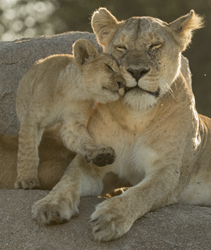 We packed up before breakfast and had an on-time departure, around 6:15 for an all-day game drive to our next destination. We headed directly to the Kopjes, hoping to find the leopard and lion cubs. We got both. We were photographing birds when we had the radio call that the cubs were found. We arrived as they were advancing to a thicket of croton bushes, but fortunately the Lioness climbed on top of a rock, followed by the cubs.
We packed up before breakfast and had an on-time departure, around 6:15 for an all-day game drive to our next destination. We headed directly to the Kopjes, hoping to find the leopard and lion cubs. We got both. We were photographing birds when we had the radio call that the cubs were found. We arrived as they were advancing to a thicket of croton bushes, but fortunately the Lioness climbed on top of a rock, followed by the cubs.
She seemed to be facing away from the sun, and I felt that a back-lighted image would be more impressive than over-the-shoulder light, so I had our guide drive accordingly. A great  choice, as the Lioness was completely in the open, facing us, and soon joined by the cubs. Our vehicle’s glass acted like a reflector and bounced sunlight onto the lioness and cub, who was framed by dark vegetation. One of the photo highlights of the trip.
choice, as the Lioness was completely in the open, facing us, and soon joined by the cubs. Our vehicle’s glass acted like a reflector and bounced sunlight onto the lioness and cub, who was framed by dark vegetation. One of the photo highlights of the trip.
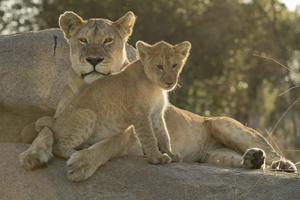
We continued on, looking for the male Leopard, and found the cub lying in a small depression atop some rocks. We only had head shots before he finally moved off, and we did too. Mary’s vehicle headed to the airstrip for our park permit, while my vehicle went to the river to scout for gnu crossings. We did find two Hippos that were either mating, or were simply playing, as they began by mouthing each other with wide-open jaws, then appearing to be in a mating position – although they looked too young to be a dominant pair.  In Hippo society, one bull Hippo controls a harem of cows, and the bull would not tolerate mating with subordinate males. I suspect that a female that was fertile produces some sign, pheromones perhaps, that alerts the male. Consequently, if the pair we watched were indeed two sexes, their immaturity and non-fertility allowed mating-like behavior. I do think, however, that they were simply two young males sparing.
In Hippo society, one bull Hippo controls a harem of cows, and the bull would not tolerate mating with subordinate males. I suspect that a female that was fertile produces some sign, pheromones perhaps, that alerts the male. Consequently, if the pair we watched were indeed two sexes, their immaturity and non-fertility allowed mating-like behavior. I do think, however, that they were simply two young males sparing.
We drove to the area where we had the mating Lions yesterday, which I missed, but Mary’s vehicle, coming from a different direction, had the Lions, including a male dragging a Gnu carcass. From there we continued southeast, stopping to photograph European Bee-eaters, Swallows, sparring Common Zebra, aerial perspectives on the herds and Elephants, Elephants coming to water to drink, baby Giraffes, a sighting of an African Hawk-Eagle, and a long, long drive towards camp.
 At the end of the day, close to our camp at Sametu, Mary’s vehicle, in the lead, spotted a Lioness carrying what they first thought was a cub, with another Lioness following behind. It was not a cub, but a baby Thompson’s Gazelle, which the Lioness carried into high grass. I arrived then, and seeing the distant cat, I thought that the one with the Gazelle was the mother, and was calling to the other to entice it to play with the baby gazelle, learning to hunt. As I later learned, she was probably grimacing her displeasure, and alerting the other Lioness to keep her distance.
At the end of the day, close to our camp at Sametu, Mary’s vehicle, in the lead, spotted a Lioness carrying what they first thought was a cub, with another Lioness following behind. It was not a cub, but a baby Thompson’s Gazelle, which the Lioness carried into high grass. I arrived then, and seeing the distant cat, I thought that the one with the Gazelle was the mother, and was calling to the other to entice it to play with the baby gazelle, learning to hunt. As I later learned, she was probably grimacing her displeasure, and alerting the other Lioness to keep her distance.
Meanwhile, one of our other guides saw a dust cloud of antelope, and via binocs, spotted a Leopard walking along. The cloud was due to a momentary panic on the antelopes’ part, but afterward, they followed behind, keeping the predator in sight.
As we drove into camp I watched a ram Thompson charging across the barren ground towards another, stopping short within a dozen feet or so
Day 6. Sametu Kopjes
We did an all-day game drive today, driving through the Sametu Kopjes where, in February, we had some exciting lion photography at an adjacent marsh. Today that marsh is dry, and the area leading to the Gol kopjes, burnt in anticipation of the rains, was barren and dusty. Soon after sunrise at the last waterhole before the Gol Kopjes begin we had a pair of Lions that were a day or two before actual heat. The male was extremely attentive, following the female everywhere, and staying close, and when she would lie down he’d gingerly settle beside her, licking her back and neck, and occasionally biting at her neck in practice for the more serious grip he’ll use when mating.
Lying in brushy grass with only his mane showing, the male could easily have been mistaken for a hay clump, or a mat of vegetation. At one point the Lioness rose, and we followed, thinking a mating was imminent, but she settled down again and nothing happened. Finally, the two got up and walked off, and we headed out … but I looked back and saw that the two had settled on a grassy strip beside the road, giving the clearest view yet of 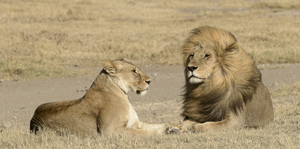 the two. When the male turned sideways the wind blew his long mane over much of his face, nearly concealing the muzzle. My vehicle turned back when I saw the opportunity , shot images until the pair got up and walked off again, but luckily turned, and walked back towards me, presenting some great shots as the constant wind fluffed back his long mane
the two. When the male turned sideways the wind blew his long mane over much of his face, nearly concealing the muzzle. My vehicle turned back when I saw the opportunity , shot images until the pair got up and walked off again, but luckily turned, and walked back towards me, presenting some great shots as the constant wind fluffed back his long mane
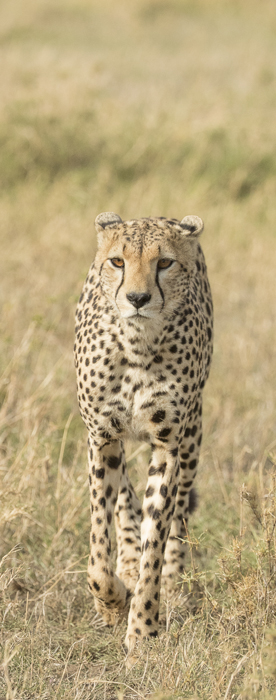 We continued on to Gol, where my guide suggested we abandon the area and head to other kopjes. I radioed Mary his suggestion, and wisely she played the same role I’d have done if the tables were reversed. She said let’s stay here, as we traveled all this way. Soon after, that decision was rewarded.
We continued on to Gol, where my guide suggested we abandon the area and head to other kopjes. I radioed Mary his suggestion, and wisely she played the same role I’d have done if the tables were reversed. She said let’s stay here, as we traveled all this way. Soon after, that decision was rewarded.
One of our guides spotted two Cheetahs, a male lying beneath a tree and a female that was moving across the grasslands. After shooting some of the male we headed to the female, getting ahead of her and letting her walk in to us. We noticed that she appeared to be nursing, and worried that following her we might run over her hidden cubs we left her and continued on.
We did find a huge Serval, but the cat was shy and the area so incredibly dry that we didn’t want to risk frightening the cat into a long run that might bring about a thirst that would not be easily quenched. We left the cat in hiding.
At 10 we had a coffee break beneath an acacia tree, and at 1PM lunch, with some stopping to check out a half-hidden Leopard beneath a tree. After lunch we photographed a large group of Reed Buck, a herd of Elephants, and various birds.
Because of our late arrival yesterday, we decided to come in early, arriving back in camp at 5. Along the way in, we had the same Leopard as we saw yesterday, and once again it had a huge herd of gazelles pointed at, and following, the Leopard. We also had a Cheetah hunting, catching a baby Thompson’s Gazelle, and almost immediately afterward, having it stolen by a Hyena. Two Hyenas came in, but the first, grabbing the gazelle, ran off and never stopped.
Day 7. Near Sametu and Maasai Kopjes
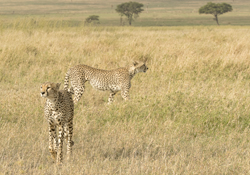 The day started with a great orange fireball, and I had my driver/guide drive down a slope, almost reacting too late, to catch the sun lined up with a ridge line acacia. While we finished photographing this we received a call that Cheetahs had been spotted. The two looked like adults, and we thought at first they were two brothers, but one was a female, and we suspect the male was her only surviving son, still hanging with her and not driven away. The cats walked by our vehicles, stopped, and began a stalk of a herd of Thompson’s Gazelles less than 150 yards away.
The day started with a great orange fireball, and I had my driver/guide drive down a slope, almost reacting too late, to catch the sun lined up with a ridge line acacia. While we finished photographing this we received a call that Cheetahs had been spotted. The two looked like adults, and we thought at first they were two brothers, but one was a female, and we suspect the male was her only surviving son, still hanging with her and not driven away. The cats walked by our vehicles, stopped, and began a stalk of a herd of Thompson’s Gazelles less than 150 yards away.
 The cats walked forward and were spotted, and the herds milled about while the cats walked through. Some questioned why the cats didn’t fan out and surround them, and I explained that Cheetahs, and nearly all Lions, do not apply strategy, and don’t work as we humans would. Consequently, what could be a sure thing becomes, in the cheetah world, about a 1 in 10 or 20 success rate for any hunt. Hunts are defined by intensions, statistically, but when a Cheetah actually charges the success is at least 50% from the hunts I’ve seen. They just don’t run if they don’t think they have a chance.
The cats walked forward and were spotted, and the herds milled about while the cats walked through. Some questioned why the cats didn’t fan out and surround them, and I explained that Cheetahs, and nearly all Lions, do not apply strategy, and don’t work as we humans would. Consequently, what could be a sure thing becomes, in the cheetah world, about a 1 in 10 or 20 success rate for any hunt. Hunts are defined by intensions, statistically, but when a Cheetah actually charges the success is at least 50% from the hunts I’ve seen. They just don’t run if they don’t think they have a chance.
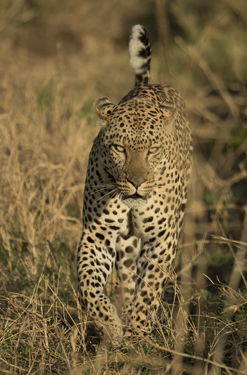 I thought we were going to be flanking the Cheetahs by a wide round-about route, but my guide told me that there was a Leopard. We found him seconds later, the big male we’ve been seeing each evening. The big Leopard was strolling down the car track, with a kopje nicely in the background. We drove ahead to frame the two, then continued, again and again, to get in front of the Leopard as it walked towards us, never veering. At times it walked straight through, between vehicles, completely unfazed by the vehicles. It was the most nonchalant Serengeti Leopard I’d ever seen, and we stayed with it close to an hour.
I thought we were going to be flanking the Cheetahs by a wide round-about route, but my guide told me that there was a Leopard. We found him seconds later, the big male we’ve been seeing each evening. The big Leopard was strolling down the car track, with a kopje nicely in the background. We drove ahead to frame the two, then continued, again and again, to get in front of the Leopard as it walked towards us, never veering. At times it walked straight through, between vehicles, completely unfazed by the vehicles. It was the most nonchalant Serengeti Leopard I’d ever seen, and we stayed with it close to an hour.
Twice we drove ahead, positioning ourselves by likely-looking trees for climbing, figuring that the cat’s stroll must end and it would go to rest in a tree. Each time, the Leopard walked right to the tree and passed it, and, unlike a Cheetah that would pass and scent mark the tree, the Leopard never did so. Instead, occasionally it sprayed grass tussocks or high grasses. The cat investigated fresh dig outs of aardvarks, but never went inside, and finally, when we left him, he was walking inside a lugga, staying somewhat out of sight.
Once, as he walked towards us, the Leopard flushed an African Hare almost from beneath his feet. I thought I started firing immediately, but my first frame (probably reacting s-l-o-w-l-y) caught the Hare as it was already across the game track with the Leopard just beginning to respond. The cat made two or three strides, never into a charge and quickly realized it had no chance, and resumed walking towards us.
We continued on, finding the same Lioness that had the Thompson’s Gazelle baby two nights ago, now lying on the nearby kopje, stretched out and nearly asleep. We passed the tree where Mary had yesterday’s leopard, had our ‘coffee break’ beneath our lunch tree, and started a slow drive back to camp, quite satisfied with the morning run.
Along the way I spotted our first Steinbuck for the trip, a female curled up beside a leafless, scraggly bush. We circled her and shot some images and continued on to camp, arriving around 11:30.
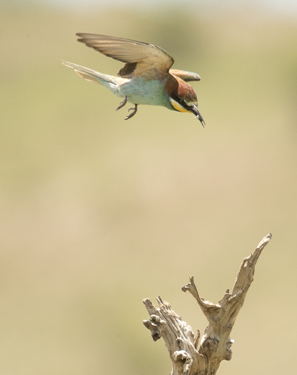 PM. Hoping to find the male Leopard after most of the tourist vehicles had headed back to camp we left at 4:30, a refreshing change from our schedule that allowed everyone to nap, download, read, or edit. Soon after leaving camp we had a very skinny male Lion who yawned repeatedly, then rose and walked towards a roadside waterhole where we found him at the end of our game drive.
PM. Hoping to find the male Leopard after most of the tourist vehicles had headed back to camp we left at 4:30, a refreshing change from our schedule that allowed everyone to nap, download, read, or edit. Soon after leaving camp we had a very skinny male Lion who yawned repeatedly, then rose and walked towards a roadside waterhole where we found him at the end of our game drive.
We continued on, although our guides said that the male leopard had traveled into high grass. Later –and I’m not sure if the same leopard was the one they referred to – we found a Leopard lying on a termite mound. A researcher’s vehicle was there, and we watched from a game track until the cat left the mound. I had only a brief glimpse but I thought it was a female.
The cat crossed the grasslands, and it appeared to me that it was heading to a kopje. I had my guide drive us there, and sure enough,, a few minutes later the Leopard passed by us and climbed onto the rocks. There she gave a grunting call, as if calling for her cubs (it was a female!), and although for a few minutes we could see her tail wagging, and I thought she’d reappear with cubs around her, she did not, and instead left that kopje and crossed to another where she settled, and where we did our final images of the day.
Returning back to camp we found three more Lions, a lioness and two four year old males with scruffy manes, heading towards the skinny male at the waterhole, and the two Cheetahs from this morning, now silhouetted on the horizon, erect and still hunting.
To the northwest virga and heavy clouds made for a beautiful western sky and sunset, and the likelihood of rain in the upper Mara, where we were just days before.
Day 8. Sametu to Ngorongoro Crater
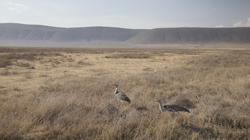 We packed up and headed out to our next destination, driving through the Maasai kopjes and the fringes of Seronera along the way. It was a pretty slow day, with the greatest highlight being four Lions charging a radio-collared Lionesses and another. The skirmish lasted only about 10 seconds, in high grass, and all that was really seen was the male doing a somersault as he hit the lioness. Mary was there, and thought that the two were actually part of the pride, just not recognized. Only one, the collared Lioness, emerged from the grasses after the fight, but I suspect no one was killed as the fight did not last long enough.
We packed up and headed out to our next destination, driving through the Maasai kopjes and the fringes of Seronera along the way. It was a pretty slow day, with the greatest highlight being four Lions charging a radio-collared Lionesses and another. The skirmish lasted only about 10 seconds, in high grass, and all that was really seen was the male doing a somersault as he hit the lioness. Mary was there, and thought that the two were actually part of the pride, just not recognized. Only one, the collared Lioness, emerged from the grasses after the fight, but I suspect no one was killed as the fight did not last long enough.
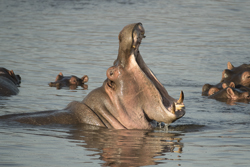
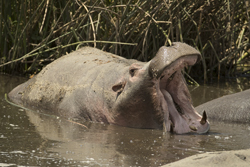
We continued on towards the Crater, traveling a washboard road that challenged the integrity of every screw in camera, lens, and computer. At the Crater rim we assembled our gear for the afternoon game drive, which was mainly birds, and we arrived in camp at 5:30, tired from a very long day.
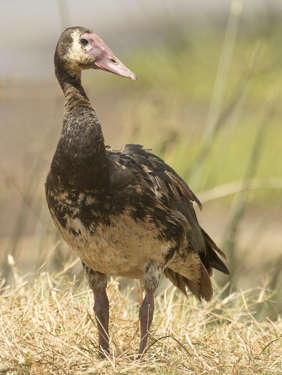
Day 9. Ngorongoro Crater
We left at 6 and my vehicle, with John and Judy, headed immediately to the lunch area for a bathroom break. It was a fortuitous decision, as we had a great pair of Crowned Cranes silhouetted against the caldera slope as we neared the rest stop, and over forty Hippos lulling in the water near the picnic area, something you do not see once lunch time arrives with hordes of tourists.
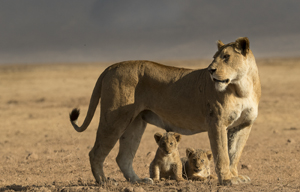
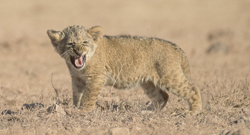
Afterwards we headed out, and the Lionesses and cubs Mary had seen on the way in were now walking towards us. My vehicle was last, and the only one there, but we radioed everyone, and all arrived to have at least some shooting as the four females and cubs walked to us, then crossed the road, then moved down to the swamp where they drank and played, before moving behind a small ridge line. The cubs reappeared later with one Lioness, and a flock of Helmeted Guineafowl who paid virtually no attention to the lions or the cubs.
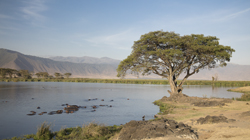 After this shoot it was time for our coffee/snacks break, so we returned to the picnic area where we filmed Buffalo and birds around the pond. Continuing on, the rest of the day involved: a Bull Elephant that walked right to us, one of the big tuskers of the crater; two Elephants sparring; a great Zebra fight; a distant Serval; great Woodland Kingfishers (we also had this yesterday as one of the highlights); herds of Gnu and Zebras with wide angle lenses right beside the vehicles; and finishing up with the Lions and cubs at the swamp.
After this shoot it was time for our coffee/snacks break, so we returned to the picnic area where we filmed Buffalo and birds around the pond. Continuing on, the rest of the day involved: a Bull Elephant that walked right to us, one of the big tuskers of the crater; two Elephants sparring; a great Zebra fight; a distant Serval; great Woodland Kingfishers (we also had this yesterday as one of the highlights); herds of Gnu and Zebras with wide angle lenses right beside the vehicles; and finishing up with the Lions and cubs at the swamp.
We returned to camp by 6, and at dinner, since Sherry, David, and Bill were leaving the group the next morning, we did our trip highlights, favorite parks, favorite photos, and more as a great recap.
 Day 10. Ngorongoro Crater to Tarangire National Park
Day 10. Ngorongoro Crater to Tarangire National Park
Planning on arriving after lunch to TNP, we had a leisurely 7:30AM breakfast and a four hour drive to the park. Prior to leaving, Mary and I had a long discussion with the owner of Lion’s Paw, our tented camp here, about upgrading the facilities, with his idea of attracting a higher paying clientele. I pointed out to him that trying to price themselves similarly to Botswana’s prices might not work, since the Serengeti offers longer periods of inactivity and longer drives, and not the more constant shooting that occurs in some areas of Botswana – but not all! Hopefully they saw my point.
 We arrived at TNP at lunch, ate at the gate, and headed in to the Sopa Lodge for our two night stay. We did our game drive at 4PM, and just out of the gate we had a nice family of Common Waterbuck with a young lamb nursing, bashing his head into the udder of his mother. The bird activity was incredible, with the very best views and shooting I’ve ever had of a Gymnogene (African Harrier Hawk), two encounters with Pearl Spotted
We arrived at TNP at lunch, ate at the gate, and headed in to the Sopa Lodge for our two night stay. We did our game drive at 4PM, and just out of the gate we had a nice family of Common Waterbuck with a young lamb nursing, bashing his head into the udder of his mother. The bird activity was incredible, with the very best views and shooting I’ve ever had of a Gymnogene (African Harrier Hawk), two encounters with Pearl Spotted 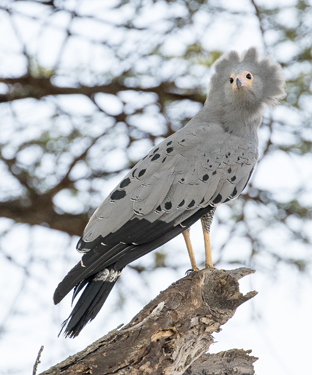 Owlets, and an extremely cooperative Pigmy Falcon that appeared to be intent on fishing out a lizard (I presume) from a dead snag at minimum distance for our telephotos.
Owlets, and an extremely cooperative Pigmy Falcon that appeared to be intent on fishing out a lizard (I presume) from a dead snag at minimum distance for our telephotos.
The Baobob trees here are spectacular, and we shot a few landscapes, with elephants and zebras, but we missed aligning a tree with a great sunset.
Day 11. Tarangire
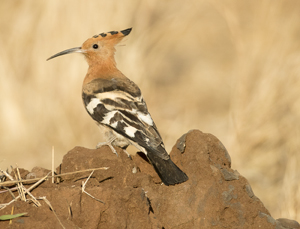 We left at 6AM, heading towards the swamp area where we’ve often had leopard. I had my GPS along, and located an African Hoopoe nest that I had marked from TWO YEARS AGO. An adult was on the nest mound – a small termite mound, but the bird didn’t stay long, just enough for a few shots. With the GPS I located a tree where we had Rock Pythons last time, but the trees were bare.
We left at 6AM, heading towards the swamp area where we’ve often had leopard. I had my GPS along, and located an African Hoopoe nest that I had marked from TWO YEARS AGO. An adult was on the nest mound – a small termite mound, but the bird didn’t stay long, just enough for a few shots. With the GPS I located a tree where we had Rock Pythons last time, but the trees were bare.
We continued around the marsh, looking for lions and wild dogs, but were unsuccessful. Fringe-eared Oryx and, rarely, Gerenuk frequent the area, but both eluded us. Long lines of Gnus headed towards the swamp and we hoped that we’d get some panning running shots but the Gnus were lazy and just walked on by.
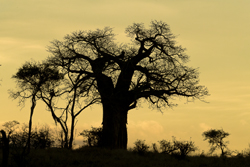 With all the driving we didn’t have breakfast until nearly 10AM, and afterwards we headed towards the lodge. In route I found a Red and Yellow Barbet that looked promising at a termite mound, but Mary and her guide both spotted a Leopard in a tree and we headed there after we received a radio call. The cat was not in a good spot for shooting, and was shy, and shortly after we arrived it climbed down the tree and disappeared. We headed to the lodge, arriving around 12:10.
With all the driving we didn’t have breakfast until nearly 10AM, and afterwards we headed towards the lodge. In route I found a Red and Yellow Barbet that looked promising at a termite mound, but Mary and her guide both spotted a Leopard in a tree and we headed there after we received a radio call. The cat was not in a good spot for shooting, and was shy, and shortly after we arrived it climbed down the tree and disappeared. We headed to the lodge, arriving around 12:10.
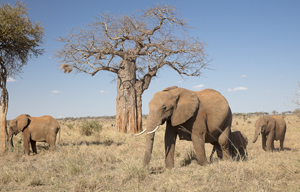 PM. Under a nearly cloudless sky we started our game drive at 4, and within minutes had a fair size herd of Elephants grazing near the road. There are a lot of Baobob trees close to the lodge and Larry, Ken, and I stayed with the elephants a long time as the herd grazed closer and closer, until we finished with 24mm wide-angle shots of the eles with the baobobs in the background. With a polarizer there was just enough wispy clouds to give some interest. The Elephants fed upon dried grasses, quite audibly ripping the grasses from the ground, entwining their trunks and then
PM. Under a nearly cloudless sky we started our game drive at 4, and within minutes had a fair size herd of Elephants grazing near the road. There are a lot of Baobob trees close to the lodge and Larry, Ken, and I stayed with the elephants a long time as the herd grazed closer and closer, until we finished with 24mm wide-angle shots of the eles with the baobobs in the background. With a polarizer there was just enough wispy clouds to give some interest. The Elephants fed upon dried grasses, quite audibly ripping the grasses from the ground, entwining their trunks and then 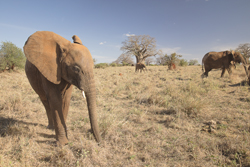 either pulling hard, or kicking free with a foreleg, before beating the root stock against their side or leg to knock clinging soil from the roots.
either pulling hard, or kicking free with a foreleg, before beating the root stock against their side or leg to knock clinging soil from the roots.
Later in the day we had a very blasé mother Elephant with a young baby. The mother fed close to the road while the baby usually huddled between her legs, although the baby did present itself a few times for clear shots.
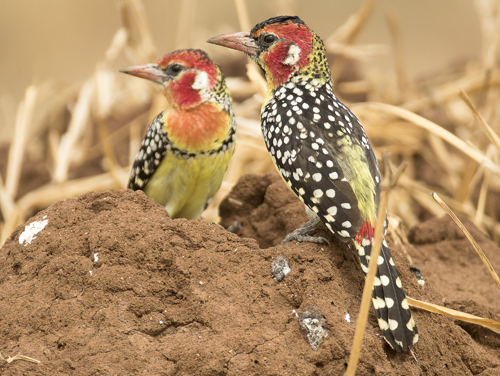
The light was clear and angular, and we did landscapes of the river and of the peculiar termite mounds here that look phallic, and are oriented in a north/northwest direction, presumably to aid in cooling the interior by facing away from the hot afternoon sun. Mary’s vehicle had a great Lilac-breasted Roller, and we ended the day watching a male Ostrich chasing after three very flirtatious females, who would pause and dip and fan their wings in invitation. As we headed for the lodge one of the females ran parallel to us and close by, and one could truly appreciate the immense size of these, the world’s largest living birds.
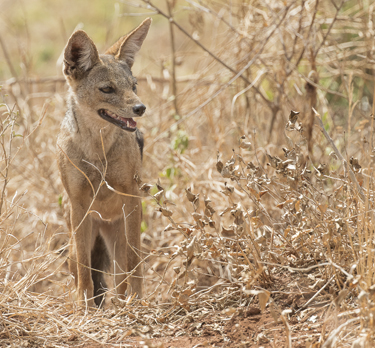 Day 12. Tarangire
Day 12. Tarangire
We followed the same route as yesterday morning, driving to the swamp where we found a pride of lions and, oddly, a dead and uneaten buffalo. The herd was nearby and circled around the lion pride, kicking up dust and masking the scene in a red-brown haze, but neither side, buffalo or lion, acted with any further aggression. As we circled the swamp and entered a new area I was surprised to find a very tame Black-backed Jackal that circled around what we suppose was its den.
We arrived at our last lodge in time for a wonderful lunch, and I spent the rest of the afternoon at my bat tree where I set up a make-shift frame of bamboo for the five flashes and the Range IR I'd use to trigger the system. 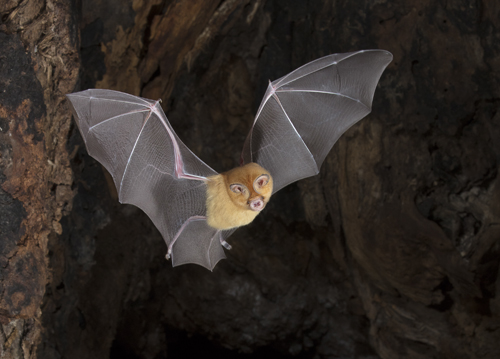
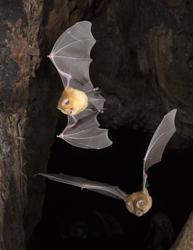
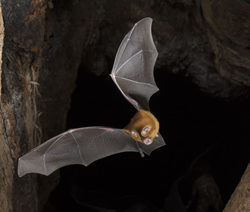
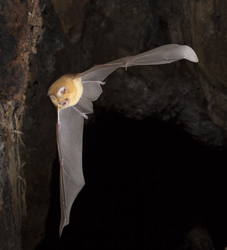
All worked well, and on cue shortly after dark thousands of bats emerged from the roost. We shot for nearly two hours, while having dinner, and everyone shot at least 1100 images. While doing so, a Lion pride visited the lodge's waterhole, as did a herd of Elephants.
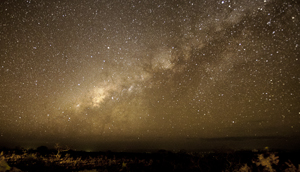 After packing up the equipment and returning to our room I made one final image - the Milky Way galaxy stretched across the western horizon. My tripod was packed, so I rested the camera and wide-angle lens on some clothes as a prop, and fired 25 second exposures.
After packing up the equipment and returning to our room I made one final image - the Milky Way galaxy stretched across the western horizon. My tripod was packed, so I rested the camera and wide-angle lens on some clothes as a prop, and fired 25 second exposures.
Day 13. Tarangire to Arusha
After a leisurely breakfast we packed and headed to Arusha, where some flew back to the states while others joined us on the long drive to Nairobi where, tomorrow, we would start our 91-95th Mountain Gorilla treks in Rwanda two days later. It was sad to depart from Tanzania after a very productive trip.
We'll be doing our next Tanzania trips in 2018, both to the southern Serengeti in February, for the Gnu migration and birthing season, and also in October, for the northern Serengeti for a trip similar to the one we've just completed. I hope we'll see you at one, or both!
Tanzania 2016 October
Photo Safari
Trip Report

Read our Complete Trip Journals,
of our Tanzania Trips
Read our Brochure for 2018
 Gnu crossing the Mara River
Gnu crossing the Mara River

Lioness and cub, with the highlight in the eye from the
reflection of our vehicle's windows in the early morning light.
This was our third visit to Tanzania in October and once again, the Serengeti, Ngorongoro, and Tarangire National Parks did not disappoint us. I'm always amazed that just within sight of the Masai Mara border the landscape changes so dramatically, with some of the most picturesque kopjes only a short drive away. We were hoping to catch the tail-end of the Gnu migration, and indeed we did with a great river crossing on our first day, and that evening we also had an absolute first -- a pair of Leopards on a kopje at sunset, silhouetted against the orange sky of the setting sun. That day was the start of a wonderful 12 days of field work, culminating with an exciting bat shoot on our last day. The entire report follows!
Day 1 – Arusha to northern Serengeti
Everyone arrived with all their luggage over the last three days and this morning we left our hotel for an hour long flight to the upper Serengeti, where our camp is located a short distance from the Mara River. Our flight took us over Ol’ Donyo Lengai, Tanzania’s active volcano which is, at present, dormant. Although a few tufts of clouds covered the peak as we approached those dissipated as we neared, treating us to a spectacular view of this perfect cone-shaped volcano. Slabs of rock, presumably former lava sheets, and broken talus encircled the summit, where, to one side, a surprisingly small crater would lead into the bowels of the earth. To our right, Lake Natron stretched out immensely to the horizon, home to East Africa’s largest nesting colony of flamingos and now threatened by mining, which may ruin the hydrology and the birds’ necessary isolation in what is sometimes considered one of the most inhospitable landscapes on earth.
We continued to the northwest, flying over Ngorongoro Conservation Area lands, shared by Maasai herdsmen. Some of the small kraal villages, bomas that encircled several huts, were quite isolated, but almost all of these had at least one tin roof structure, rather than the traditional thatch. I was also surprised to see farm fields around some of these small villages – of wheat or corn I suspect, with dirt tracks for the trucks that would take the crops away.
 The landscape just northwest of Lengai was surprisingly mountainous and rugged, with steep, rocky canyons that I didn’t expect to see. I could imagine a nomadic lion traveling through these areas as it sought a pride territory of its own, and how foreign that landscape could be for a lion raised on the plains of the Serengeti. The mountains extended northward towards Kenya, and quite far off our pilot pointed out Kline’s camp’s ridge, giving some scale to the immense distances involved.We continued northwest, entering the grasslands where, in patches, the land below us was surprisingly green. August had been a very dry month, but September was wet, and it showed, and as we neared our landing strip the grasslands were green. After we landed, met our drivers – who had driven out the day before with most of our luggage, and squared away our camera gear, we started what we planned on being a short game drive back to camp. With short, bright green
The landscape just northwest of Lengai was surprisingly mountainous and rugged, with steep, rocky canyons that I didn’t expect to see. I could imagine a nomadic lion traveling through these areas as it sought a pride territory of its own, and how foreign that landscape could be for a lion raised on the plains of the Serengeti. The mountains extended northward towards Kenya, and quite far off our pilot pointed out Kline’s camp’s ridge, giving some scale to the immense distances involved.We continued northwest, entering the grasslands where, in patches, the land below us was surprisingly green. August had been a very dry month, but September was wet, and it showed, and as we neared our landing strip the grasslands were green. After we landed, met our drivers – who had driven out the day before with most of our luggage, and squared away our camera gear, we started what we planned on being a short game drive back to camp. With short, bright green  grasses now carpeting the land, the area seemed almost too park-like, too much like a zoo. On the positive side, if we happen to have a cheetah hunt here, we will see everything.Although we planned on getting to camp early to unpack and organize, Gnus had gathered at the Mara River as if to cross. We stationed ourselves a few hundred yards from the river, the procedure now used so as to not interfere with a crossing. Once a crossing begins, the vehicles move in, and usually the Gnus at that point are oblivious to vehicles – they just want to cross. I explained the dynamics of the Gnu migration to Ken and Mary (not MY Mary) who were in my vehicle, and how the herds move in a clockwise direction from the Mara, SE to the lower Serengeti, and N by NW back up again. People think the migration requires a river crossing, but it does not, if the herds travel east of the Mara River or Grumeti. The Gnu migration is not like a bird migration with a definite starting point and ending point, as Gnu herds may cross and recross a river several times. We’ve seen herds cross the Mara River, then turn around and go back the way they came. We’ve seen one herd crossing one way, and nearly colliding with another herd going in the opposite direction. There seems to be no logic involved.
grasses now carpeting the land, the area seemed almost too park-like, too much like a zoo. On the positive side, if we happen to have a cheetah hunt here, we will see everything.Although we planned on getting to camp early to unpack and organize, Gnus had gathered at the Mara River as if to cross. We stationed ourselves a few hundred yards from the river, the procedure now used so as to not interfere with a crossing. Once a crossing begins, the vehicles move in, and usually the Gnus at that point are oblivious to vehicles – they just want to cross. I explained the dynamics of the Gnu migration to Ken and Mary (not MY Mary) who were in my vehicle, and how the herds move in a clockwise direction from the Mara, SE to the lower Serengeti, and N by NW back up again. People think the migration requires a river crossing, but it does not, if the herds travel east of the Mara River or Grumeti. The Gnu migration is not like a bird migration with a definite starting point and ending point, as Gnu herds may cross and recross a river several times. We’ve seen herds cross the Mara River, then turn around and go back the way they came. We’ve seen one herd crossing one way, and nearly colliding with another herd going in the opposite direction. There seems to be no logic involved.
At any rate, the herd teased us several times, coming down to the river or running along, further to the west, requiring us to do a long round-about to follow, then turning, and running eastward, and another chase. By 1PM, however, the herds had turned inland, and a crossing seemed unlikely. We headed to camp for lunch, and to unpack and get settled before the afternoon game drive.
PM. It was hot and sultry through the afternoon, remaining so as we started the game drive at 3:30PM. By 4:30 the heat had broken and the drive was pleasant, as we fruitlessly followed gnus along the Mara River, herds that refused to cross and that would eventually wander back into higher country. We photographed a Marshal Eagle immature feeding upon a Thompson’s Gazelle while sitting in what looked like an old secretary bird nest – I didn’t think an eagle would choose a nest that low, but sec birds would use one just like this. We continued on, to Kogatende Kopjes where we photographed a few Klipspringers perched on boulders and Rock Hyrax hopping about. Another driver told our guides that Cheetahs were nearby, and we headed there, to find two males lounging a short distance off the track. They were doing nothing except an occasional roll, so it was an easy call to leave when we heard that two Leopards had been spotted.
 We raced to the kopjes to find one Leopard lying in a Sphinx position atop a boulder, while its sibling stood on another rock on the opposite side of the track. Over the next hour we stayed with the Leopards, shooting them at eye-level as a cat sat facing us, or when the two met atop the highest boulder. One replaced the other there, where it remained as the sun set behind it, giving us incredible silhouettes of the cats against the orange sky.
We raced to the kopjes to find one Leopard lying in a Sphinx position atop a boulder, while its sibling stood on another rock on the opposite side of the track. Over the next hour we stayed with the Leopards, shooting them at eye-level as a cat sat facing us, or when the two met atop the highest boulder. One replaced the other there, where it remained as the sun set behind it, giving us incredible silhouettes of the cats against the orange sky.
We left just as the sun disappeared, and drove fast to reach camp, around 7:15, in the dark. Bill’s vehicle had 15 lions as well, for a three cat afternoon.
Day 2. Northern Serengeti.
We had a 5:30am cooked breakfast and loaded in the dark for our 6AM game drive. Two of our vehicles followed the river route for a short time, looking for lions, while my vehicle and Bill’s headed directly to the kopjes. We arrived at the kopjes just after sunrise, and circled about the nearest outcrops looking for lions. Finding none, we continued to the area we had seen the leopards yesterday.
 I found a Spotted Eagle Owl perched on a rock fairly close to the road, providing clear views although the bird never fully opened its eyes. Bill’s vehicle found the lions, as many as ten, mostly cubs, scattered on the rocks and in the grasses below the kopjes, and although the older cubs were playing they soon moved back to the rocks. We continued, finding the male Leopard, which provided only a few brief shots before climbing a rock and disappearing into the brush on top.
I found a Spotted Eagle Owl perched on a rock fairly close to the road, providing clear views although the bird never fully opened its eyes. Bill’s vehicle found the lions, as many as ten, mostly cubs, scattered on the rocks and in the grasses below the kopjes, and although the older cubs were playing they soon moved back to the rocks. We continued, finding the male Leopard, which provided only a few brief shots before climbing a rock and disappearing into the brush on top.
My vehicle continued on, heading towards the Cheetah area, but we were called back as the youngest cubs and Lioness were now drinking. We arrived back in record time, and stayed with the family as they traveled around a half mile, through rocks, crossing a lugga, passing through more rocks, before finally settling in the shade of a fig tree on top of another kopje. I was surprised to find the Lioness leaving the security and company of the rest of the pride to travel as far as she did.

We headed towards the Mara River, hoping for a river crossing. While we had a ‘coffee break’ under a tree Gnus gathered, and began to cross. We left our set-up table, coffee, eggs, and bananas on the table as we raced to the  river, arriving in time to catch most of the crossing. Although Gnus had started the crossing, Zebras finished it, and when they stopped, the two dozen remaining Zebras moved up stream, and they, too, crossed. We were right at that crossing, and had Zebras racing up the river bank right in front of us.
river, arriving in time to catch most of the crossing. Although Gnus had started the crossing, Zebras finished it, and when they stopped, the two dozen remaining Zebras moved up stream, and they, too, crossed. We were right at that crossing, and had Zebras racing up the river bank right in front of us.

We continued on, seeing another Gnu crossing far upstream, and then headed back towards camp, arriving around noon. Along the way back some of our vehicles photographed more birds and hippos, for a very complete day.
PM. We left at 3:30, and just leaving camp we saw a large concentration of Gnus downriver from us. The herds were, as usual, racing back and forth, but seemed concentrated downriver and we headed that way, skirting a large lugga to do so. En route, Mary’s vehicle was charged by a Buffao, which they easily eluded, and the same Buffalo charged another vehicle a few minutes later.
Meanwhile, we had just rounded the lugga when the herd exploded into the water, and we arrived while the first animals were just beginning to swim across. A few hundred Gnus crossed, forming a U shape as they were pushed downstream and then arched back up, and about a dozen died in the attempt. The crossing stopped, but a few minutes later the Zebras renewed it, and we had a second chance at more shots – with our vehicles right at the exit points as Gnus and Zebras rushed up the bank and galloped by.
We continued upriver, looking for more crossings, then headed inland where several Elephants mud-bathed near to the road, but wandered off as we  neared. Englebert said the Black Rhinos had been seen and we headed in that direction, discovering their difficult-to-see shapes in the croton bushes. After some futile attempts to see them, I suggested we just back off and wait, and let them come out and come to us. Following our lead, the other safari vehicles did likewise, and a short time later the Rhinos emerge, a mother with a long, sharp horn, and a baby half her size with the beginning of a horn.
neared. Englebert said the Black Rhinos had been seen and we headed in that direction, discovering their difficult-to-see shapes in the croton bushes. After some futile attempts to see them, I suggested we just back off and wait, and let them come out and come to us. Following our lead, the other safari vehicles did likewise, and a short time later the Rhinos emerge, a mother with a long, sharp horn, and a baby half her size with the beginning of a horn.
 We followed them as they moved across the grasslands, keeping our distance and keeping the Rhinos relaxed. Eventually they came to an open field to browse where NOMAD Safari vehicles, filled with Chinese tourists with cell phones or pads, crowded in close, actually cutting off the view of our four vehicles. Fortunately, as the Rhinos circled around them they stayed put, and we were finally able to shoot, but we were very annoyed at the obnoxious behavior.
We followed them as they moved across the grasslands, keeping our distance and keeping the Rhinos relaxed. Eventually they came to an open field to browse where NOMAD Safari vehicles, filled with Chinese tourists with cell phones or pads, crowded in close, actually cutting off the view of our four vehicles. Fortunately, as the Rhinos circled around them they stayed put, and we were finally able to shoot, but we were very annoyed at the obnoxious behavior.
When the Rhinos wandered away from us we departed as well, but found little and so, on our return to camp, we spent the last light of the day with the Rhino pair again, where both mother and calf now grazed, undisturbed (the vehicles were a respectful distance) and in good view. We arrived in camp at dusk, after sunset but still with enough light to unpack and walk back to our tents in the light.
Day 3. Northern Serengeti.
We packed the vehicles before breakfast, allowing us to leave promptly on time at 6AM. As we drove east the eastern sky was a deep pink and various trees silhouetted nicely, but without enough of a sense of locale to justify a stop. I was hoping for elephants or giraffes, but the color dissipated without a subject for a shot.
Two Topi mothers with young calves ran across the horizon, the calves pronking, reminding me of a hobby horse or a pogo-stick, while the adults just kept stride in a normal gait. Although silhouetted against the horizon their direction was too erratic, and the duration too brief, to try catching that.
 We traveled through the kopje area early, where some of the vehicles had Klipspringers and Hyrax. I was on a lower route and had a Tawny Eagle that we suspected was hunting tree agamas, as the bird craned its neck and flew around the tree, finally landing close to us before a final flight to a branch, which we caught, and then off, lizard-less
We traveled through the kopje area early, where some of the vehicles had Klipspringers and Hyrax. I was on a lower route and had a Tawny Eagle that we suspected was hunting tree agamas, as the bird craned its neck and flew around the tree, finally landing close to us before a final flight to a branch, which we caught, and then off, lizard-less
We spotted a distant vehicle parked in a swampy area, and upon investigating found a young Leopard, the newest cub of the mother of the two Leopards we had two days ago. This young Leopard was shy, and ran off quickly. Unfortunately, Chinese tourists using NOMAD safaris didn’t care, and repeatedly went after the Leopard. At one point the cat ran across a broad open area, where it’d have been easily seen, and probably chased and killed, by lions, but luckily it made it to some brush. The NOMAD safari driver responsible for flushing the cat still followed, but either the cat stayed hidden, or they had enough of a view, that they finally departed. I wanted my driver to approach their vehicle – I was prepared to give the tourists a lecture, informing them of the danger to the cat (they probably didn’t have a clue) and to lecture the driver, but my driver/guide suddenly went deaf and didn’t budge. Empathizing with his predicament – not angering fellow drivers – I didn’t press it, but I was disappointed with him.

At lunch, with one of our other drivers present, I explained how ‘not getting involved,’ and not standing up for what was the correct thing to do can be so hurtful to the tourist industry. Had that leopard been killed by a lion, there’s no doubt that that news would be all over the internet, and the Serengeti officials would know, and that there would probably be increased patrolling, and less freedom of movement, as a result. Whether the speech made any difference …. To Mary’s credit, when other NOMAD drivers went by, she did chew them out about the actions of their colleague, and told them they should have radioed him, and stopped him from harassing the leopard.
We continued east, and at one point we were approximately 15 miles from our camp here, and 14 miles from Keekorok Lodge and Mara Serena Lodge in Kenya. We found a pride which I suspect was newly taken over, with three males – one full blond, another dark maned with a less impressive mane, and another fully maned, dark coated, and four Lionesses, with one subadult Lioness. No subadult males, and about a half mile away we found another Lioness, with new born cubs under two weeks old – probably the trio’s first litter. The cubs were vocal, sounding often like chirring birds, at other times yelping, as they scrambled over the mostly hidden lioness.
At 11:30 we headed for home, and the trip, only 15 miles straight, still required an hour’s drive.
PM. After leaving camp we turned and headed upriver, and within minutes had an Elephant in the river, crossing to join the herd on the opposite side. We arrived too late for mid-river shots, but Sherry and Tom had the scene as the afternoon highlight, as the Elephant scrambled up the bank, bending its forelegs to lower itself enough that its knees could gain ground, and by kneeling, crawl up the bank.
 We drove slowly, stopping for a front-view of a large Leopard Tortoise, and later, for two African Spoonbills and a small flock of Sacred Ibis – the latter being at the same pond for the last several days. We found the mother Black Rhino and baby again, but they were poorly backlighted and somewhat distant, but the first Tom had seen so the stop was worthwhile. We continued on to a reported Gnu river crossing, but the animals turned from the river and we headed back to the Rhinos, hoping that they had come closer to one of the roads.
We drove slowly, stopping for a front-view of a large Leopard Tortoise, and later, for two African Spoonbills and a small flock of Sacred Ibis – the latter being at the same pond for the last several days. We found the mother Black Rhino and baby again, but they were poorly backlighted and somewhat distant, but the first Tom had seen so the stop was worthwhile. We continued on to a reported Gnu river crossing, but the animals turned from the river and we headed back to the Rhinos, hoping that they had come closer to one of the roads.

They had, and we had a wonderful session where the Rhinos were framed against the Mara River and the distant, plateau-like buttes of the lower Masai Mara. The light was soft but direct, and the scene looked like a painting, again, one of the photo highlights for the trip.
As we headed back to camp several of us stopped at some trees for a sunset, before continuing and arriving at camp at 7PM.
 Day 4. Northern Serengeti
Day 4. Northern Serengeti
We followed the same schedule, leaving at 6AM and heading towards the kopjes. We hadn’t traveled too far from camp when we found two four year old males, nomads—I suspect, lying in Sphinx-poses beside the road. One was a blond mane without a trace of dark hair, while the other was surprisingly dark, although both sported the size mane typical of that age.
 The sunrise was eye-achingly brilliant, without humidity, but we found some trees to silhouette as the sun climbed over one of the hills. Continuing on, my vehicle had a nice Topi overlooking the rock-strewn kopje fields, and a Pigmy Falcon perched close to the road. We headed towards where, in the past, we had an Elephant Shrew. It wasn’t there, but Mary’s vehicle spotted one. While we were looking, Tom’s vehicle found one of the two Leopard cubs. The cat crossed in front of them, and then went into a kopje where my vehicle encountered it, climbing down from a rock and resting in a crevice where it gnawed at portions of a Gnu.
The sunrise was eye-achingly brilliant, without humidity, but we found some trees to silhouette as the sun climbed over one of the hills. Continuing on, my vehicle had a nice Topi overlooking the rock-strewn kopje fields, and a Pigmy Falcon perched close to the road. We headed towards where, in the past, we had an Elephant Shrew. It wasn’t there, but Mary’s vehicle spotted one. While we were looking, Tom’s vehicle found one of the two Leopard cubs. The cat crossed in front of them, and then went into a kopje where my vehicle encountered it, climbing down from a rock and resting in a crevice where it gnawed at portions of a Gnu.
We heard a Baboon was approaching, and the Baboon suddenly appeared, causing the Leopard to race across the rocks, with the male Baboon bounding in pursuit, sometimes being within 15 feet of the fleeing Leopard. The Leopard ran for at least 100 yards before the cat ducked into vegetation and safety.
 We continued on to where the kopje Lion pride had a Gnu kill. Lions were scattered around on the rocks, and we circled around, looking for shots. Vultures gathered at one of the kills – apparently there were two, and one was an Egyptian Vulture, a very rare species here in the Serengeti. This species is known for cracking Ostrich eggs by smashing the eggs with a stone it tosses with its beak, one of the very first birds to be known to use tools.
We continued on to where the kopje Lion pride had a Gnu kill. Lions were scattered around on the rocks, and we circled around, looking for shots. Vultures gathered at one of the kills – apparently there were two, and one was an Egyptian Vulture, a very rare species here in the Serengeti. This species is known for cracking Ostrich eggs by smashing the eggs with a stone it tosses with its beak, one of the very first birds to be known to use tools.
We drove to the plains where we had the Lions yesterday. Along the way, I thought I saw a movement, like a tail flashing above the grasses. I kept watching and through the intervening trees I saw another flash. I had my driver back up, and a minute or so later the back of a cat appeared. Leopard or Lion? Watching longer, I saw that it was a Lioness, and she had her head  down, as if nuzzling or smelling. I suspected she had cubs, and when Mary arrived, she confirmed my view – the Lioness was nursing. We continued watching, trying to make sense of this, when she disappeared. My vehicle drove over, and I spotted two tiny cubs, probably under 2 weeks old and with their eyes barely open, and unfocused. We got some shots, as did all of our other folks, all streaming in from the radio call.
down, as if nuzzling or smelling. I suspected she had cubs, and when Mary arrived, she confirmed my view – the Lioness was nursing. We continued watching, trying to make sense of this, when she disappeared. My vehicle drove over, and I spotted two tiny cubs, probably under 2 weeks old and with their eyes barely open, and unfocused. We got some shots, as did all of our other folks, all streaming in from the radio call.
 We continued on for a coffee break, then headed back, where we had another encounter with yesterday’s Lion pride, and had two matings in 20 minutes. Yesterday, a lion pair mated once, and I suspect that the pair had just begun. Today, I suspect, the heat was intensifying. Mating couples often separate themselves from the pride, or perhaps simply stay put, mating, while the pride moves on, and during the five days or so of the honeymoon the pair rarely eat. These two were full, and I suspect the kill from yesterday was their last for the next few days.
We continued on for a coffee break, then headed back, where we had another encounter with yesterday’s Lion pride, and had two matings in 20 minutes. Yesterday, a lion pair mated once, and I suspect that the pair had just begun. Today, I suspect, the heat was intensifying. Mating couples often separate themselves from the pride, or perhaps simply stay put, mating, while the pride moves on, and during the five days or so of the honeymoon the pair rarely eat. These two were full, and I suspect the kill from yesterday was their last for the next few days.
As we headed towards home, I spotted a Wattled Plover nesting right beside the game track. Close enough for frame-filling shots. The drive back took an hour, with one stop when some shot a crèche of baby Giraffes, all lying on the ground, resting.
PM. We left at 3:30PM, driving directly to the kopje area where we expected most of the activity. Mary’s vehicle went to the Kuria Kopjes, exploring, and ended up the only vehicle in that area. They had great luck, with a Martial Eagle close up with a Rock Hyrax kill, a very good Elephant Shrew, and some Klipspringers. My vehicle worked the normal kopje area,  where we spent time with a family of Klipspringers and three Oribi antelope, with the ram scent marking via his preorbital gland. The ram would bite off a stem, eating the top, and leaving a thicker stem that he would insert into the gland. Thompson’s Gazelles just find a likely stem and poke their gland – the Oribi fashioned theirs.
where we spent time with a family of Klipspringers and three Oribi antelope, with the ram scent marking via his preorbital gland. The ram would bite off a stem, eating the top, and leaving a thicker stem that he would insert into the gland. Thompson’s Gazelles just find a likely stem and poke their gland – the Oribi fashioned theirs.
At the same swampy lugga where we had the shy young Leopard two mornings ago we heard Vervet Monkeys giving a variety of alarm barks. Some of the calls were the usual ‘chak-chak-chak’ bark, but there was higher pitched, nearly chirping calls too, and I couldn’t be sure if that was just the alarm notes of immature monkeys, or a different warning. I suspected python, but regardless of our search, we found neither leopard or python.
We continued to the kopjes where we had the young Leopard this morning, and found him resting on some boulders beneath a bush, the possible location where he hid from the Baboons. He groomed and eventually rose, walking between vehicles before coming to rest on another boulder. We waited, expecting him to rise, when we received a call that Lion cubs were about.

 From our vantage I could see the cubs and they were the three young ones from yesterday morning. By the time I arrived our other vehicles were in great locations, but the two that were there first, for nearly 30 minutes, graciously moved out so that we could get some shots. The light was getting low so I did more video than stills, but David fired away (as did I) and everyone should have some great shots. Ken, Sherry, and Mary (not my Mary) were there first, and had calendar-like shots of the three small cubs draped over a weathered stump, all lined up staring at the camera.
From our vantage I could see the cubs and they were the three young ones from yesterday morning. By the time I arrived our other vehicles were in great locations, but the two that were there first, for nearly 30 minutes, graciously moved out so that we could get some shots. The light was getting low so I did more video than stills, but David fired away (as did I) and everyone should have some great shots. Ken, Sherry, and Mary (not my Mary) were there first, and had calendar-like shots of the three small cubs draped over a weathered stump, all lined up staring at the camera.
Storm clouds moved in from the east as we headed home, at speed, as it was nearly dark. We arrived back at camp at 7PM, and 15 minutes later the storm hit camp, and although the storm sounded wild and furious, little rain fell and by dinner, at 8PM, the skies were clearing, with lightning streaking the far western horizon.
Day 5. Northern Serengeti to Sametu, Central Serengeti
 We packed up before breakfast and had an on-time departure, around 6:15 for an all-day game drive to our next destination. We headed directly to the Kopjes, hoping to find the leopard and lion cubs. We got both. We were photographing birds when we had the radio call that the cubs were found. We arrived as they were advancing to a thicket of croton bushes, but fortunately the Lioness climbed on top of a rock, followed by the cubs.
We packed up before breakfast and had an on-time departure, around 6:15 for an all-day game drive to our next destination. We headed directly to the Kopjes, hoping to find the leopard and lion cubs. We got both. We were photographing birds when we had the radio call that the cubs were found. We arrived as they were advancing to a thicket of croton bushes, but fortunately the Lioness climbed on top of a rock, followed by the cubs.
She seemed to be facing away from the sun, and I felt that a back-lighted image would be more impressive than over-the-shoulder light, so I had our guide drive accordingly. A great  choice, as the Lioness was completely in the open, facing us, and soon joined by the cubs. Our vehicle’s glass acted like a reflector and bounced sunlight onto the lioness and cub, who was framed by dark vegetation. One of the photo highlights of the trip.
choice, as the Lioness was completely in the open, facing us, and soon joined by the cubs. Our vehicle’s glass acted like a reflector and bounced sunlight onto the lioness and cub, who was framed by dark vegetation. One of the photo highlights of the trip.

We continued on, looking for the male Leopard, and found the cub lying in a small depression atop some rocks. We only had head shots before he finally moved off, and we did too. Mary’s vehicle headed to the airstrip for our park permit, while my vehicle went to the river to scout for gnu crossings. We did find two Hippos that were either mating, or were simply playing, as they began by mouthing each other with wide-open jaws, then appearing to be in a mating position – although they looked too young to be a dominant pair.  In Hippo society, one bull Hippo controls a harem of cows, and the bull would not tolerate mating with subordinate males. I suspect that a female that was fertile produces some sign, pheromones perhaps, that alerts the male. Consequently, if the pair we watched were indeed two sexes, their immaturity and non-fertility allowed mating-like behavior. I do think, however, that they were simply two young males sparing.
In Hippo society, one bull Hippo controls a harem of cows, and the bull would not tolerate mating with subordinate males. I suspect that a female that was fertile produces some sign, pheromones perhaps, that alerts the male. Consequently, if the pair we watched were indeed two sexes, their immaturity and non-fertility allowed mating-like behavior. I do think, however, that they were simply two young males sparing.
We drove to the area where we had the mating Lions yesterday, which I missed, but Mary’s vehicle, coming from a different direction, had the Lions, including a male dragging a Gnu carcass. From there we continued southeast, stopping to photograph European Bee-eaters, Swallows, sparring Common Zebra, aerial perspectives on the herds and Elephants, Elephants coming to water to drink, baby Giraffes, a sighting of an African Hawk-Eagle, and a long, long drive towards camp.
 At the end of the day, close to our camp at Sametu, Mary’s vehicle, in the lead, spotted a Lioness carrying what they first thought was a cub, with another Lioness following behind. It was not a cub, but a baby Thompson’s Gazelle, which the Lioness carried into high grass. I arrived then, and seeing the distant cat, I thought that the one with the Gazelle was the mother, and was calling to the other to entice it to play with the baby gazelle, learning to hunt. As I later learned, she was probably grimacing her displeasure, and alerting the other Lioness to keep her distance.
At the end of the day, close to our camp at Sametu, Mary’s vehicle, in the lead, spotted a Lioness carrying what they first thought was a cub, with another Lioness following behind. It was not a cub, but a baby Thompson’s Gazelle, which the Lioness carried into high grass. I arrived then, and seeing the distant cat, I thought that the one with the Gazelle was the mother, and was calling to the other to entice it to play with the baby gazelle, learning to hunt. As I later learned, she was probably grimacing her displeasure, and alerting the other Lioness to keep her distance.
Meanwhile, one of our other guides saw a dust cloud of antelope, and via binocs, spotted a Leopard walking along. The cloud was due to a momentary panic on the antelopes’ part, but afterward, they followed behind, keeping the predator in sight.
As we drove into camp I watched a ram Thompson charging across the barren ground towards another, stopping short within a dozen feet or so
Day 6. Sametu Kopjes
We did an all-day game drive today, driving through the Sametu Kopjes where, in February, we had some exciting lion photography at an adjacent marsh. Today that marsh is dry, and the area leading to the Gol kopjes, burnt in anticipation of the rains, was barren and dusty. Soon after sunrise at the last waterhole before the Gol Kopjes begin we had a pair of Lions that were a day or two before actual heat. The male was extremely attentive, following the female everywhere, and staying close, and when she would lie down he’d gingerly settle beside her, licking her back and neck, and occasionally biting at her neck in practice for the more serious grip he’ll use when mating.
Lying in brushy grass with only his mane showing, the male could easily have been mistaken for a hay clump, or a mat of vegetation. At one point the Lioness rose, and we followed, thinking a mating was imminent, but she settled down again and nothing happened. Finally, the two got up and walked off, and we headed out … but I looked back and saw that the two had settled on a grassy strip beside the road, giving the clearest view yet of  the two. When the male turned sideways the wind blew his long mane over much of his face, nearly concealing the muzzle. My vehicle turned back when I saw the opportunity , shot images until the pair got up and walked off again, but luckily turned, and walked back towards me, presenting some great shots as the constant wind fluffed back his long mane
the two. When the male turned sideways the wind blew his long mane over much of his face, nearly concealing the muzzle. My vehicle turned back when I saw the opportunity , shot images until the pair got up and walked off again, but luckily turned, and walked back towards me, presenting some great shots as the constant wind fluffed back his long mane
 We continued on to Gol, where my guide suggested we abandon the area and head to other kopjes. I radioed Mary his suggestion, and wisely she played the same role I’d have done if the tables were reversed. She said let’s stay here, as we traveled all this way. Soon after, that decision was rewarded.
We continued on to Gol, where my guide suggested we abandon the area and head to other kopjes. I radioed Mary his suggestion, and wisely she played the same role I’d have done if the tables were reversed. She said let’s stay here, as we traveled all this way. Soon after, that decision was rewarded.
One of our guides spotted two Cheetahs, a male lying beneath a tree and a female that was moving across the grasslands. After shooting some of the male we headed to the female, getting ahead of her and letting her walk in to us. We noticed that she appeared to be nursing, and worried that following her we might run over her hidden cubs we left her and continued on.
We did find a huge Serval, but the cat was shy and the area so incredibly dry that we didn’t want to risk frightening the cat into a long run that might bring about a thirst that would not be easily quenched. We left the cat in hiding.
At 10 we had a coffee break beneath an acacia tree, and at 1PM lunch, with some stopping to check out a half-hidden Leopard beneath a tree. After lunch we photographed a large group of Reed Buck, a herd of Elephants, and various birds.
Because of our late arrival yesterday, we decided to come in early, arriving back in camp at 5. Along the way in, we had the same Leopard as we saw yesterday, and once again it had a huge herd of gazelles pointed at, and following, the Leopard. We also had a Cheetah hunting, catching a baby Thompson’s Gazelle, and almost immediately afterward, having it stolen by a Hyena. Two Hyenas came in, but the first, grabbing the gazelle, ran off and never stopped.
Day 7. Near Sametu and Maasai Kopjes
 The day started with a great orange fireball, and I had my driver/guide drive down a slope, almost reacting too late, to catch the sun lined up with a ridge line acacia. While we finished photographing this we received a call that Cheetahs had been spotted. The two looked like adults, and we thought at first they were two brothers, but one was a female, and we suspect the male was her only surviving son, still hanging with her and not driven away. The cats walked by our vehicles, stopped, and began a stalk of a herd of Thompson’s Gazelles less than 150 yards away.
The day started with a great orange fireball, and I had my driver/guide drive down a slope, almost reacting too late, to catch the sun lined up with a ridge line acacia. While we finished photographing this we received a call that Cheetahs had been spotted. The two looked like adults, and we thought at first they were two brothers, but one was a female, and we suspect the male was her only surviving son, still hanging with her and not driven away. The cats walked by our vehicles, stopped, and began a stalk of a herd of Thompson’s Gazelles less than 150 yards away.
 The cats walked forward and were spotted, and the herds milled about while the cats walked through. Some questioned why the cats didn’t fan out and surround them, and I explained that Cheetahs, and nearly all Lions, do not apply strategy, and don’t work as we humans would. Consequently, what could be a sure thing becomes, in the cheetah world, about a 1 in 10 or 20 success rate for any hunt. Hunts are defined by intensions, statistically, but when a Cheetah actually charges the success is at least 50% from the hunts I’ve seen. They just don’t run if they don’t think they have a chance.
The cats walked forward and were spotted, and the herds milled about while the cats walked through. Some questioned why the cats didn’t fan out and surround them, and I explained that Cheetahs, and nearly all Lions, do not apply strategy, and don’t work as we humans would. Consequently, what could be a sure thing becomes, in the cheetah world, about a 1 in 10 or 20 success rate for any hunt. Hunts are defined by intensions, statistically, but when a Cheetah actually charges the success is at least 50% from the hunts I’ve seen. They just don’t run if they don’t think they have a chance.
 I thought we were going to be flanking the Cheetahs by a wide round-about route, but my guide told me that there was a Leopard. We found him seconds later, the big male we’ve been seeing each evening. The big Leopard was strolling down the car track, with a kopje nicely in the background. We drove ahead to frame the two, then continued, again and again, to get in front of the Leopard as it walked towards us, never veering. At times it walked straight through, between vehicles, completely unfazed by the vehicles. It was the most nonchalant Serengeti Leopard I’d ever seen, and we stayed with it close to an hour.
I thought we were going to be flanking the Cheetahs by a wide round-about route, but my guide told me that there was a Leopard. We found him seconds later, the big male we’ve been seeing each evening. The big Leopard was strolling down the car track, with a kopje nicely in the background. We drove ahead to frame the two, then continued, again and again, to get in front of the Leopard as it walked towards us, never veering. At times it walked straight through, between vehicles, completely unfazed by the vehicles. It was the most nonchalant Serengeti Leopard I’d ever seen, and we stayed with it close to an hour.
Twice we drove ahead, positioning ourselves by likely-looking trees for climbing, figuring that the cat’s stroll must end and it would go to rest in a tree. Each time, the Leopard walked right to the tree and passed it, and, unlike a Cheetah that would pass and scent mark the tree, the Leopard never did so. Instead, occasionally it sprayed grass tussocks or high grasses. The cat investigated fresh dig outs of aardvarks, but never went inside, and finally, when we left him, he was walking inside a lugga, staying somewhat out of sight.
Once, as he walked towards us, the Leopard flushed an African Hare almost from beneath his feet. I thought I started firing immediately, but my first frame (probably reacting s-l-o-w-l-y) caught the Hare as it was already across the game track with the Leopard just beginning to respond. The cat made two or three strides, never into a charge and quickly realized it had no chance, and resumed walking towards us.
We continued on, finding the same Lioness that had the Thompson’s Gazelle baby two nights ago, now lying on the nearby kopje, stretched out and nearly asleep. We passed the tree where Mary had yesterday’s leopard, had our ‘coffee break’ beneath our lunch tree, and started a slow drive back to camp, quite satisfied with the morning run.
Along the way I spotted our first Steinbuck for the trip, a female curled up beside a leafless, scraggly bush. We circled her and shot some images and continued on to camp, arriving around 11:30.
 PM. Hoping to find the male Leopard after most of the tourist vehicles had headed back to camp we left at 4:30, a refreshing change from our schedule that allowed everyone to nap, download, read, or edit. Soon after leaving camp we had a very skinny male Lion who yawned repeatedly, then rose and walked towards a roadside waterhole where we found him at the end of our game drive.
PM. Hoping to find the male Leopard after most of the tourist vehicles had headed back to camp we left at 4:30, a refreshing change from our schedule that allowed everyone to nap, download, read, or edit. Soon after leaving camp we had a very skinny male Lion who yawned repeatedly, then rose and walked towards a roadside waterhole where we found him at the end of our game drive.
We continued on, although our guides said that the male leopard had traveled into high grass. Later –and I’m not sure if the same leopard was the one they referred to – we found a Leopard lying on a termite mound. A researcher’s vehicle was there, and we watched from a game track until the cat left the mound. I had only a brief glimpse but I thought it was a female.
The cat crossed the grasslands, and it appeared to me that it was heading to a kopje. I had my guide drive us there, and sure enough,, a few minutes later the Leopard passed by us and climbed onto the rocks. There she gave a grunting call, as if calling for her cubs (it was a female!), and although for a few minutes we could see her tail wagging, and I thought she’d reappear with cubs around her, she did not, and instead left that kopje and crossed to another where she settled, and where we did our final images of the day.
Returning back to camp we found three more Lions, a lioness and two four year old males with scruffy manes, heading towards the skinny male at the waterhole, and the two Cheetahs from this morning, now silhouetted on the horizon, erect and still hunting.
To the northwest virga and heavy clouds made for a beautiful western sky and sunset, and the likelihood of rain in the upper Mara, where we were just days before.
Day 8. Sametu to Ngorongoro Crater
 We packed up and headed out to our next destination, driving through the Maasai kopjes and the fringes of Seronera along the way. It was a pretty slow day, with the greatest highlight being four Lions charging a radio-collared Lionesses and another. The skirmish lasted only about 10 seconds, in high grass, and all that was really seen was the male doing a somersault as he hit the lioness. Mary was there, and thought that the two were actually part of the pride, just not recognized. Only one, the collared Lioness, emerged from the grasses after the fight, but I suspect no one was killed as the fight did not last long enough.
We packed up and headed out to our next destination, driving through the Maasai kopjes and the fringes of Seronera along the way. It was a pretty slow day, with the greatest highlight being four Lions charging a radio-collared Lionesses and another. The skirmish lasted only about 10 seconds, in high grass, and all that was really seen was the male doing a somersault as he hit the lioness. Mary was there, and thought that the two were actually part of the pride, just not recognized. Only one, the collared Lioness, emerged from the grasses after the fight, but I suspect no one was killed as the fight did not last long enough.


We continued on towards the Crater, traveling a washboard road that challenged the integrity of every screw in camera, lens, and computer. At the Crater rim we assembled our gear for the afternoon game drive, which was mainly birds, and we arrived in camp at 5:30, tired from a very long day.

Day 9. Ngorongoro Crater
We left at 6 and my vehicle, with John and Judy, headed immediately to the lunch area for a bathroom break. It was a fortuitous decision, as we had a great pair of Crowned Cranes silhouetted against the caldera slope as we neared the rest stop, and over forty Hippos lulling in the water near the picnic area, something you do not see once lunch time arrives with hordes of tourists.


Afterwards we headed out, and the Lionesses and cubs Mary had seen on the way in were now walking towards us. My vehicle was last, and the only one there, but we radioed everyone, and all arrived to have at least some shooting as the four females and cubs walked to us, then crossed the road, then moved down to the swamp where they drank and played, before moving behind a small ridge line. The cubs reappeared later with one Lioness, and a flock of Helmeted Guineafowl who paid virtually no attention to the lions or the cubs.
 After this shoot it was time for our coffee/snacks break, so we returned to the picnic area where we filmed Buffalo and birds around the pond. Continuing on, the rest of the day involved: a Bull Elephant that walked right to us, one of the big tuskers of the crater; two Elephants sparring; a great Zebra fight; a distant Serval; great Woodland Kingfishers (we also had this yesterday as one of the highlights); herds of Gnu and Zebras with wide angle lenses right beside the vehicles; and finishing up with the Lions and cubs at the swamp.
After this shoot it was time for our coffee/snacks break, so we returned to the picnic area where we filmed Buffalo and birds around the pond. Continuing on, the rest of the day involved: a Bull Elephant that walked right to us, one of the big tuskers of the crater; two Elephants sparring; a great Zebra fight; a distant Serval; great Woodland Kingfishers (we also had this yesterday as one of the highlights); herds of Gnu and Zebras with wide angle lenses right beside the vehicles; and finishing up with the Lions and cubs at the swamp.
We returned to camp by 6, and at dinner, since Sherry, David, and Bill were leaving the group the next morning, we did our trip highlights, favorite parks, favorite photos, and more as a great recap.
 Day 10. Ngorongoro Crater to Tarangire National Park
Day 10. Ngorongoro Crater to Tarangire National Park
Planning on arriving after lunch to TNP, we had a leisurely 7:30AM breakfast and a four hour drive to the park. Prior to leaving, Mary and I had a long discussion with the owner of Lion’s Paw, our tented camp here, about upgrading the facilities, with his idea of attracting a higher paying clientele. I pointed out to him that trying to price themselves similarly to Botswana’s prices might not work, since the Serengeti offers longer periods of inactivity and longer drives, and not the more constant shooting that occurs in some areas of Botswana – but not all! Hopefully they saw my point.
 We arrived at TNP at lunch, ate at the gate, and headed in to the Sopa Lodge for our two night stay. We did our game drive at 4PM, and just out of the gate we had a nice family of Common Waterbuck with a young lamb nursing, bashing his head into the udder of his mother. The bird activity was incredible, with the very best views and shooting I’ve ever had of a Gymnogene (African Harrier Hawk), two encounters with Pearl Spotted
We arrived at TNP at lunch, ate at the gate, and headed in to the Sopa Lodge for our two night stay. We did our game drive at 4PM, and just out of the gate we had a nice family of Common Waterbuck with a young lamb nursing, bashing his head into the udder of his mother. The bird activity was incredible, with the very best views and shooting I’ve ever had of a Gymnogene (African Harrier Hawk), two encounters with Pearl Spotted  Owlets, and an extremely cooperative Pigmy Falcon that appeared to be intent on fishing out a lizard (I presume) from a dead snag at minimum distance for our telephotos.
Owlets, and an extremely cooperative Pigmy Falcon that appeared to be intent on fishing out a lizard (I presume) from a dead snag at minimum distance for our telephotos.
The Baobob trees here are spectacular, and we shot a few landscapes, with elephants and zebras, but we missed aligning a tree with a great sunset.
Day 11. Tarangire
 We left at 6AM, heading towards the swamp area where we’ve often had leopard. I had my GPS along, and located an African Hoopoe nest that I had marked from TWO YEARS AGO. An adult was on the nest mound – a small termite mound, but the bird didn’t stay long, just enough for a few shots. With the GPS I located a tree where we had Rock Pythons last time, but the trees were bare.
We left at 6AM, heading towards the swamp area where we’ve often had leopard. I had my GPS along, and located an African Hoopoe nest that I had marked from TWO YEARS AGO. An adult was on the nest mound – a small termite mound, but the bird didn’t stay long, just enough for a few shots. With the GPS I located a tree where we had Rock Pythons last time, but the trees were bare.
We continued around the marsh, looking for lions and wild dogs, but were unsuccessful. Fringe-eared Oryx and, rarely, Gerenuk frequent the area, but both eluded us. Long lines of Gnus headed towards the swamp and we hoped that we’d get some panning running shots but the Gnus were lazy and just walked on by.
 With all the driving we didn’t have breakfast until nearly 10AM, and afterwards we headed towards the lodge. In route I found a Red and Yellow Barbet that looked promising at a termite mound, but Mary and her guide both spotted a Leopard in a tree and we headed there after we received a radio call. The cat was not in a good spot for shooting, and was shy, and shortly after we arrived it climbed down the tree and disappeared. We headed to the lodge, arriving around 12:10.
With all the driving we didn’t have breakfast until nearly 10AM, and afterwards we headed towards the lodge. In route I found a Red and Yellow Barbet that looked promising at a termite mound, but Mary and her guide both spotted a Leopard in a tree and we headed there after we received a radio call. The cat was not in a good spot for shooting, and was shy, and shortly after we arrived it climbed down the tree and disappeared. We headed to the lodge, arriving around 12:10.
 PM. Under a nearly cloudless sky we started our game drive at 4, and within minutes had a fair size herd of Elephants grazing near the road. There are a lot of Baobob trees close to the lodge and Larry, Ken, and I stayed with the elephants a long time as the herd grazed closer and closer, until we finished with 24mm wide-angle shots of the eles with the baobobs in the background. With a polarizer there was just enough wispy clouds to give some interest. The Elephants fed upon dried grasses, quite audibly ripping the grasses from the ground, entwining their trunks and then
PM. Under a nearly cloudless sky we started our game drive at 4, and within minutes had a fair size herd of Elephants grazing near the road. There are a lot of Baobob trees close to the lodge and Larry, Ken, and I stayed with the elephants a long time as the herd grazed closer and closer, until we finished with 24mm wide-angle shots of the eles with the baobobs in the background. With a polarizer there was just enough wispy clouds to give some interest. The Elephants fed upon dried grasses, quite audibly ripping the grasses from the ground, entwining their trunks and then  either pulling hard, or kicking free with a foreleg, before beating the root stock against their side or leg to knock clinging soil from the roots.
either pulling hard, or kicking free with a foreleg, before beating the root stock against their side or leg to knock clinging soil from the roots.
Later in the day we had a very blasé mother Elephant with a young baby. The mother fed close to the road while the baby usually huddled between her legs, although the baby did present itself a few times for clear shots.

The light was clear and angular, and we did landscapes of the river and of the peculiar termite mounds here that look phallic, and are oriented in a north/northwest direction, presumably to aid in cooling the interior by facing away from the hot afternoon sun. Mary’s vehicle had a great Lilac-breasted Roller, and we ended the day watching a male Ostrich chasing after three very flirtatious females, who would pause and dip and fan their wings in invitation. As we headed for the lodge one of the females ran parallel to us and close by, and one could truly appreciate the immense size of these, the world’s largest living birds.
 Day 12. Tarangire
Day 12. Tarangire
We followed the same route as yesterday morning, driving to the swamp where we found a pride of lions and, oddly, a dead and uneaten buffalo. The herd was nearby and circled around the lion pride, kicking up dust and masking the scene in a red-brown haze, but neither side, buffalo or lion, acted with any further aggression. As we circled the swamp and entered a new area I was surprised to find a very tame Black-backed Jackal that circled around what we suppose was its den.
We arrived at our last lodge in time for a wonderful lunch, and I spent the rest of the afternoon at my bat tree where I set up a make-shift frame of bamboo for the five flashes and the Range IR I'd use to trigger the system. 



All worked well, and on cue shortly after dark thousands of bats emerged from the roost. We shot for nearly two hours, while having dinner, and everyone shot at least 1100 images. While doing so, a Lion pride visited the lodge's waterhole, as did a herd of Elephants.
 After packing up the equipment and returning to our room I made one final image - the Milky Way galaxy stretched across the western horizon. My tripod was packed, so I rested the camera and wide-angle lens on some clothes as a prop, and fired 25 second exposures.
After packing up the equipment and returning to our room I made one final image - the Milky Way galaxy stretched across the western horizon. My tripod was packed, so I rested the camera and wide-angle lens on some clothes as a prop, and fired 25 second exposures.
Day 13. Tarangire to Arusha
After a leisurely breakfast we packed and headed to Arusha, where some flew back to the states while others joined us on the long drive to Nairobi where, tomorrow, we would start our 91-95th Mountain Gorilla treks in Rwanda two days later. It was sad to depart from Tanzania after a very productive trip.
We'll be doing our next Tanzania trips in 2018, both to the southern Serengeti in February, for the Gnu migration and birthing season, and also in October, for the northern Serengeti for a trip similar to the one we've just completed. I hope we'll see you at one, or both!
Tanzania 2016 October
Photo Safari
Trip Report

Read our Complete Trip Journals,
of our Tanzania Trips
Read our Brochure for 2018
 Gnu crossing the Mara River
Gnu crossing the Mara River

Lioness and cub, with the highlight in the eye from the
reflection of our vehicle's windows in the early morning light.
This was our third visit to Tanzania in October and once again, the Serengeti, Ngorongoro, and Tarangire National Parks did not disappoint us. I'm always amazed that just within sight of the Masai Mara border the landscape changes so dramatically, with some of the most picturesque kopjes only a short drive away. We were hoping to catch the tail-end of the Gnu migration, and indeed we did with a great river crossing on our first day, and that evening we also had an absolute first -- a pair of Leopards on a kopje at sunset, silhouetted against the orange sky of the setting sun. That day was the start of a wonderful 12 days of field work, culminating with an exciting bat shoot on our last day. The entire report follows!
Day 1 – Arusha to northern Serengeti
Everyone arrived with all their luggage over the last three days and this morning we left our hotel for an hour long flight to the upper Serengeti, where our camp is located a short distance from the Mara River. Our flight took us over Ol’ Donyo Lengai, Tanzania’s active volcano which is, at present, dormant. Although a few tufts of clouds covered the peak as we approached those dissipated as we neared, treating us to a spectacular view of this perfect cone-shaped volcano. Slabs of rock, presumably former lava sheets, and broken talus encircled the summit, where, to one side, a surprisingly small crater would lead into the bowels of the earth. To our right, Lake Natron stretched out immensely to the horizon, home to East Africa’s largest nesting colony of flamingos and now threatened by mining, which may ruin the hydrology and the birds’ necessary isolation in what is sometimes considered one of the most inhospitable landscapes on earth.
We continued to the northwest, flying over Ngorongoro Conservation Area lands, shared by Maasai herdsmen. Some of the small kraal villages, bomas that encircled several huts, were quite isolated, but almost all of these had at least one tin roof structure, rather than the traditional thatch. I was also surprised to see farm fields around some of these small villages – of wheat or corn I suspect, with dirt tracks for the trucks that would take the crops away.
 The landscape just northwest of Lengai was surprisingly mountainous and rugged, with steep, rocky canyons that I didn’t expect to see. I could imagine a nomadic lion traveling through these areas as it sought a pride territory of its own, and how foreign that landscape could be for a lion raised on the plains of the Serengeti. The mountains extended northward towards Kenya, and quite far off our pilot pointed out Kline’s camp’s ridge, giving some scale to the immense distances involved.We continued northwest, entering the grasslands where, in patches, the land below us was surprisingly green. August had been a very dry month, but September was wet, and it showed, and as we neared our landing strip the grasslands were green. After we landed, met our drivers – who had driven out the day before with most of our luggage, and squared away our camera gear, we started what we planned on being a short game drive back to camp. With short, bright green
The landscape just northwest of Lengai was surprisingly mountainous and rugged, with steep, rocky canyons that I didn’t expect to see. I could imagine a nomadic lion traveling through these areas as it sought a pride territory of its own, and how foreign that landscape could be for a lion raised on the plains of the Serengeti. The mountains extended northward towards Kenya, and quite far off our pilot pointed out Kline’s camp’s ridge, giving some scale to the immense distances involved.We continued northwest, entering the grasslands where, in patches, the land below us was surprisingly green. August had been a very dry month, but September was wet, and it showed, and as we neared our landing strip the grasslands were green. After we landed, met our drivers – who had driven out the day before with most of our luggage, and squared away our camera gear, we started what we planned on being a short game drive back to camp. With short, bright green  grasses now carpeting the land, the area seemed almost too park-like, too much like a zoo. On the positive side, if we happen to have a cheetah hunt here, we will see everything.Although we planned on getting to camp early to unpack and organize, Gnus had gathered at the Mara River as if to cross. We stationed ourselves a few hundred yards from the river, the procedure now used so as to not interfere with a crossing. Once a crossing begins, the vehicles move in, and usually the Gnus at that point are oblivious to vehicles – they just want to cross. I explained the dynamics of the Gnu migration to Ken and Mary (not MY Mary) who were in my vehicle, and how the herds move in a clockwise direction from the Mara, SE to the lower Serengeti, and N by NW back up again. People think the migration requires a river crossing, but it does not, if the herds travel east of the Mara River or Grumeti. The Gnu migration is not like a bird migration with a definite starting point and ending point, as Gnu herds may cross and recross a river several times. We’ve seen herds cross the Mara River, then turn around and go back the way they came. We’ve seen one herd crossing one way, and nearly colliding with another herd going in the opposite direction. There seems to be no logic involved.
grasses now carpeting the land, the area seemed almost too park-like, too much like a zoo. On the positive side, if we happen to have a cheetah hunt here, we will see everything.Although we planned on getting to camp early to unpack and organize, Gnus had gathered at the Mara River as if to cross. We stationed ourselves a few hundred yards from the river, the procedure now used so as to not interfere with a crossing. Once a crossing begins, the vehicles move in, and usually the Gnus at that point are oblivious to vehicles – they just want to cross. I explained the dynamics of the Gnu migration to Ken and Mary (not MY Mary) who were in my vehicle, and how the herds move in a clockwise direction from the Mara, SE to the lower Serengeti, and N by NW back up again. People think the migration requires a river crossing, but it does not, if the herds travel east of the Mara River or Grumeti. The Gnu migration is not like a bird migration with a definite starting point and ending point, as Gnu herds may cross and recross a river several times. We’ve seen herds cross the Mara River, then turn around and go back the way they came. We’ve seen one herd crossing one way, and nearly colliding with another herd going in the opposite direction. There seems to be no logic involved.
At any rate, the herd teased us several times, coming down to the river or running along, further to the west, requiring us to do a long round-about to follow, then turning, and running eastward, and another chase. By 1PM, however, the herds had turned inland, and a crossing seemed unlikely. We headed to camp for lunch, and to unpack and get settled before the afternoon game drive.
PM. It was hot and sultry through the afternoon, remaining so as we started the game drive at 3:30PM. By 4:30 the heat had broken and the drive was pleasant, as we fruitlessly followed gnus along the Mara River, herds that refused to cross and that would eventually wander back into higher country. We photographed a Marshal Eagle immature feeding upon a Thompson’s Gazelle while sitting in what looked like an old secretary bird nest – I didn’t think an eagle would choose a nest that low, but sec birds would use one just like this. We continued on, to Kogatende Kopjes where we photographed a few Klipspringers perched on boulders and Rock Hyrax hopping about. Another driver told our guides that Cheetahs were nearby, and we headed there, to find two males lounging a short distance off the track. They were doing nothing except an occasional roll, so it was an easy call to leave when we heard that two Leopards had been spotted.
 We raced to the kopjes to find one Leopard lying in a Sphinx position atop a boulder, while its sibling stood on another rock on the opposite side of the track. Over the next hour we stayed with the Leopards, shooting them at eye-level as a cat sat facing us, or when the two met atop the highest boulder. One replaced the other there, where it remained as the sun set behind it, giving us incredible silhouettes of the cats against the orange sky.
We raced to the kopjes to find one Leopard lying in a Sphinx position atop a boulder, while its sibling stood on another rock on the opposite side of the track. Over the next hour we stayed with the Leopards, shooting them at eye-level as a cat sat facing us, or when the two met atop the highest boulder. One replaced the other there, where it remained as the sun set behind it, giving us incredible silhouettes of the cats against the orange sky.
We left just as the sun disappeared, and drove fast to reach camp, around 7:15, in the dark. Bill’s vehicle had 15 lions as well, for a three cat afternoon.
Day 2. Northern Serengeti.
We had a 5:30am cooked breakfast and loaded in the dark for our 6AM game drive. Two of our vehicles followed the river route for a short time, looking for lions, while my vehicle and Bill’s headed directly to the kopjes. We arrived at the kopjes just after sunrise, and circled about the nearest outcrops looking for lions. Finding none, we continued to the area we had seen the leopards yesterday.
 I found a Spotted Eagle Owl perched on a rock fairly close to the road, providing clear views although the bird never fully opened its eyes. Bill’s vehicle found the lions, as many as ten, mostly cubs, scattered on the rocks and in the grasses below the kopjes, and although the older cubs were playing they soon moved back to the rocks. We continued, finding the male Leopard, which provided only a few brief shots before climbing a rock and disappearing into the brush on top.
I found a Spotted Eagle Owl perched on a rock fairly close to the road, providing clear views although the bird never fully opened its eyes. Bill’s vehicle found the lions, as many as ten, mostly cubs, scattered on the rocks and in the grasses below the kopjes, and although the older cubs were playing they soon moved back to the rocks. We continued, finding the male Leopard, which provided only a few brief shots before climbing a rock and disappearing into the brush on top.
My vehicle continued on, heading towards the Cheetah area, but we were called back as the youngest cubs and Lioness were now drinking. We arrived back in record time, and stayed with the family as they traveled around a half mile, through rocks, crossing a lugga, passing through more rocks, before finally settling in the shade of a fig tree on top of another kopje. I was surprised to find the Lioness leaving the security and company of the rest of the pride to travel as far as she did.

We headed towards the Mara River, hoping for a river crossing. While we had a ‘coffee break’ under a tree Gnus gathered, and began to cross. We left our set-up table, coffee, eggs, and bananas on the table as we raced to the  river, arriving in time to catch most of the crossing. Although Gnus had started the crossing, Zebras finished it, and when they stopped, the two dozen remaining Zebras moved up stream, and they, too, crossed. We were right at that crossing, and had Zebras racing up the river bank right in front of us.
river, arriving in time to catch most of the crossing. Although Gnus had started the crossing, Zebras finished it, and when they stopped, the two dozen remaining Zebras moved up stream, and they, too, crossed. We were right at that crossing, and had Zebras racing up the river bank right in front of us.

We continued on, seeing another Gnu crossing far upstream, and then headed back towards camp, arriving around noon. Along the way back some of our vehicles photographed more birds and hippos, for a very complete day.
PM. We left at 3:30, and just leaving camp we saw a large concentration of Gnus downriver from us. The herds were, as usual, racing back and forth, but seemed concentrated downriver and we headed that way, skirting a large lugga to do so. En route, Mary’s vehicle was charged by a Buffao, which they easily eluded, and the same Buffalo charged another vehicle a few minutes later.
Meanwhile, we had just rounded the lugga when the herd exploded into the water, and we arrived while the first animals were just beginning to swim across. A few hundred Gnus crossed, forming a U shape as they were pushed downstream and then arched back up, and about a dozen died in the attempt. The crossing stopped, but a few minutes later the Zebras renewed it, and we had a second chance at more shots – with our vehicles right at the exit points as Gnus and Zebras rushed up the bank and galloped by.
We continued upriver, looking for more crossings, then headed inland where several Elephants mud-bathed near to the road, but wandered off as we  neared. Englebert said the Black Rhinos had been seen and we headed in that direction, discovering their difficult-to-see shapes in the croton bushes. After some futile attempts to see them, I suggested we just back off and wait, and let them come out and come to us. Following our lead, the other safari vehicles did likewise, and a short time later the Rhinos emerge, a mother with a long, sharp horn, and a baby half her size with the beginning of a horn.
neared. Englebert said the Black Rhinos had been seen and we headed in that direction, discovering their difficult-to-see shapes in the croton bushes. After some futile attempts to see them, I suggested we just back off and wait, and let them come out and come to us. Following our lead, the other safari vehicles did likewise, and a short time later the Rhinos emerge, a mother with a long, sharp horn, and a baby half her size with the beginning of a horn.
 We followed them as they moved across the grasslands, keeping our distance and keeping the Rhinos relaxed. Eventually they came to an open field to browse where NOMAD Safari vehicles, filled with Chinese tourists with cell phones or pads, crowded in close, actually cutting off the view of our four vehicles. Fortunately, as the Rhinos circled around them they stayed put, and we were finally able to shoot, but we were very annoyed at the obnoxious behavior.
We followed them as they moved across the grasslands, keeping our distance and keeping the Rhinos relaxed. Eventually they came to an open field to browse where NOMAD Safari vehicles, filled with Chinese tourists with cell phones or pads, crowded in close, actually cutting off the view of our four vehicles. Fortunately, as the Rhinos circled around them they stayed put, and we were finally able to shoot, but we were very annoyed at the obnoxious behavior.
When the Rhinos wandered away from us we departed as well, but found little and so, on our return to camp, we spent the last light of the day with the Rhino pair again, where both mother and calf now grazed, undisturbed (the vehicles were a respectful distance) and in good view. We arrived in camp at dusk, after sunset but still with enough light to unpack and walk back to our tents in the light.
Day 3. Northern Serengeti.
We packed the vehicles before breakfast, allowing us to leave promptly on time at 6AM. As we drove east the eastern sky was a deep pink and various trees silhouetted nicely, but without enough of a sense of locale to justify a stop. I was hoping for elephants or giraffes, but the color dissipated without a subject for a shot.
Two Topi mothers with young calves ran across the horizon, the calves pronking, reminding me of a hobby horse or a pogo-stick, while the adults just kept stride in a normal gait. Although silhouetted against the horizon their direction was too erratic, and the duration too brief, to try catching that.
 We traveled through the kopje area early, where some of the vehicles had Klipspringers and Hyrax. I was on a lower route and had a Tawny Eagle that we suspected was hunting tree agamas, as the bird craned its neck and flew around the tree, finally landing close to us before a final flight to a branch, which we caught, and then off, lizard-less
We traveled through the kopje area early, where some of the vehicles had Klipspringers and Hyrax. I was on a lower route and had a Tawny Eagle that we suspected was hunting tree agamas, as the bird craned its neck and flew around the tree, finally landing close to us before a final flight to a branch, which we caught, and then off, lizard-less
We spotted a distant vehicle parked in a swampy area, and upon investigating found a young Leopard, the newest cub of the mother of the two Leopards we had two days ago. This young Leopard was shy, and ran off quickly. Unfortunately, Chinese tourists using NOMAD safaris didn’t care, and repeatedly went after the Leopard. At one point the cat ran across a broad open area, where it’d have been easily seen, and probably chased and killed, by lions, but luckily it made it to some brush. The NOMAD safari driver responsible for flushing the cat still followed, but either the cat stayed hidden, or they had enough of a view, that they finally departed. I wanted my driver to approach their vehicle – I was prepared to give the tourists a lecture, informing them of the danger to the cat (they probably didn’t have a clue) and to lecture the driver, but my driver/guide suddenly went deaf and didn’t budge. Empathizing with his predicament – not angering fellow drivers – I didn’t press it, but I was disappointed with him.

At lunch, with one of our other drivers present, I explained how ‘not getting involved,’ and not standing up for what was the correct thing to do can be so hurtful to the tourist industry. Had that leopard been killed by a lion, there’s no doubt that that news would be all over the internet, and the Serengeti officials would know, and that there would probably be increased patrolling, and less freedom of movement, as a result. Whether the speech made any difference …. To Mary’s credit, when other NOMAD drivers went by, she did chew them out about the actions of their colleague, and told them they should have radioed him, and stopped him from harassing the leopard.
We continued east, and at one point we were approximately 15 miles from our camp here, and 14 miles from Keekorok Lodge and Mara Serena Lodge in Kenya. We found a pride which I suspect was newly taken over, with three males – one full blond, another dark maned with a less impressive mane, and another fully maned, dark coated, and four Lionesses, with one subadult Lioness. No subadult males, and about a half mile away we found another Lioness, with new born cubs under two weeks old – probably the trio’s first litter. The cubs were vocal, sounding often like chirring birds, at other times yelping, as they scrambled over the mostly hidden lioness.
At 11:30 we headed for home, and the trip, only 15 miles straight, still required an hour’s drive.
PM. After leaving camp we turned and headed upriver, and within minutes had an Elephant in the river, crossing to join the herd on the opposite side. We arrived too late for mid-river shots, but Sherry and Tom had the scene as the afternoon highlight, as the Elephant scrambled up the bank, bending its forelegs to lower itself enough that its knees could gain ground, and by kneeling, crawl up the bank.
 We drove slowly, stopping for a front-view of a large Leopard Tortoise, and later, for two African Spoonbills and a small flock of Sacred Ibis – the latter being at the same pond for the last several days. We found the mother Black Rhino and baby again, but they were poorly backlighted and somewhat distant, but the first Tom had seen so the stop was worthwhile. We continued on to a reported Gnu river crossing, but the animals turned from the river and we headed back to the Rhinos, hoping that they had come closer to one of the roads.
We drove slowly, stopping for a front-view of a large Leopard Tortoise, and later, for two African Spoonbills and a small flock of Sacred Ibis – the latter being at the same pond for the last several days. We found the mother Black Rhino and baby again, but they were poorly backlighted and somewhat distant, but the first Tom had seen so the stop was worthwhile. We continued on to a reported Gnu river crossing, but the animals turned from the river and we headed back to the Rhinos, hoping that they had come closer to one of the roads.

They had, and we had a wonderful session where the Rhinos were framed against the Mara River and the distant, plateau-like buttes of the lower Masai Mara. The light was soft but direct, and the scene looked like a painting, again, one of the photo highlights for the trip.
As we headed back to camp several of us stopped at some trees for a sunset, before continuing and arriving at camp at 7PM.
 Day 4. Northern Serengeti
Day 4. Northern Serengeti
We followed the same schedule, leaving at 6AM and heading towards the kopjes. We hadn’t traveled too far from camp when we found two four year old males, nomads—I suspect, lying in Sphinx-poses beside the road. One was a blond mane without a trace of dark hair, while the other was surprisingly dark, although both sported the size mane typical of that age.
 The sunrise was eye-achingly brilliant, without humidity, but we found some trees to silhouette as the sun climbed over one of the hills. Continuing on, my vehicle had a nice Topi overlooking the rock-strewn kopje fields, and a Pigmy Falcon perched close to the road. We headed towards where, in the past, we had an Elephant Shrew. It wasn’t there, but Mary’s vehicle spotted one. While we were looking, Tom’s vehicle found one of the two Leopard cubs. The cat crossed in front of them, and then went into a kopje where my vehicle encountered it, climbing down from a rock and resting in a crevice where it gnawed at portions of a Gnu.
The sunrise was eye-achingly brilliant, without humidity, but we found some trees to silhouette as the sun climbed over one of the hills. Continuing on, my vehicle had a nice Topi overlooking the rock-strewn kopje fields, and a Pigmy Falcon perched close to the road. We headed towards where, in the past, we had an Elephant Shrew. It wasn’t there, but Mary’s vehicle spotted one. While we were looking, Tom’s vehicle found one of the two Leopard cubs. The cat crossed in front of them, and then went into a kopje where my vehicle encountered it, climbing down from a rock and resting in a crevice where it gnawed at portions of a Gnu.
We heard a Baboon was approaching, and the Baboon suddenly appeared, causing the Leopard to race across the rocks, with the male Baboon bounding in pursuit, sometimes being within 15 feet of the fleeing Leopard. The Leopard ran for at least 100 yards before the cat ducked into vegetation and safety.
 We continued on to where the kopje Lion pride had a Gnu kill. Lions were scattered around on the rocks, and we circled around, looking for shots. Vultures gathered at one of the kills – apparently there were two, and one was an Egyptian Vulture, a very rare species here in the Serengeti. This species is known for cracking Ostrich eggs by smashing the eggs with a stone it tosses with its beak, one of the very first birds to be known to use tools.
We continued on to where the kopje Lion pride had a Gnu kill. Lions were scattered around on the rocks, and we circled around, looking for shots. Vultures gathered at one of the kills – apparently there were two, and one was an Egyptian Vulture, a very rare species here in the Serengeti. This species is known for cracking Ostrich eggs by smashing the eggs with a stone it tosses with its beak, one of the very first birds to be known to use tools.
We drove to the plains where we had the Lions yesterday. Along the way, I thought I saw a movement, like a tail flashing above the grasses. I kept watching and through the intervening trees I saw another flash. I had my driver back up, and a minute or so later the back of a cat appeared. Leopard or Lion? Watching longer, I saw that it was a Lioness, and she had her head  down, as if nuzzling or smelling. I suspected she had cubs, and when Mary arrived, she confirmed my view – the Lioness was nursing. We continued watching, trying to make sense of this, when she disappeared. My vehicle drove over, and I spotted two tiny cubs, probably under 2 weeks old and with their eyes barely open, and unfocused. We got some shots, as did all of our other folks, all streaming in from the radio call.
down, as if nuzzling or smelling. I suspected she had cubs, and when Mary arrived, she confirmed my view – the Lioness was nursing. We continued watching, trying to make sense of this, when she disappeared. My vehicle drove over, and I spotted two tiny cubs, probably under 2 weeks old and with their eyes barely open, and unfocused. We got some shots, as did all of our other folks, all streaming in from the radio call.
 We continued on for a coffee break, then headed back, where we had another encounter with yesterday’s Lion pride, and had two matings in 20 minutes. Yesterday, a lion pair mated once, and I suspect that the pair had just begun. Today, I suspect, the heat was intensifying. Mating couples often separate themselves from the pride, or perhaps simply stay put, mating, while the pride moves on, and during the five days or so of the honeymoon the pair rarely eat. These two were full, and I suspect the kill from yesterday was their last for the next few days.
We continued on for a coffee break, then headed back, where we had another encounter with yesterday’s Lion pride, and had two matings in 20 minutes. Yesterday, a lion pair mated once, and I suspect that the pair had just begun. Today, I suspect, the heat was intensifying. Mating couples often separate themselves from the pride, or perhaps simply stay put, mating, while the pride moves on, and during the five days or so of the honeymoon the pair rarely eat. These two were full, and I suspect the kill from yesterday was their last for the next few days.
As we headed towards home, I spotted a Wattled Plover nesting right beside the game track. Close enough for frame-filling shots. The drive back took an hour, with one stop when some shot a crèche of baby Giraffes, all lying on the ground, resting.
PM. We left at 3:30PM, driving directly to the kopje area where we expected most of the activity. Mary’s vehicle went to the Kuria Kopjes, exploring, and ended up the only vehicle in that area. They had great luck, with a Martial Eagle close up with a Rock Hyrax kill, a very good Elephant Shrew, and some Klipspringers. My vehicle worked the normal kopje area,  where we spent time with a family of Klipspringers and three Oribi antelope, with the ram scent marking via his preorbital gland. The ram would bite off a stem, eating the top, and leaving a thicker stem that he would insert into the gland. Thompson’s Gazelles just find a likely stem and poke their gland – the Oribi fashioned theirs.
where we spent time with a family of Klipspringers and three Oribi antelope, with the ram scent marking via his preorbital gland. The ram would bite off a stem, eating the top, and leaving a thicker stem that he would insert into the gland. Thompson’s Gazelles just find a likely stem and poke their gland – the Oribi fashioned theirs.
At the same swampy lugga where we had the shy young Leopard two mornings ago we heard Vervet Monkeys giving a variety of alarm barks. Some of the calls were the usual ‘chak-chak-chak’ bark, but there was higher pitched, nearly chirping calls too, and I couldn’t be sure if that was just the alarm notes of immature monkeys, or a different warning. I suspected python, but regardless of our search, we found neither leopard or python.
We continued to the kopjes where we had the young Leopard this morning, and found him resting on some boulders beneath a bush, the possible location where he hid from the Baboons. He groomed and eventually rose, walking between vehicles before coming to rest on another boulder. We waited, expecting him to rise, when we received a call that Lion cubs were about.

 From our vantage I could see the cubs and they were the three young ones from yesterday morning. By the time I arrived our other vehicles were in great locations, but the two that were there first, for nearly 30 minutes, graciously moved out so that we could get some shots. The light was getting low so I did more video than stills, but David fired away (as did I) and everyone should have some great shots. Ken, Sherry, and Mary (not my Mary) were there first, and had calendar-like shots of the three small cubs draped over a weathered stump, all lined up staring at the camera.
From our vantage I could see the cubs and they were the three young ones from yesterday morning. By the time I arrived our other vehicles were in great locations, but the two that were there first, for nearly 30 minutes, graciously moved out so that we could get some shots. The light was getting low so I did more video than stills, but David fired away (as did I) and everyone should have some great shots. Ken, Sherry, and Mary (not my Mary) were there first, and had calendar-like shots of the three small cubs draped over a weathered stump, all lined up staring at the camera.
Storm clouds moved in from the east as we headed home, at speed, as it was nearly dark. We arrived back at camp at 7PM, and 15 minutes later the storm hit camp, and although the storm sounded wild and furious, little rain fell and by dinner, at 8PM, the skies were clearing, with lightning streaking the far western horizon.
Day 5. Northern Serengeti to Sametu, Central Serengeti
 We packed up before breakfast and had an on-time departure, around 6:15 for an all-day game drive to our next destination. We headed directly to the Kopjes, hoping to find the leopard and lion cubs. We got both. We were photographing birds when we had the radio call that the cubs were found. We arrived as they were advancing to a thicket of croton bushes, but fortunately the Lioness climbed on top of a rock, followed by the cubs.
We packed up before breakfast and had an on-time departure, around 6:15 for an all-day game drive to our next destination. We headed directly to the Kopjes, hoping to find the leopard and lion cubs. We got both. We were photographing birds when we had the radio call that the cubs were found. We arrived as they were advancing to a thicket of croton bushes, but fortunately the Lioness climbed on top of a rock, followed by the cubs.
She seemed to be facing away from the sun, and I felt that a back-lighted image would be more impressive than over-the-shoulder light, so I had our guide drive accordingly. A great  choice, as the Lioness was completely in the open, facing us, and soon joined by the cubs. Our vehicle’s glass acted like a reflector and bounced sunlight onto the lioness and cub, who was framed by dark vegetation. One of the photo highlights of the trip.
choice, as the Lioness was completely in the open, facing us, and soon joined by the cubs. Our vehicle’s glass acted like a reflector and bounced sunlight onto the lioness and cub, who was framed by dark vegetation. One of the photo highlights of the trip.

We continued on, looking for the male Leopard, and found the cub lying in a small depression atop some rocks. We only had head shots before he finally moved off, and we did too. Mary’s vehicle headed to the airstrip for our park permit, while my vehicle went to the river to scout for gnu crossings. We did find two Hippos that were either mating, or were simply playing, as they began by mouthing each other with wide-open jaws, then appearing to be in a mating position – although they looked too young to be a dominant pair.  In Hippo society, one bull Hippo controls a harem of cows, and the bull would not tolerate mating with subordinate males. I suspect that a female that was fertile produces some sign, pheromones perhaps, that alerts the male. Consequently, if the pair we watched were indeed two sexes, their immaturity and non-fertility allowed mating-like behavior. I do think, however, that they were simply two young males sparing.
In Hippo society, one bull Hippo controls a harem of cows, and the bull would not tolerate mating with subordinate males. I suspect that a female that was fertile produces some sign, pheromones perhaps, that alerts the male. Consequently, if the pair we watched were indeed two sexes, their immaturity and non-fertility allowed mating-like behavior. I do think, however, that they were simply two young males sparing.
We drove to the area where we had the mating Lions yesterday, which I missed, but Mary’s vehicle, coming from a different direction, had the Lions, including a male dragging a Gnu carcass. From there we continued southeast, stopping to photograph European Bee-eaters, Swallows, sparring Common Zebra, aerial perspectives on the herds and Elephants, Elephants coming to water to drink, baby Giraffes, a sighting of an African Hawk-Eagle, and a long, long drive towards camp.
 At the end of the day, close to our camp at Sametu, Mary’s vehicle, in the lead, spotted a Lioness carrying what they first thought was a cub, with another Lioness following behind. It was not a cub, but a baby Thompson’s Gazelle, which the Lioness carried into high grass. I arrived then, and seeing the distant cat, I thought that the one with the Gazelle was the mother, and was calling to the other to entice it to play with the baby gazelle, learning to hunt. As I later learned, she was probably grimacing her displeasure, and alerting the other Lioness to keep her distance.
At the end of the day, close to our camp at Sametu, Mary’s vehicle, in the lead, spotted a Lioness carrying what they first thought was a cub, with another Lioness following behind. It was not a cub, but a baby Thompson’s Gazelle, which the Lioness carried into high grass. I arrived then, and seeing the distant cat, I thought that the one with the Gazelle was the mother, and was calling to the other to entice it to play with the baby gazelle, learning to hunt. As I later learned, she was probably grimacing her displeasure, and alerting the other Lioness to keep her distance.
Meanwhile, one of our other guides saw a dust cloud of antelope, and via binocs, spotted a Leopard walking along. The cloud was due to a momentary panic on the antelopes’ part, but afterward, they followed behind, keeping the predator in sight.
As we drove into camp I watched a ram Thompson charging across the barren ground towards another, stopping short within a dozen feet or so
Day 6. Sametu Kopjes
We did an all-day game drive today, driving through the Sametu Kopjes where, in February, we had some exciting lion photography at an adjacent marsh. Today that marsh is dry, and the area leading to the Gol kopjes, burnt in anticipation of the rains, was barren and dusty. Soon after sunrise at the last waterhole before the Gol Kopjes begin we had a pair of Lions that were a day or two before actual heat. The male was extremely attentive, following the female everywhere, and staying close, and when she would lie down he’d gingerly settle beside her, licking her back and neck, and occasionally biting at her neck in practice for the more serious grip he’ll use when mating.
Lying in brushy grass with only his mane showing, the male could easily have been mistaken for a hay clump, or a mat of vegetation. At one point the Lioness rose, and we followed, thinking a mating was imminent, but she settled down again and nothing happened. Finally, the two got up and walked off, and we headed out … but I looked back and saw that the two had settled on a grassy strip beside the road, giving the clearest view yet of  the two. When the male turned sideways the wind blew his long mane over much of his face, nearly concealing the muzzle. My vehicle turned back when I saw the opportunity , shot images until the pair got up and walked off again, but luckily turned, and walked back towards me, presenting some great shots as the constant wind fluffed back his long mane
the two. When the male turned sideways the wind blew his long mane over much of his face, nearly concealing the muzzle. My vehicle turned back when I saw the opportunity , shot images until the pair got up and walked off again, but luckily turned, and walked back towards me, presenting some great shots as the constant wind fluffed back his long mane
 We continued on to Gol, where my guide suggested we abandon the area and head to other kopjes. I radioed Mary his suggestion, and wisely she played the same role I’d have done if the tables were reversed. She said let’s stay here, as we traveled all this way. Soon after, that decision was rewarded.
We continued on to Gol, where my guide suggested we abandon the area and head to other kopjes. I radioed Mary his suggestion, and wisely she played the same role I’d have done if the tables were reversed. She said let’s stay here, as we traveled all this way. Soon after, that decision was rewarded.
One of our guides spotted two Cheetahs, a male lying beneath a tree and a female that was moving across the grasslands. After shooting some of the male we headed to the female, getting ahead of her and letting her walk in to us. We noticed that she appeared to be nursing, and worried that following her we might run over her hidden cubs we left her and continued on.
We did find a huge Serval, but the cat was shy and the area so incredibly dry that we didn’t want to risk frightening the cat into a long run that might bring about a thirst that would not be easily quenched. We left the cat in hiding.
At 10 we had a coffee break beneath an acacia tree, and at 1PM lunch, with some stopping to check out a half-hidden Leopard beneath a tree. After lunch we photographed a large group of Reed Buck, a herd of Elephants, and various birds.
Because of our late arrival yesterday, we decided to come in early, arriving back in camp at 5. Along the way in, we had the same Leopard as we saw yesterday, and once again it had a huge herd of gazelles pointed at, and following, the Leopard. We also had a Cheetah hunting, catching a baby Thompson’s Gazelle, and almost immediately afterward, having it stolen by a Hyena. Two Hyenas came in, but the first, grabbing the gazelle, ran off and never stopped.
Day 7. Near Sametu and Maasai Kopjes
 The day started with a great orange fireball, and I had my driver/guide drive down a slope, almost reacting too late, to catch the sun lined up with a ridge line acacia. While we finished photographing this we received a call that Cheetahs had been spotted. The two looked like adults, and we thought at first they were two brothers, but one was a female, and we suspect the male was her only surviving son, still hanging with her and not driven away. The cats walked by our vehicles, stopped, and began a stalk of a herd of Thompson’s Gazelles less than 150 yards away.
The day started with a great orange fireball, and I had my driver/guide drive down a slope, almost reacting too late, to catch the sun lined up with a ridge line acacia. While we finished photographing this we received a call that Cheetahs had been spotted. The two looked like adults, and we thought at first they were two brothers, but one was a female, and we suspect the male was her only surviving son, still hanging with her and not driven away. The cats walked by our vehicles, stopped, and began a stalk of a herd of Thompson’s Gazelles less than 150 yards away.
 The cats walked forward and were spotted, and the herds milled about while the cats walked through. Some questioned why the cats didn’t fan out and surround them, and I explained that Cheetahs, and nearly all Lions, do not apply strategy, and don’t work as we humans would. Consequently, what could be a sure thing becomes, in the cheetah world, about a 1 in 10 or 20 success rate for any hunt. Hunts are defined by intensions, statistically, but when a Cheetah actually charges the success is at least 50% from the hunts I’ve seen. They just don’t run if they don’t think they have a chance.
The cats walked forward and were spotted, and the herds milled about while the cats walked through. Some questioned why the cats didn’t fan out and surround them, and I explained that Cheetahs, and nearly all Lions, do not apply strategy, and don’t work as we humans would. Consequently, what could be a sure thing becomes, in the cheetah world, about a 1 in 10 or 20 success rate for any hunt. Hunts are defined by intensions, statistically, but when a Cheetah actually charges the success is at least 50% from the hunts I’ve seen. They just don’t run if they don’t think they have a chance.
 I thought we were going to be flanking the Cheetahs by a wide round-about route, but my guide told me that there was a Leopard. We found him seconds later, the big male we’ve been seeing each evening. The big Leopard was strolling down the car track, with a kopje nicely in the background. We drove ahead to frame the two, then continued, again and again, to get in front of the Leopard as it walked towards us, never veering. At times it walked straight through, between vehicles, completely unfazed by the vehicles. It was the most nonchalant Serengeti Leopard I’d ever seen, and we stayed with it close to an hour.
I thought we were going to be flanking the Cheetahs by a wide round-about route, but my guide told me that there was a Leopard. We found him seconds later, the big male we’ve been seeing each evening. The big Leopard was strolling down the car track, with a kopje nicely in the background. We drove ahead to frame the two, then continued, again and again, to get in front of the Leopard as it walked towards us, never veering. At times it walked straight through, between vehicles, completely unfazed by the vehicles. It was the most nonchalant Serengeti Leopard I’d ever seen, and we stayed with it close to an hour.
Twice we drove ahead, positioning ourselves by likely-looking trees for climbing, figuring that the cat’s stroll must end and it would go to rest in a tree. Each time, the Leopard walked right to the tree and passed it, and, unlike a Cheetah that would pass and scent mark the tree, the Leopard never did so. Instead, occasionally it sprayed grass tussocks or high grasses. The cat investigated fresh dig outs of aardvarks, but never went inside, and finally, when we left him, he was walking inside a lugga, staying somewhat out of sight.
Once, as he walked towards us, the Leopard flushed an African Hare almost from beneath his feet. I thought I started firing immediately, but my first frame (probably reacting s-l-o-w-l-y) caught the Hare as it was already across the game track with the Leopard just beginning to respond. The cat made two or three strides, never into a charge and quickly realized it had no chance, and resumed walking towards us.
We continued on, finding the same Lioness that had the Thompson’s Gazelle baby two nights ago, now lying on the nearby kopje, stretched out and nearly asleep. We passed the tree where Mary had yesterday’s leopard, had our ‘coffee break’ beneath our lunch tree, and started a slow drive back to camp, quite satisfied with the morning run.
Along the way I spotted our first Steinbuck for the trip, a female curled up beside a leafless, scraggly bush. We circled her and shot some images and continued on to camp, arriving around 11:30.
 PM. Hoping to find the male Leopard after most of the tourist vehicles had headed back to camp we left at 4:30, a refreshing change from our schedule that allowed everyone to nap, download, read, or edit. Soon after leaving camp we had a very skinny male Lion who yawned repeatedly, then rose and walked towards a roadside waterhole where we found him at the end of our game drive.
PM. Hoping to find the male Leopard after most of the tourist vehicles had headed back to camp we left at 4:30, a refreshing change from our schedule that allowed everyone to nap, download, read, or edit. Soon after leaving camp we had a very skinny male Lion who yawned repeatedly, then rose and walked towards a roadside waterhole where we found him at the end of our game drive.
We continued on, although our guides said that the male leopard had traveled into high grass. Later –and I’m not sure if the same leopard was the one they referred to – we found a Leopard lying on a termite mound. A researcher’s vehicle was there, and we watched from a game track until the cat left the mound. I had only a brief glimpse but I thought it was a female.
The cat crossed the grasslands, and it appeared to me that it was heading to a kopje. I had my guide drive us there, and sure enough,, a few minutes later the Leopard passed by us and climbed onto the rocks. There she gave a grunting call, as if calling for her cubs (it was a female!), and although for a few minutes we could see her tail wagging, and I thought she’d reappear with cubs around her, she did not, and instead left that kopje and crossed to another where she settled, and where we did our final images of the day.
Returning back to camp we found three more Lions, a lioness and two four year old males with scruffy manes, heading towards the skinny male at the waterhole, and the two Cheetahs from this morning, now silhouetted on the horizon, erect and still hunting.
To the northwest virga and heavy clouds made for a beautiful western sky and sunset, and the likelihood of rain in the upper Mara, where we were just days before.
Day 8. Sametu to Ngorongoro Crater
 We packed up and headed out to our next destination, driving through the Maasai kopjes and the fringes of Seronera along the way. It was a pretty slow day, with the greatest highlight being four Lions charging a radio-collared Lionesses and another. The skirmish lasted only about 10 seconds, in high grass, and all that was really seen was the male doing a somersault as he hit the lioness. Mary was there, and thought that the two were actually part of the pride, just not recognized. Only one, the collared Lioness, emerged from the grasses after the fight, but I suspect no one was killed as the fight did not last long enough.
We packed up and headed out to our next destination, driving through the Maasai kopjes and the fringes of Seronera along the way. It was a pretty slow day, with the greatest highlight being four Lions charging a radio-collared Lionesses and another. The skirmish lasted only about 10 seconds, in high grass, and all that was really seen was the male doing a somersault as he hit the lioness. Mary was there, and thought that the two were actually part of the pride, just not recognized. Only one, the collared Lioness, emerged from the grasses after the fight, but I suspect no one was killed as the fight did not last long enough.


We continued on towards the Crater, traveling a washboard road that challenged the integrity of every screw in camera, lens, and computer. At the Crater rim we assembled our gear for the afternoon game drive, which was mainly birds, and we arrived in camp at 5:30, tired from a very long day.

Day 9. Ngorongoro Crater
We left at 6 and my vehicle, with John and Judy, headed immediately to the lunch area for a bathroom break. It was a fortuitous decision, as we had a great pair of Crowned Cranes silhouetted against the caldera slope as we neared the rest stop, and over forty Hippos lulling in the water near the picnic area, something you do not see once lunch time arrives with hordes of tourists.


Afterwards we headed out, and the Lionesses and cubs Mary had seen on the way in were now walking towards us. My vehicle was last, and the only one there, but we radioed everyone, and all arrived to have at least some shooting as the four females and cubs walked to us, then crossed the road, then moved down to the swamp where they drank and played, before moving behind a small ridge line. The cubs reappeared later with one Lioness, and a flock of Helmeted Guineafowl who paid virtually no attention to the lions or the cubs.
 After this shoot it was time for our coffee/snacks break, so we returned to the picnic area where we filmed Buffalo and birds around the pond. Continuing on, the rest of the day involved: a Bull Elephant that walked right to us, one of the big tuskers of the crater; two Elephants sparring; a great Zebra fight; a distant Serval; great Woodland Kingfishers (we also had this yesterday as one of the highlights); herds of Gnu and Zebras with wide angle lenses right beside the vehicles; and finishing up with the Lions and cubs at the swamp.
After this shoot it was time for our coffee/snacks break, so we returned to the picnic area where we filmed Buffalo and birds around the pond. Continuing on, the rest of the day involved: a Bull Elephant that walked right to us, one of the big tuskers of the crater; two Elephants sparring; a great Zebra fight; a distant Serval; great Woodland Kingfishers (we also had this yesterday as one of the highlights); herds of Gnu and Zebras with wide angle lenses right beside the vehicles; and finishing up with the Lions and cubs at the swamp.
We returned to camp by 6, and at dinner, since Sherry, David, and Bill were leaving the group the next morning, we did our trip highlights, favorite parks, favorite photos, and more as a great recap.
 Day 10. Ngorongoro Crater to Tarangire National Park
Day 10. Ngorongoro Crater to Tarangire National Park
Planning on arriving after lunch to TNP, we had a leisurely 7:30AM breakfast and a four hour drive to the park. Prior to leaving, Mary and I had a long discussion with the owner of Lion’s Paw, our tented camp here, about upgrading the facilities, with his idea of attracting a higher paying clientele. I pointed out to him that trying to price themselves similarly to Botswana’s prices might not work, since the Serengeti offers longer periods of inactivity and longer drives, and not the more constant shooting that occurs in some areas of Botswana – but not all! Hopefully they saw my point.
 We arrived at TNP at lunch, ate at the gate, and headed in to the Sopa Lodge for our two night stay. We did our game drive at 4PM, and just out of the gate we had a nice family of Common Waterbuck with a young lamb nursing, bashing his head into the udder of his mother. The bird activity was incredible, with the very best views and shooting I’ve ever had of a Gymnogene (African Harrier Hawk), two encounters with Pearl Spotted
We arrived at TNP at lunch, ate at the gate, and headed in to the Sopa Lodge for our two night stay. We did our game drive at 4PM, and just out of the gate we had a nice family of Common Waterbuck with a young lamb nursing, bashing his head into the udder of his mother. The bird activity was incredible, with the very best views and shooting I’ve ever had of a Gymnogene (African Harrier Hawk), two encounters with Pearl Spotted  Owlets, and an extremely cooperative Pigmy Falcon that appeared to be intent on fishing out a lizard (I presume) from a dead snag at minimum distance for our telephotos.
Owlets, and an extremely cooperative Pigmy Falcon that appeared to be intent on fishing out a lizard (I presume) from a dead snag at minimum distance for our telephotos.
The Baobob trees here are spectacular, and we shot a few landscapes, with elephants and zebras, but we missed aligning a tree with a great sunset.
Day 11. Tarangire
 We left at 6AM, heading towards the swamp area where we’ve often had leopard. I had my GPS along, and located an African Hoopoe nest that I had marked from TWO YEARS AGO. An adult was on the nest mound – a small termite mound, but the bird didn’t stay long, just enough for a few shots. With the GPS I located a tree where we had Rock Pythons last time, but the trees were bare.
We left at 6AM, heading towards the swamp area where we’ve often had leopard. I had my GPS along, and located an African Hoopoe nest that I had marked from TWO YEARS AGO. An adult was on the nest mound – a small termite mound, but the bird didn’t stay long, just enough for a few shots. With the GPS I located a tree where we had Rock Pythons last time, but the trees were bare.
We continued around the marsh, looking for lions and wild dogs, but were unsuccessful. Fringe-eared Oryx and, rarely, Gerenuk frequent the area, but both eluded us. Long lines of Gnus headed towards the swamp and we hoped that we’d get some panning running shots but the Gnus were lazy and just walked on by.
 With all the driving we didn’t have breakfast until nearly 10AM, and afterwards we headed towards the lodge. In route I found a Red and Yellow Barbet that looked promising at a termite mound, but Mary and her guide both spotted a Leopard in a tree and we headed there after we received a radio call. The cat was not in a good spot for shooting, and was shy, and shortly after we arrived it climbed down the tree and disappeared. We headed to the lodge, arriving around 12:10.
With all the driving we didn’t have breakfast until nearly 10AM, and afterwards we headed towards the lodge. In route I found a Red and Yellow Barbet that looked promising at a termite mound, but Mary and her guide both spotted a Leopard in a tree and we headed there after we received a radio call. The cat was not in a good spot for shooting, and was shy, and shortly after we arrived it climbed down the tree and disappeared. We headed to the lodge, arriving around 12:10.
 PM. Under a nearly cloudless sky we started our game drive at 4, and within minutes had a fair size herd of Elephants grazing near the road. There are a lot of Baobob trees close to the lodge and Larry, Ken, and I stayed with the elephants a long time as the herd grazed closer and closer, until we finished with 24mm wide-angle shots of the eles with the baobobs in the background. With a polarizer there was just enough wispy clouds to give some interest. The Elephants fed upon dried grasses, quite audibly ripping the grasses from the ground, entwining their trunks and then
PM. Under a nearly cloudless sky we started our game drive at 4, and within minutes had a fair size herd of Elephants grazing near the road. There are a lot of Baobob trees close to the lodge and Larry, Ken, and I stayed with the elephants a long time as the herd grazed closer and closer, until we finished with 24mm wide-angle shots of the eles with the baobobs in the background. With a polarizer there was just enough wispy clouds to give some interest. The Elephants fed upon dried grasses, quite audibly ripping the grasses from the ground, entwining their trunks and then  either pulling hard, or kicking free with a foreleg, before beating the root stock against their side or leg to knock clinging soil from the roots.
either pulling hard, or kicking free with a foreleg, before beating the root stock against their side or leg to knock clinging soil from the roots.
Later in the day we had a very blasé mother Elephant with a young baby. The mother fed close to the road while the baby usually huddled between her legs, although the baby did present itself a few times for clear shots.

The light was clear and angular, and we did landscapes of the river and of the peculiar termite mounds here that look phallic, and are oriented in a north/northwest direction, presumably to aid in cooling the interior by facing away from the hot afternoon sun. Mary’s vehicle had a great Lilac-breasted Roller, and we ended the day watching a male Ostrich chasing after three very flirtatious females, who would pause and dip and fan their wings in invitation. As we headed for the lodge one of the females ran parallel to us and close by, and one could truly appreciate the immense size of these, the world’s largest living birds.
 Day 12. Tarangire
Day 12. Tarangire
We followed the same route as yesterday morning, driving to the swamp where we found a pride of lions and, oddly, a dead and uneaten buffalo. The herd was nearby and circled around the lion pride, kicking up dust and masking the scene in a red-brown haze, but neither side, buffalo or lion, acted with any further aggression. As we circled the swamp and entered a new area I was surprised to find a very tame Black-backed Jackal that circled around what we suppose was its den.
We arrived at our last lodge in time for a wonderful lunch, and I spent the rest of the afternoon at my bat tree where I set up a make-shift frame of bamboo for the five flashes and the Range IR I'd use to trigger the system. 



All worked well, and on cue shortly after dark thousands of bats emerged from the roost. We shot for nearly two hours, while having dinner, and everyone shot at least 1100 images. While doing so, a Lion pride visited the lodge's waterhole, as did a herd of Elephants.
 After packing up the equipment and returning to our room I made one final image - the Milky Way galaxy stretched across the western horizon. My tripod was packed, so I rested the camera and wide-angle lens on some clothes as a prop, and fired 25 second exposures.
After packing up the equipment and returning to our room I made one final image - the Milky Way galaxy stretched across the western horizon. My tripod was packed, so I rested the camera and wide-angle lens on some clothes as a prop, and fired 25 second exposures.
Day 13. Tarangire to Arusha
After a leisurely breakfast we packed and headed to Arusha, where some flew back to the states while others joined us on the long drive to Nairobi where, tomorrow, we would start our 91-95th Mountain Gorilla treks in Rwanda two days later. It was sad to depart from Tanzania after a very productive trip.
We'll be doing our next Tanzania trips in 2018, both to the southern Serengeti in February, for the Gnu migration and birthing season, and also in October, for the northern Serengeti for a trip similar to the one we've just completed. I hope we'll see you at one, or both!
Tanzania 2016 October
Photo Safari
Trip Report

Read our Complete Trip Journals,
of our Tanzania Trips
Read our Brochure for 2018
 Gnu crossing the Mara River
Gnu crossing the Mara River

Lioness and cub, with the highlight in the eye from the
reflection of our vehicle's windows in the early morning light.
This was our third visit to Tanzania in October and once again, the Serengeti, Ngorongoro, and Tarangire National Parks did not disappoint us. I'm always amazed that just within sight of the Masai Mara border the landscape changes so dramatically, with some of the most picturesque kopjes only a short drive away. We were hoping to catch the tail-end of the Gnu migration, and indeed we did with a great river crossing on our first day, and that evening we also had an absolute first -- a pair of Leopards on a kopje at sunset, silhouetted against the orange sky of the setting sun. That day was the start of a wonderful 12 days of field work, culminating with an exciting bat shoot on our last day. The entire report follows!
Day 1 – Arusha to northern Serengeti
Everyone arrived with all their luggage over the last three days and this morning we left our hotel for an hour long flight to the upper Serengeti, where our camp is located a short distance from the Mara River. Our flight took us over Ol’ Donyo Lengai, Tanzania’s active volcano which is, at present, dormant. Although a few tufts of clouds covered the peak as we approached those dissipated as we neared, treating us to a spectacular view of this perfect cone-shaped volcano. Slabs of rock, presumably former lava sheets, and broken talus encircled the summit, where, to one side, a surprisingly small crater would lead into the bowels of the earth. To our right, Lake Natron stretched out immensely to the horizon, home to East Africa’s largest nesting colony of flamingos and now threatened by mining, which may ruin the hydrology and the birds’ necessary isolation in what is sometimes considered one of the most inhospitable landscapes on earth.
We continued to the northwest, flying over Ngorongoro Conservation Area lands, shared by Maasai herdsmen. Some of the small kraal villages, bomas that encircled several huts, were quite isolated, but almost all of these had at least one tin roof structure, rather than the traditional thatch. I was also surprised to see farm fields around some of these small villages – of wheat or corn I suspect, with dirt tracks for the trucks that would take the crops away.
 The landscape just northwest of Lengai was surprisingly mountainous and rugged, with steep, rocky canyons that I didn’t expect to see. I could imagine a nomadic lion traveling through these areas as it sought a pride territory of its own, and how foreign that landscape could be for a lion raised on the plains of the Serengeti. The mountains extended northward towards Kenya, and quite far off our pilot pointed out Kline’s camp’s ridge, giving some scale to the immense distances involved.We continued northwest, entering the grasslands where, in patches, the land below us was surprisingly green. August had been a very dry month, but September was wet, and it showed, and as we neared our landing strip the grasslands were green. After we landed, met our drivers – who had driven out the day before with most of our luggage, and squared away our camera gear, we started what we planned on being a short game drive back to camp. With short, bright green
The landscape just northwest of Lengai was surprisingly mountainous and rugged, with steep, rocky canyons that I didn’t expect to see. I could imagine a nomadic lion traveling through these areas as it sought a pride territory of its own, and how foreign that landscape could be for a lion raised on the plains of the Serengeti. The mountains extended northward towards Kenya, and quite far off our pilot pointed out Kline’s camp’s ridge, giving some scale to the immense distances involved.We continued northwest, entering the grasslands where, in patches, the land below us was surprisingly green. August had been a very dry month, but September was wet, and it showed, and as we neared our landing strip the grasslands were green. After we landed, met our drivers – who had driven out the day before with most of our luggage, and squared away our camera gear, we started what we planned on being a short game drive back to camp. With short, bright green  grasses now carpeting the land, the area seemed almost too park-like, too much like a zoo. On the positive side, if we happen to have a cheetah hunt here, we will see everything.Although we planned on getting to camp early to unpack and organize, Gnus had gathered at the Mara River as if to cross. We stationed ourselves a few hundred yards from the river, the procedure now used so as to not interfere with a crossing. Once a crossing begins, the vehicles move in, and usually the Gnus at that point are oblivious to vehicles – they just want to cross. I explained the dynamics of the Gnu migration to Ken and Mary (not MY Mary) who were in my vehicle, and how the herds move in a clockwise direction from the Mara, SE to the lower Serengeti, and N by NW back up again. People think the migration requires a river crossing, but it does not, if the herds travel east of the Mara River or Grumeti. The Gnu migration is not like a bird migration with a definite starting point and ending point, as Gnu herds may cross and recross a river several times. We’ve seen herds cross the Mara River, then turn around and go back the way they came. We’ve seen one herd crossing one way, and nearly colliding with another herd going in the opposite direction. There seems to be no logic involved.
grasses now carpeting the land, the area seemed almost too park-like, too much like a zoo. On the positive side, if we happen to have a cheetah hunt here, we will see everything.Although we planned on getting to camp early to unpack and organize, Gnus had gathered at the Mara River as if to cross. We stationed ourselves a few hundred yards from the river, the procedure now used so as to not interfere with a crossing. Once a crossing begins, the vehicles move in, and usually the Gnus at that point are oblivious to vehicles – they just want to cross. I explained the dynamics of the Gnu migration to Ken and Mary (not MY Mary) who were in my vehicle, and how the herds move in a clockwise direction from the Mara, SE to the lower Serengeti, and N by NW back up again. People think the migration requires a river crossing, but it does not, if the herds travel east of the Mara River or Grumeti. The Gnu migration is not like a bird migration with a definite starting point and ending point, as Gnu herds may cross and recross a river several times. We’ve seen herds cross the Mara River, then turn around and go back the way they came. We’ve seen one herd crossing one way, and nearly colliding with another herd going in the opposite direction. There seems to be no logic involved.
At any rate, the herd teased us several times, coming down to the river or running along, further to the west, requiring us to do a long round-about to follow, then turning, and running eastward, and another chase. By 1PM, however, the herds had turned inland, and a crossing seemed unlikely. We headed to camp for lunch, and to unpack and get settled before the afternoon game drive.
PM. It was hot and sultry through the afternoon, remaining so as we started the game drive at 3:30PM. By 4:30 the heat had broken and the drive was pleasant, as we fruitlessly followed gnus along the Mara River, herds that refused to cross and that would eventually wander back into higher country. We photographed a Marshal Eagle immature feeding upon a Thompson’s Gazelle while sitting in what looked like an old secretary bird nest – I didn’t think an eagle would choose a nest that low, but sec birds would use one just like this. We continued on, to Kogatende Kopjes where we photographed a few Klipspringers perched on boulders and Rock Hyrax hopping about. Another driver told our guides that Cheetahs were nearby, and we headed there, to find two males lounging a short distance off the track. They were doing nothing except an occasional roll, so it was an easy call to leave when we heard that two Leopards had been spotted.
 We raced to the kopjes to find one Leopard lying in a Sphinx position atop a boulder, while its sibling stood on another rock on the opposite side of the track. Over the next hour we stayed with the Leopards, shooting them at eye-level as a cat sat facing us, or when the two met atop the highest boulder. One replaced the other there, where it remained as the sun set behind it, giving us incredible silhouettes of the cats against the orange sky.
We raced to the kopjes to find one Leopard lying in a Sphinx position atop a boulder, while its sibling stood on another rock on the opposite side of the track. Over the next hour we stayed with the Leopards, shooting them at eye-level as a cat sat facing us, or when the two met atop the highest boulder. One replaced the other there, where it remained as the sun set behind it, giving us incredible silhouettes of the cats against the orange sky.
We left just as the sun disappeared, and drove fast to reach camp, around 7:15, in the dark. Bill’s vehicle had 15 lions as well, for a three cat afternoon.
Day 2. Northern Serengeti.
We had a 5:30am cooked breakfast and loaded in the dark for our 6AM game drive. Two of our vehicles followed the river route for a short time, looking for lions, while my vehicle and Bill’s headed directly to the kopjes. We arrived at the kopjes just after sunrise, and circled about the nearest outcrops looking for lions. Finding none, we continued to the area we had seen the leopards yesterday.
 I found a Spotted Eagle Owl perched on a rock fairly close to the road, providing clear views although the bird never fully opened its eyes. Bill’s vehicle found the lions, as many as ten, mostly cubs, scattered on the rocks and in the grasses below the kopjes, and although the older cubs were playing they soon moved back to the rocks. We continued, finding the male Leopard, which provided only a few brief shots before climbing a rock and disappearing into the brush on top.
I found a Spotted Eagle Owl perched on a rock fairly close to the road, providing clear views although the bird never fully opened its eyes. Bill’s vehicle found the lions, as many as ten, mostly cubs, scattered on the rocks and in the grasses below the kopjes, and although the older cubs were playing they soon moved back to the rocks. We continued, finding the male Leopard, which provided only a few brief shots before climbing a rock and disappearing into the brush on top.
My vehicle continued on, heading towards the Cheetah area, but we were called back as the youngest cubs and Lioness were now drinking. We arrived back in record time, and stayed with the family as they traveled around a half mile, through rocks, crossing a lugga, passing through more rocks, before finally settling in the shade of a fig tree on top of another kopje. I was surprised to find the Lioness leaving the security and company of the rest of the pride to travel as far as she did.

We headed towards the Mara River, hoping for a river crossing. While we had a ‘coffee break’ under a tree Gnus gathered, and began to cross. We left our set-up table, coffee, eggs, and bananas on the table as we raced to the  river, arriving in time to catch most of the crossing. Although Gnus had started the crossing, Zebras finished it, and when they stopped, the two dozen remaining Zebras moved up stream, and they, too, crossed. We were right at that crossing, and had Zebras racing up the river bank right in front of us.
river, arriving in time to catch most of the crossing. Although Gnus had started the crossing, Zebras finished it, and when they stopped, the two dozen remaining Zebras moved up stream, and they, too, crossed. We were right at that crossing, and had Zebras racing up the river bank right in front of us.

We continued on, seeing another Gnu crossing far upstream, and then headed back towards camp, arriving around noon. Along the way back some of our vehicles photographed more birds and hippos, for a very complete day.
PM. We left at 3:30, and just leaving camp we saw a large concentration of Gnus downriver from us. The herds were, as usual, racing back and forth, but seemed concentrated downriver and we headed that way, skirting a large lugga to do so. En route, Mary’s vehicle was charged by a Buffao, which they easily eluded, and the same Buffalo charged another vehicle a few minutes later.
Meanwhile, we had just rounded the lugga when the herd exploded into the water, and we arrived while the first animals were just beginning to swim across. A few hundred Gnus crossed, forming a U shape as they were pushed downstream and then arched back up, and about a dozen died in the attempt. The crossing stopped, but a few minutes later the Zebras renewed it, and we had a second chance at more shots – with our vehicles right at the exit points as Gnus and Zebras rushed up the bank and galloped by.
We continued upriver, looking for more crossings, then headed inland where several Elephants mud-bathed near to the road, but wandered off as we  neared. Englebert said the Black Rhinos had been seen and we headed in that direction, discovering their difficult-to-see shapes in the croton bushes. After some futile attempts to see them, I suggested we just back off and wait, and let them come out and come to us. Following our lead, the other safari vehicles did likewise, and a short time later the Rhinos emerge, a mother with a long, sharp horn, and a baby half her size with the beginning of a horn.
neared. Englebert said the Black Rhinos had been seen and we headed in that direction, discovering their difficult-to-see shapes in the croton bushes. After some futile attempts to see them, I suggested we just back off and wait, and let them come out and come to us. Following our lead, the other safari vehicles did likewise, and a short time later the Rhinos emerge, a mother with a long, sharp horn, and a baby half her size with the beginning of a horn.
 We followed them as they moved across the grasslands, keeping our distance and keeping the Rhinos relaxed. Eventually they came to an open field to browse where NOMAD Safari vehicles, filled with Chinese tourists with cell phones or pads, crowded in close, actually cutting off the view of our four vehicles. Fortunately, as the Rhinos circled around them they stayed put, and we were finally able to shoot, but we were very annoyed at the obnoxious behavior.
We followed them as they moved across the grasslands, keeping our distance and keeping the Rhinos relaxed. Eventually they came to an open field to browse where NOMAD Safari vehicles, filled with Chinese tourists with cell phones or pads, crowded in close, actually cutting off the view of our four vehicles. Fortunately, as the Rhinos circled around them they stayed put, and we were finally able to shoot, but we were very annoyed at the obnoxious behavior.
When the Rhinos wandered away from us we departed as well, but found little and so, on our return to camp, we spent the last light of the day with the Rhino pair again, where both mother and calf now grazed, undisturbed (the vehicles were a respectful distance) and in good view. We arrived in camp at dusk, after sunset but still with enough light to unpack and walk back to our tents in the light.
Day 3. Northern Serengeti.
We packed the vehicles before breakfast, allowing us to leave promptly on time at 6AM. As we drove east the eastern sky was a deep pink and various trees silhouetted nicely, but without enough of a sense of locale to justify a stop. I was hoping for elephants or giraffes, but the color dissipated without a subject for a shot.
Two Topi mothers with young calves ran across the horizon, the calves pronking, reminding me of a hobby horse or a pogo-stick, while the adults just kept stride in a normal gait. Although silhouetted against the horizon their direction was too erratic, and the duration too brief, to try catching that.
 We traveled through the kopje area early, where some of the vehicles had Klipspringers and Hyrax. I was on a lower route and had a Tawny Eagle that we suspected was hunting tree agamas, as the bird craned its neck and flew around the tree, finally landing close to us before a final flight to a branch, which we caught, and then off, lizard-less
We traveled through the kopje area early, where some of the vehicles had Klipspringers and Hyrax. I was on a lower route and had a Tawny Eagle that we suspected was hunting tree agamas, as the bird craned its neck and flew around the tree, finally landing close to us before a final flight to a branch, which we caught, and then off, lizard-less
We spotted a distant vehicle parked in a swampy area, and upon investigating found a young Leopard, the newest cub of the mother of the two Leopards we had two days ago. This young Leopard was shy, and ran off quickly. Unfortunately, Chinese tourists using NOMAD safaris didn’t care, and repeatedly went after the Leopard. At one point the cat ran across a broad open area, where it’d have been easily seen, and probably chased and killed, by lions, but luckily it made it to some brush. The NOMAD safari driver responsible for flushing the cat still followed, but either the cat stayed hidden, or they had enough of a view, that they finally departed. I wanted my driver to approach their vehicle – I was prepared to give the tourists a lecture, informing them of the danger to the cat (they probably didn’t have a clue) and to lecture the driver, but my driver/guide suddenly went deaf and didn’t budge. Empathizing with his predicament – not angering fellow drivers – I didn’t press it, but I was disappointed with him.

At lunch, with one of our other drivers present, I explained how ‘not getting involved,’ and not standing up for what was the correct thing to do can be so hurtful to the tourist industry. Had that leopard been killed by a lion, there’s no doubt that that news would be all over the internet, and the Serengeti officials would know, and that there would probably be increased patrolling, and less freedom of movement, as a result. Whether the speech made any difference …. To Mary’s credit, when other NOMAD drivers went by, she did chew them out about the actions of their colleague, and told them they should have radioed him, and stopped him from harassing the leopard.
We continued east, and at one point we were approximately 15 miles from our camp here, and 14 miles from Keekorok Lodge and Mara Serena Lodge in Kenya. We found a pride which I suspect was newly taken over, with three males – one full blond, another dark maned with a less impressive mane, and another fully maned, dark coated, and four Lionesses, with one subadult Lioness. No subadult males, and about a half mile away we found another Lioness, with new born cubs under two weeks old – probably the trio’s first litter. The cubs were vocal, sounding often like chirring birds, at other times yelping, as they scrambled over the mostly hidden lioness.
At 11:30 we headed for home, and the trip, only 15 miles straight, still required an hour’s drive.
PM. After leaving camp we turned and headed upriver, and within minutes had an Elephant in the river, crossing to join the herd on the opposite side. We arrived too late for mid-river shots, but Sherry and Tom had the scene as the afternoon highlight, as the Elephant scrambled up the bank, bending its forelegs to lower itself enough that its knees could gain ground, and by kneeling, crawl up the bank.
 We drove slowly, stopping for a front-view of a large Leopard Tortoise, and later, for two African Spoonbills and a small flock of Sacred Ibis – the latter being at the same pond for the last several days. We found the mother Black Rhino and baby again, but they were poorly backlighted and somewhat distant, but the first Tom had seen so the stop was worthwhile. We continued on to a reported Gnu river crossing, but the animals turned from the river and we headed back to the Rhinos, hoping that they had come closer to one of the roads.
We drove slowly, stopping for a front-view of a large Leopard Tortoise, and later, for two African Spoonbills and a small flock of Sacred Ibis – the latter being at the same pond for the last several days. We found the mother Black Rhino and baby again, but they were poorly backlighted and somewhat distant, but the first Tom had seen so the stop was worthwhile. We continued on to a reported Gnu river crossing, but the animals turned from the river and we headed back to the Rhinos, hoping that they had come closer to one of the roads.

They had, and we had a wonderful session where the Rhinos were framed against the Mara River and the distant, plateau-like buttes of the lower Masai Mara. The light was soft but direct, and the scene looked like a painting, again, one of the photo highlights for the trip.
As we headed back to camp several of us stopped at some trees for a sunset, before continuing and arriving at camp at 7PM.
 Day 4. Northern Serengeti
Day 4. Northern Serengeti
We followed the same schedule, leaving at 6AM and heading towards the kopjes. We hadn’t traveled too far from camp when we found two four year old males, nomads—I suspect, lying in Sphinx-poses beside the road. One was a blond mane without a trace of dark hair, while the other was surprisingly dark, although both sported the size mane typical of that age.
 The sunrise was eye-achingly brilliant, without humidity, but we found some trees to silhouette as the sun climbed over one of the hills. Continuing on, my vehicle had a nice Topi overlooking the rock-strewn kopje fields, and a Pigmy Falcon perched close to the road. We headed towards where, in the past, we had an Elephant Shrew. It wasn’t there, but Mary’s vehicle spotted one. While we were looking, Tom’s vehicle found one of the two Leopard cubs. The cat crossed in front of them, and then went into a kopje where my vehicle encountered it, climbing down from a rock and resting in a crevice where it gnawed at portions of a Gnu.
The sunrise was eye-achingly brilliant, without humidity, but we found some trees to silhouette as the sun climbed over one of the hills. Continuing on, my vehicle had a nice Topi overlooking the rock-strewn kopje fields, and a Pigmy Falcon perched close to the road. We headed towards where, in the past, we had an Elephant Shrew. It wasn’t there, but Mary’s vehicle spotted one. While we were looking, Tom’s vehicle found one of the two Leopard cubs. The cat crossed in front of them, and then went into a kopje where my vehicle encountered it, climbing down from a rock and resting in a crevice where it gnawed at portions of a Gnu.
We heard a Baboon was approaching, and the Baboon suddenly appeared, causing the Leopard to race across the rocks, with the male Baboon bounding in pursuit, sometimes being within 15 feet of the fleeing Leopard. The Leopard ran for at least 100 yards before the cat ducked into vegetation and safety.
 We continued on to where the kopje Lion pride had a Gnu kill. Lions were scattered around on the rocks, and we circled around, looking for shots. Vultures gathered at one of the kills – apparently there were two, and one was an Egyptian Vulture, a very rare species here in the Serengeti. This species is known for cracking Ostrich eggs by smashing the eggs with a stone it tosses with its beak, one of the very first birds to be known to use tools.
We continued on to where the kopje Lion pride had a Gnu kill. Lions were scattered around on the rocks, and we circled around, looking for shots. Vultures gathered at one of the kills – apparently there were two, and one was an Egyptian Vulture, a very rare species here in the Serengeti. This species is known for cracking Ostrich eggs by smashing the eggs with a stone it tosses with its beak, one of the very first birds to be known to use tools.
We drove to the plains where we had the Lions yesterday. Along the way, I thought I saw a movement, like a tail flashing above the grasses. I kept watching and through the intervening trees I saw another flash. I had my driver back up, and a minute or so later the back of a cat appeared. Leopard or Lion? Watching longer, I saw that it was a Lioness, and she had her head  down, as if nuzzling or smelling. I suspected she had cubs, and when Mary arrived, she confirmed my view – the Lioness was nursing. We continued watching, trying to make sense of this, when she disappeared. My vehicle drove over, and I spotted two tiny cubs, probably under 2 weeks old and with their eyes barely open, and unfocused. We got some shots, as did all of our other folks, all streaming in from the radio call.
down, as if nuzzling or smelling. I suspected she had cubs, and when Mary arrived, she confirmed my view – the Lioness was nursing. We continued watching, trying to make sense of this, when she disappeared. My vehicle drove over, and I spotted two tiny cubs, probably under 2 weeks old and with their eyes barely open, and unfocused. We got some shots, as did all of our other folks, all streaming in from the radio call.
 We continued on for a coffee break, then headed back, where we had another encounter with yesterday’s Lion pride, and had two matings in 20 minutes. Yesterday, a lion pair mated once, and I suspect that the pair had just begun. Today, I suspect, the heat was intensifying. Mating couples often separate themselves from the pride, or perhaps simply stay put, mating, while the pride moves on, and during the five days or so of the honeymoon the pair rarely eat. These two were full, and I suspect the kill from yesterday was their last for the next few days.
We continued on for a coffee break, then headed back, where we had another encounter with yesterday’s Lion pride, and had two matings in 20 minutes. Yesterday, a lion pair mated once, and I suspect that the pair had just begun. Today, I suspect, the heat was intensifying. Mating couples often separate themselves from the pride, or perhaps simply stay put, mating, while the pride moves on, and during the five days or so of the honeymoon the pair rarely eat. These two were full, and I suspect the kill from yesterday was their last for the next few days.
As we headed towards home, I spotted a Wattled Plover nesting right beside the game track. Close enough for frame-filling shots. The drive back took an hour, with one stop when some shot a crèche of baby Giraffes, all lying on the ground, resting.
PM. We left at 3:30PM, driving directly to the kopje area where we expected most of the activity. Mary’s vehicle went to the Kuria Kopjes, exploring, and ended up the only vehicle in that area. They had great luck, with a Martial Eagle close up with a Rock Hyrax kill, a very good Elephant Shrew, and some Klipspringers. My vehicle worked the normal kopje area,  where we spent time with a family of Klipspringers and three Oribi antelope, with the ram scent marking via his preorbital gland. The ram would bite off a stem, eating the top, and leaving a thicker stem that he would insert into the gland. Thompson’s Gazelles just find a likely stem and poke their gland – the Oribi fashioned theirs.
where we spent time with a family of Klipspringers and three Oribi antelope, with the ram scent marking via his preorbital gland. The ram would bite off a stem, eating the top, and leaving a thicker stem that he would insert into the gland. Thompson’s Gazelles just find a likely stem and poke their gland – the Oribi fashioned theirs.
At the same swampy lugga where we had the shy young Leopard two mornings ago we heard Vervet Monkeys giving a variety of alarm barks. Some of the calls were the usual ‘chak-chak-chak’ bark, but there was higher pitched, nearly chirping calls too, and I couldn’t be sure if that was just the alarm notes of immature monkeys, or a different warning. I suspected python, but regardless of our search, we found neither leopard or python.
We continued to the kopjes where we had the young Leopard this morning, and found him resting on some boulders beneath a bush, the possible location where he hid from the Baboons. He groomed and eventually rose, walking between vehicles before coming to rest on another boulder. We waited, expecting him to rise, when we received a call that Lion cubs were about.

 From our vantage I could see the cubs and they were the three young ones from yesterday morning. By the time I arrived our other vehicles were in great locations, but the two that were there first, for nearly 30 minutes, graciously moved out so that we could get some shots. The light was getting low so I did more video than stills, but David fired away (as did I) and everyone should have some great shots. Ken, Sherry, and Mary (not my Mary) were there first, and had calendar-like shots of the three small cubs draped over a weathered stump, all lined up staring at the camera.
From our vantage I could see the cubs and they were the three young ones from yesterday morning. By the time I arrived our other vehicles were in great locations, but the two that were there first, for nearly 30 minutes, graciously moved out so that we could get some shots. The light was getting low so I did more video than stills, but David fired away (as did I) and everyone should have some great shots. Ken, Sherry, and Mary (not my Mary) were there first, and had calendar-like shots of the three small cubs draped over a weathered stump, all lined up staring at the camera.
Storm clouds moved in from the east as we headed home, at speed, as it was nearly dark. We arrived back at camp at 7PM, and 15 minutes later the storm hit camp, and although the storm sounded wild and furious, little rain fell and by dinner, at 8PM, the skies were clearing, with lightning streaking the far western horizon.
Day 5. Northern Serengeti to Sametu, Central Serengeti
 We packed up before breakfast and had an on-time departure, around 6:15 for an all-day game drive to our next destination. We headed directly to the Kopjes, hoping to find the leopard and lion cubs. We got both. We were photographing birds when we had the radio call that the cubs were found. We arrived as they were advancing to a thicket of croton bushes, but fortunately the Lioness climbed on top of a rock, followed by the cubs.
We packed up before breakfast and had an on-time departure, around 6:15 for an all-day game drive to our next destination. We headed directly to the Kopjes, hoping to find the leopard and lion cubs. We got both. We were photographing birds when we had the radio call that the cubs were found. We arrived as they were advancing to a thicket of croton bushes, but fortunately the Lioness climbed on top of a rock, followed by the cubs.
She seemed to be facing away from the sun, and I felt that a back-lighted image would be more impressive than over-the-shoulder light, so I had our guide drive accordingly. A great  choice, as the Lioness was completely in the open, facing us, and soon joined by the cubs. Our vehicle’s glass acted like a reflector and bounced sunlight onto the lioness and cub, who was framed by dark vegetation. One of the photo highlights of the trip.
choice, as the Lioness was completely in the open, facing us, and soon joined by the cubs. Our vehicle’s glass acted like a reflector and bounced sunlight onto the lioness and cub, who was framed by dark vegetation. One of the photo highlights of the trip.

We continued on, looking for the male Leopard, and found the cub lying in a small depression atop some rocks. We only had head shots before he finally moved off, and we did too. Mary’s vehicle headed to the airstrip for our park permit, while my vehicle went to the river to scout for gnu crossings. We did find two Hippos that were either mating, or were simply playing, as they began by mouthing each other with wide-open jaws, then appearing to be in a mating position – although they looked too young to be a dominant pair.  In Hippo society, one bull Hippo controls a harem of cows, and the bull would not tolerate mating with subordinate males. I suspect that a female that was fertile produces some sign, pheromones perhaps, that alerts the male. Consequently, if the pair we watched were indeed two sexes, their immaturity and non-fertility allowed mating-like behavior. I do think, however, that they were simply two young males sparing.
In Hippo society, one bull Hippo controls a harem of cows, and the bull would not tolerate mating with subordinate males. I suspect that a female that was fertile produces some sign, pheromones perhaps, that alerts the male. Consequently, if the pair we watched were indeed two sexes, their immaturity and non-fertility allowed mating-like behavior. I do think, however, that they were simply two young males sparing.
We drove to the area where we had the mating Lions yesterday, which I missed, but Mary’s vehicle, coming from a different direction, had the Lions, including a male dragging a Gnu carcass. From there we continued southeast, stopping to photograph European Bee-eaters, Swallows, sparring Common Zebra, aerial perspectives on the herds and Elephants, Elephants coming to water to drink, baby Giraffes, a sighting of an African Hawk-Eagle, and a long, long drive towards camp.
 At the end of the day, close to our camp at Sametu, Mary’s vehicle, in the lead, spotted a Lioness carrying what they first thought was a cub, with another Lioness following behind. It was not a cub, but a baby Thompson’s Gazelle, which the Lioness carried into high grass. I arrived then, and seeing the distant cat, I thought that the one with the Gazelle was the mother, and was calling to the other to entice it to play with the baby gazelle, learning to hunt. As I later learned, she was probably grimacing her displeasure, and alerting the other Lioness to keep her distance.
At the end of the day, close to our camp at Sametu, Mary’s vehicle, in the lead, spotted a Lioness carrying what they first thought was a cub, with another Lioness following behind. It was not a cub, but a baby Thompson’s Gazelle, which the Lioness carried into high grass. I arrived then, and seeing the distant cat, I thought that the one with the Gazelle was the mother, and was calling to the other to entice it to play with the baby gazelle, learning to hunt. As I later learned, she was probably grimacing her displeasure, and alerting the other Lioness to keep her distance.
Meanwhile, one of our other guides saw a dust cloud of antelope, and via binocs, spotted a Leopard walking along. The cloud was due to a momentary panic on the antelopes’ part, but afterward, they followed behind, keeping the predator in sight.
As we drove into camp I watched a ram Thompson charging across the barren ground towards another, stopping short within a dozen feet or so
Day 6. Sametu Kopjes
We did an all-day game drive today, driving through the Sametu Kopjes where, in February, we had some exciting lion photography at an adjacent marsh. Today that marsh is dry, and the area leading to the Gol kopjes, burnt in anticipation of the rains, was barren and dusty. Soon after sunrise at the last waterhole before the Gol Kopjes begin we had a pair of Lions that were a day or two before actual heat. The male was extremely attentive, following the female everywhere, and staying close, and when she would lie down he’d gingerly settle beside her, licking her back and neck, and occasionally biting at her neck in practice for the more serious grip he’ll use when mating.
Lying in brushy grass with only his mane showing, the male could easily have been mistaken for a hay clump, or a mat of vegetation. At one point the Lioness rose, and we followed, thinking a mating was imminent, but she settled down again and nothing happened. Finally, the two got up and walked off, and we headed out … but I looked back and saw that the two had settled on a grassy strip beside the road, giving the clearest view yet of  the two. When the male turned sideways the wind blew his long mane over much of his face, nearly concealing the muzzle. My vehicle turned back when I saw the opportunity , shot images until the pair got up and walked off again, but luckily turned, and walked back towards me, presenting some great shots as the constant wind fluffed back his long mane
the two. When the male turned sideways the wind blew his long mane over much of his face, nearly concealing the muzzle. My vehicle turned back when I saw the opportunity , shot images until the pair got up and walked off again, but luckily turned, and walked back towards me, presenting some great shots as the constant wind fluffed back his long mane
 We continued on to Gol, where my guide suggested we abandon the area and head to other kopjes. I radioed Mary his suggestion, and wisely she played the same role I’d have done if the tables were reversed. She said let’s stay here, as we traveled all this way. Soon after, that decision was rewarded.
We continued on to Gol, where my guide suggested we abandon the area and head to other kopjes. I radioed Mary his suggestion, and wisely she played the same role I’d have done if the tables were reversed. She said let’s stay here, as we traveled all this way. Soon after, that decision was rewarded.
One of our guides spotted two Cheetahs, a male lying beneath a tree and a female that was moving across the grasslands. After shooting some of the male we headed to the female, getting ahead of her and letting her walk in to us. We noticed that she appeared to be nursing, and worried that following her we might run over her hidden cubs we left her and continued on.
We did find a huge Serval, but the cat was shy and the area so incredibly dry that we didn’t want to risk frightening the cat into a long run that might bring about a thirst that would not be easily quenched. We left the cat in hiding.
At 10 we had a coffee break beneath an acacia tree, and at 1PM lunch, with some stopping to check out a half-hidden Leopard beneath a tree. After lunch we photographed a large group of Reed Buck, a herd of Elephants, and various birds.
Because of our late arrival yesterday, we decided to come in early, arriving back in camp at 5. Along the way in, we had the same Leopard as we saw yesterday, and once again it had a huge herd of gazelles pointed at, and following, the Leopard. We also had a Cheetah hunting, catching a baby Thompson’s Gazelle, and almost immediately afterward, having it stolen by a Hyena. Two Hyenas came in, but the first, grabbing the gazelle, ran off and never stopped.
Day 7. Near Sametu and Maasai Kopjes
 The day started with a great orange fireball, and I had my driver/guide drive down a slope, almost reacting too late, to catch the sun lined up with a ridge line acacia. While we finished photographing this we received a call that Cheetahs had been spotted. The two looked like adults, and we thought at first they were two brothers, but one was a female, and we suspect the male was her only surviving son, still hanging with her and not driven away. The cats walked by our vehicles, stopped, and began a stalk of a herd of Thompson’s Gazelles less than 150 yards away.
The day started with a great orange fireball, and I had my driver/guide drive down a slope, almost reacting too late, to catch the sun lined up with a ridge line acacia. While we finished photographing this we received a call that Cheetahs had been spotted. The two looked like adults, and we thought at first they were two brothers, but one was a female, and we suspect the male was her only surviving son, still hanging with her and not driven away. The cats walked by our vehicles, stopped, and began a stalk of a herd of Thompson’s Gazelles less than 150 yards away.
 The cats walked forward and were spotted, and the herds milled about while the cats walked through. Some questioned why the cats didn’t fan out and surround them, and I explained that Cheetahs, and nearly all Lions, do not apply strategy, and don’t work as we humans would. Consequently, what could be a sure thing becomes, in the cheetah world, about a 1 in 10 or 20 success rate for any hunt. Hunts are defined by intensions, statistically, but when a Cheetah actually charges the success is at least 50% from the hunts I’ve seen. They just don’t run if they don’t think they have a chance.
The cats walked forward and were spotted, and the herds milled about while the cats walked through. Some questioned why the cats didn’t fan out and surround them, and I explained that Cheetahs, and nearly all Lions, do not apply strategy, and don’t work as we humans would. Consequently, what could be a sure thing becomes, in the cheetah world, about a 1 in 10 or 20 success rate for any hunt. Hunts are defined by intensions, statistically, but when a Cheetah actually charges the success is at least 50% from the hunts I’ve seen. They just don’t run if they don’t think they have a chance.
 I thought we were going to be flanking the Cheetahs by a wide round-about route, but my guide told me that there was a Leopard. We found him seconds later, the big male we’ve been seeing each evening. The big Leopard was strolling down the car track, with a kopje nicely in the background. We drove ahead to frame the two, then continued, again and again, to get in front of the Leopard as it walked towards us, never veering. At times it walked straight through, between vehicles, completely unfazed by the vehicles. It was the most nonchalant Serengeti Leopard I’d ever seen, and we stayed with it close to an hour.
I thought we were going to be flanking the Cheetahs by a wide round-about route, but my guide told me that there was a Leopard. We found him seconds later, the big male we’ve been seeing each evening. The big Leopard was strolling down the car track, with a kopje nicely in the background. We drove ahead to frame the two, then continued, again and again, to get in front of the Leopard as it walked towards us, never veering. At times it walked straight through, between vehicles, completely unfazed by the vehicles. It was the most nonchalant Serengeti Leopard I’d ever seen, and we stayed with it close to an hour.
Twice we drove ahead, positioning ourselves by likely-looking trees for climbing, figuring that the cat’s stroll must end and it would go to rest in a tree. Each time, the Leopard walked right to the tree and passed it, and, unlike a Cheetah that would pass and scent mark the tree, the Leopard never did so. Instead, occasionally it sprayed grass tussocks or high grasses. The cat investigated fresh dig outs of aardvarks, but never went inside, and finally, when we left him, he was walking inside a lugga, staying somewhat out of sight.
Once, as he walked towards us, the Leopard flushed an African Hare almost from beneath his feet. I thought I started firing immediately, but my first frame (probably reacting s-l-o-w-l-y) caught the Hare as it was already across the game track with the Leopard just beginning to respond. The cat made two or three strides, never into a charge and quickly realized it had no chance, and resumed walking towards us.
We continued on, finding the same Lioness that had the Thompson’s Gazelle baby two nights ago, now lying on the nearby kopje, stretched out and nearly asleep. We passed the tree where Mary had yesterday’s leopard, had our ‘coffee break’ beneath our lunch tree, and started a slow drive back to camp, quite satisfied with the morning run.
Along the way I spotted our first Steinbuck for the trip, a female curled up beside a leafless, scraggly bush. We circled her and shot some images and continued on to camp, arriving around 11:30.
 PM. Hoping to find the male Leopard after most of the tourist vehicles had headed back to camp we left at 4:30, a refreshing change from our schedule that allowed everyone to nap, download, read, or edit. Soon after leaving camp we had a very skinny male Lion who yawned repeatedly, then rose and walked towards a roadside waterhole where we found him at the end of our game drive.
PM. Hoping to find the male Leopard after most of the tourist vehicles had headed back to camp we left at 4:30, a refreshing change from our schedule that allowed everyone to nap, download, read, or edit. Soon after leaving camp we had a very skinny male Lion who yawned repeatedly, then rose and walked towards a roadside waterhole where we found him at the end of our game drive.
We continued on, although our guides said that the male leopard had traveled into high grass. Later –and I’m not sure if the same leopard was the one they referred to – we found a Leopard lying on a termite mound. A researcher’s vehicle was there, and we watched from a game track until the cat left the mound. I had only a brief glimpse but I thought it was a female.
The cat crossed the grasslands, and it appeared to me that it was heading to a kopje. I had my guide drive us there, and sure enough,, a few minutes later the Leopard passed by us and climbed onto the rocks. There she gave a grunting call, as if calling for her cubs (it was a female!), and although for a few minutes we could see her tail wagging, and I thought she’d reappear with cubs around her, she did not, and instead left that kopje and crossed to another where she settled, and where we did our final images of the day.
Returning back to camp we found three more Lions, a lioness and two four year old males with scruffy manes, heading towards the skinny male at the waterhole, and the two Cheetahs from this morning, now silhouetted on the horizon, erect and still hunting.
To the northwest virga and heavy clouds made for a beautiful western sky and sunset, and the likelihood of rain in the upper Mara, where we were just days before.
Day 8. Sametu to Ngorongoro Crater
 We packed up and headed out to our next destination, driving through the Maasai kopjes and the fringes of Seronera along the way. It was a pretty slow day, with the greatest highlight being four Lions charging a radio-collared Lionesses and another. The skirmish lasted only about 10 seconds, in high grass, and all that was really seen was the male doing a somersault as he hit the lioness. Mary was there, and thought that the two were actually part of the pride, just not recognized. Only one, the collared Lioness, emerged from the grasses after the fight, but I suspect no one was killed as the fight did not last long enough.
We packed up and headed out to our next destination, driving through the Maasai kopjes and the fringes of Seronera along the way. It was a pretty slow day, with the greatest highlight being four Lions charging a radio-collared Lionesses and another. The skirmish lasted only about 10 seconds, in high grass, and all that was really seen was the male doing a somersault as he hit the lioness. Mary was there, and thought that the two were actually part of the pride, just not recognized. Only one, the collared Lioness, emerged from the grasses after the fight, but I suspect no one was killed as the fight did not last long enough.


We continued on towards the Crater, traveling a washboard road that challenged the integrity of every screw in camera, lens, and computer. At the Crater rim we assembled our gear for the afternoon game drive, which was mainly birds, and we arrived in camp at 5:30, tired from a very long day.

Day 9. Ngorongoro Crater
We left at 6 and my vehicle, with John and Judy, headed immediately to the lunch area for a bathroom break. It was a fortuitous decision, as we had a great pair of Crowned Cranes silhouetted against the caldera slope as we neared the rest stop, and over forty Hippos lulling in the water near the picnic area, something you do not see once lunch time arrives with hordes of tourists.


Afterwards we headed out, and the Lionesses and cubs Mary had seen on the way in were now walking towards us. My vehicle was last, and the only one there, but we radioed everyone, and all arrived to have at least some shooting as the four females and cubs walked to us, then crossed the road, then moved down to the swamp where they drank and played, before moving behind a small ridge line. The cubs reappeared later with one Lioness, and a flock of Helmeted Guineafowl who paid virtually no attention to the lions or the cubs.
 After this shoot it was time for our coffee/snacks break, so we returned to the picnic area where we filmed Buffalo and birds around the pond. Continuing on, the rest of the day involved: a Bull Elephant that walked right to us, one of the big tuskers of the crater; two Elephants sparring; a great Zebra fight; a distant Serval; great Woodland Kingfishers (we also had this yesterday as one of the highlights); herds of Gnu and Zebras with wide angle lenses right beside the vehicles; and finishing up with the Lions and cubs at the swamp.
After this shoot it was time for our coffee/snacks break, so we returned to the picnic area where we filmed Buffalo and birds around the pond. Continuing on, the rest of the day involved: a Bull Elephant that walked right to us, one of the big tuskers of the crater; two Elephants sparring; a great Zebra fight; a distant Serval; great Woodland Kingfishers (we also had this yesterday as one of the highlights); herds of Gnu and Zebras with wide angle lenses right beside the vehicles; and finishing up with the Lions and cubs at the swamp.
We returned to camp by 6, and at dinner, since Sherry, David, and Bill were leaving the group the next morning, we did our trip highlights, favorite parks, favorite photos, and more as a great recap.
 Day 10. Ngorongoro Crater to Tarangire National Park
Day 10. Ngorongoro Crater to Tarangire National Park
Planning on arriving after lunch to TNP, we had a leisurely 7:30AM breakfast and a four hour drive to the park. Prior to leaving, Mary and I had a long discussion with the owner of Lion’s Paw, our tented camp here, about upgrading the facilities, with his idea of attracting a higher paying clientele. I pointed out to him that trying to price themselves similarly to Botswana’s prices might not work, since the Serengeti offers longer periods of inactivity and longer drives, and not the more constant shooting that occurs in some areas of Botswana – but not all! Hopefully they saw my point.
 We arrived at TNP at lunch, ate at the gate, and headed in to the Sopa Lodge for our two night stay. We did our game drive at 4PM, and just out of the gate we had a nice family of Common Waterbuck with a young lamb nursing, bashing his head into the udder of his mother. The bird activity was incredible, with the very best views and shooting I’ve ever had of a Gymnogene (African Harrier Hawk), two encounters with Pearl Spotted
We arrived at TNP at lunch, ate at the gate, and headed in to the Sopa Lodge for our two night stay. We did our game drive at 4PM, and just out of the gate we had a nice family of Common Waterbuck with a young lamb nursing, bashing his head into the udder of his mother. The bird activity was incredible, with the very best views and shooting I’ve ever had of a Gymnogene (African Harrier Hawk), two encounters with Pearl Spotted  Owlets, and an extremely cooperative Pigmy Falcon that appeared to be intent on fishing out a lizard (I presume) from a dead snag at minimum distance for our telephotos.
Owlets, and an extremely cooperative Pigmy Falcon that appeared to be intent on fishing out a lizard (I presume) from a dead snag at minimum distance for our telephotos.
The Baobob trees here are spectacular, and we shot a few landscapes, with elephants and zebras, but we missed aligning a tree with a great sunset.
Day 11. Tarangire
 We left at 6AM, heading towards the swamp area where we’ve often had leopard. I had my GPS along, and located an African Hoopoe nest that I had marked from TWO YEARS AGO. An adult was on the nest mound – a small termite mound, but the bird didn’t stay long, just enough for a few shots. With the GPS I located a tree where we had Rock Pythons last time, but the trees were bare.
We left at 6AM, heading towards the swamp area where we’ve often had leopard. I had my GPS along, and located an African Hoopoe nest that I had marked from TWO YEARS AGO. An adult was on the nest mound – a small termite mound, but the bird didn’t stay long, just enough for a few shots. With the GPS I located a tree where we had Rock Pythons last time, but the trees were bare.
We continued around the marsh, looking for lions and wild dogs, but were unsuccessful. Fringe-eared Oryx and, rarely, Gerenuk frequent the area, but both eluded us. Long lines of Gnus headed towards the swamp and we hoped that we’d get some panning running shots but the Gnus were lazy and just walked on by.
 With all the driving we didn’t have breakfast until nearly 10AM, and afterwards we headed towards the lodge. In route I found a Red and Yellow Barbet that looked promising at a termite mound, but Mary and her guide both spotted a Leopard in a tree and we headed there after we received a radio call. The cat was not in a good spot for shooting, and was shy, and shortly after we arrived it climbed down the tree and disappeared. We headed to the lodge, arriving around 12:10.
With all the driving we didn’t have breakfast until nearly 10AM, and afterwards we headed towards the lodge. In route I found a Red and Yellow Barbet that looked promising at a termite mound, but Mary and her guide both spotted a Leopard in a tree and we headed there after we received a radio call. The cat was not in a good spot for shooting, and was shy, and shortly after we arrived it climbed down the tree and disappeared. We headed to the lodge, arriving around 12:10.
 PM. Under a nearly cloudless sky we started our game drive at 4, and within minutes had a fair size herd of Elephants grazing near the road. There are a lot of Baobob trees close to the lodge and Larry, Ken, and I stayed with the elephants a long time as the herd grazed closer and closer, until we finished with 24mm wide-angle shots of the eles with the baobobs in the background. With a polarizer there was just enough wispy clouds to give some interest. The Elephants fed upon dried grasses, quite audibly ripping the grasses from the ground, entwining their trunks and then
PM. Under a nearly cloudless sky we started our game drive at 4, and within minutes had a fair size herd of Elephants grazing near the road. There are a lot of Baobob trees close to the lodge and Larry, Ken, and I stayed with the elephants a long time as the herd grazed closer and closer, until we finished with 24mm wide-angle shots of the eles with the baobobs in the background. With a polarizer there was just enough wispy clouds to give some interest. The Elephants fed upon dried grasses, quite audibly ripping the grasses from the ground, entwining their trunks and then  either pulling hard, or kicking free with a foreleg, before beating the root stock against their side or leg to knock clinging soil from the roots.
either pulling hard, or kicking free with a foreleg, before beating the root stock against their side or leg to knock clinging soil from the roots.
Later in the day we had a very blasé mother Elephant with a young baby. The mother fed close to the road while the baby usually huddled between her legs, although the baby did present itself a few times for clear shots.

The light was clear and angular, and we did landscapes of the river and of the peculiar termite mounds here that look phallic, and are oriented in a north/northwest direction, presumably to aid in cooling the interior by facing away from the hot afternoon sun. Mary’s vehicle had a great Lilac-breasted Roller, and we ended the day watching a male Ostrich chasing after three very flirtatious females, who would pause and dip and fan their wings in invitation. As we headed for the lodge one of the females ran parallel to us and close by, and one could truly appreciate the immense size of these, the world’s largest living birds.
 Day 12. Tarangire
Day 12. Tarangire
We followed the same route as yesterday morning, driving to the swamp where we found a pride of lions and, oddly, a dead and uneaten buffalo. The herd was nearby and circled around the lion pride, kicking up dust and masking the scene in a red-brown haze, but neither side, buffalo or lion, acted with any further aggression. As we circled the swamp and entered a new area I was surprised to find a very tame Black-backed Jackal that circled around what we suppose was its den.
We arrived at our last lodge in time for a wonderful lunch, and I spent the rest of the afternoon at my bat tree where I set up a make-shift frame of bamboo for the five flashes and the Range IR I'd use to trigger the system. 



All worked well, and on cue shortly after dark thousands of bats emerged from the roost. We shot for nearly two hours, while having dinner, and everyone shot at least 1100 images. While doing so, a Lion pride visited the lodge's waterhole, as did a herd of Elephants.
 After packing up the equipment and returning to our room I made one final image - the Milky Way galaxy stretched across the western horizon. My tripod was packed, so I rested the camera and wide-angle lens on some clothes as a prop, and fired 25 second exposures.
After packing up the equipment and returning to our room I made one final image - the Milky Way galaxy stretched across the western horizon. My tripod was packed, so I rested the camera and wide-angle lens on some clothes as a prop, and fired 25 second exposures.
Day 13. Tarangire to Arusha
After a leisurely breakfast we packed and headed to Arusha, where some flew back to the states while others joined us on the long drive to Nairobi where, tomorrow, we would start our 91-95th Mountain Gorilla treks in Rwanda two days later. It was sad to depart from Tanzania after a very productive trip.
We'll be doing our next Tanzania trips in 2018, both to the southern Serengeti in February, for the Gnu migration and birthing season, and also in October, for the northern Serengeti for a trip similar to the one we've just completed. I hope we'll see you at one, or both!


